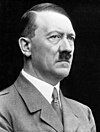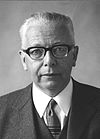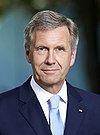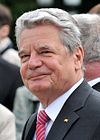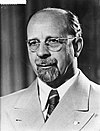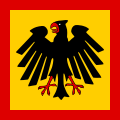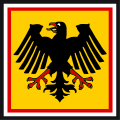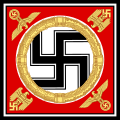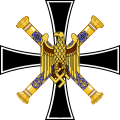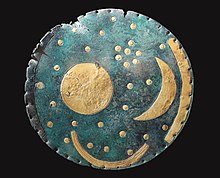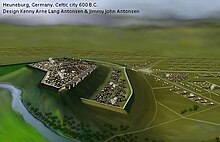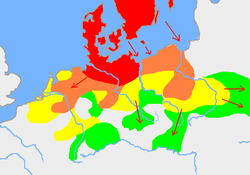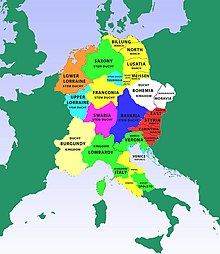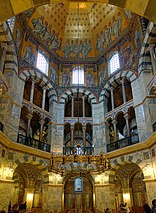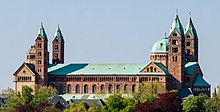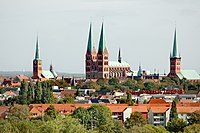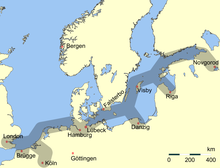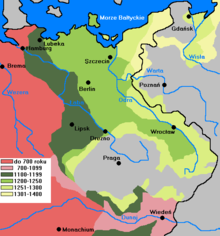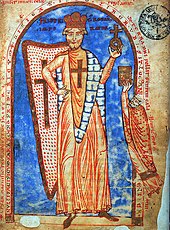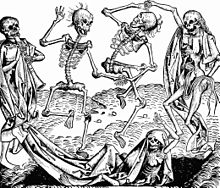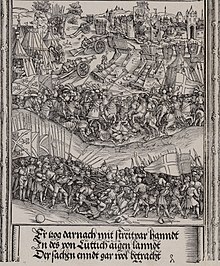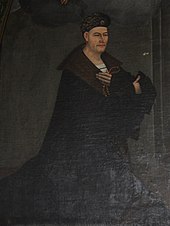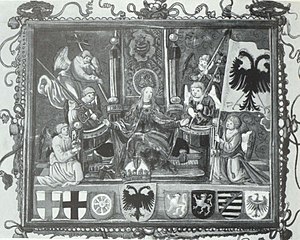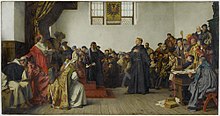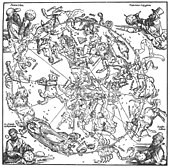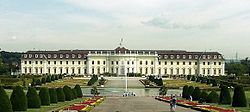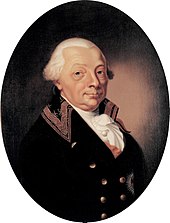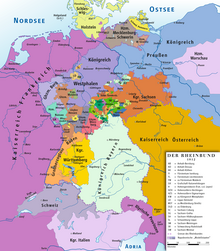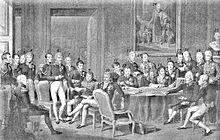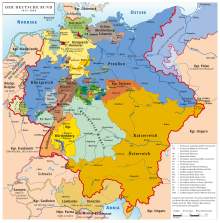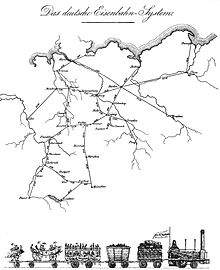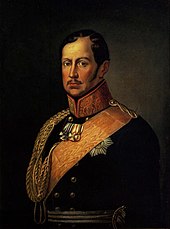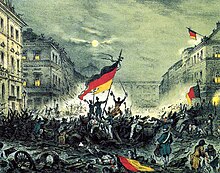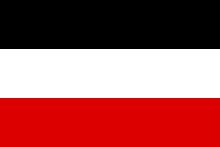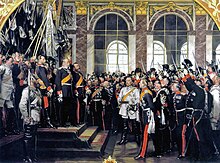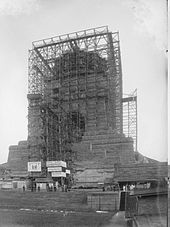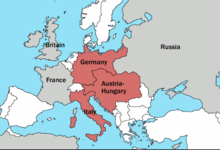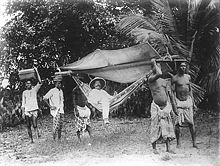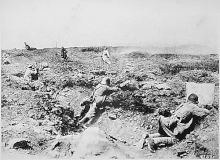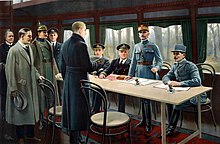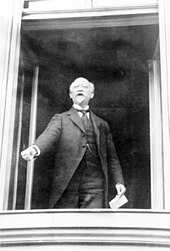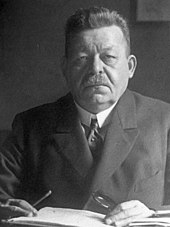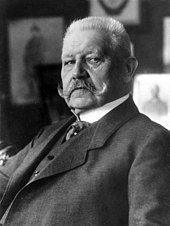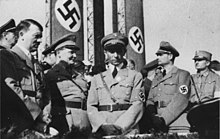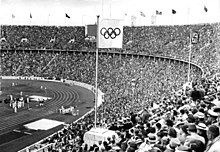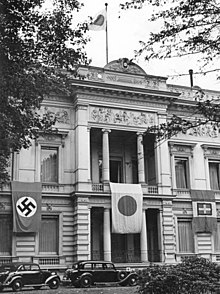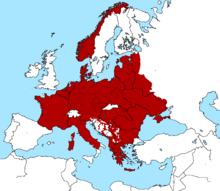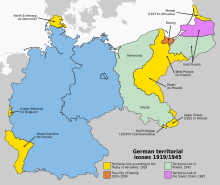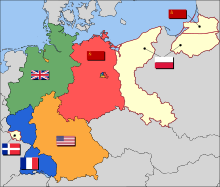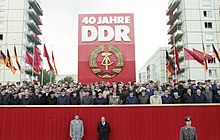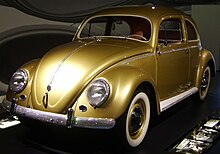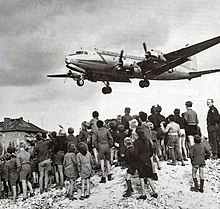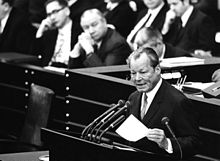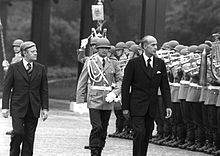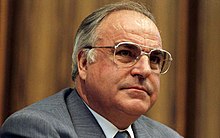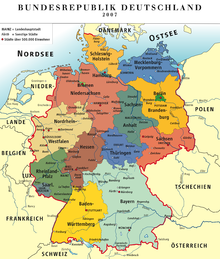From Wikipedia, the free encyclopedia
This is a list of heads of state of Germany.
History[edit]
Germany was ruled by monarchs from the beginning of division of the Frankish Empire in August 843 to the dissolution of the Holy Roman Empire in August 1806.[1][2][3] During most of 19th century, independent German principalities were organized into various confederations, such as the Confederation of the Rhine dominated by Napoleon (1806-1913) and the German Confederation created by the Congress of Vienna (1814-1866). The Prussian-led North German Confederation (1866-1871) subsequently morphed into a modern nation state, the German Reich, which was ruled by emperors from 1871 to the collapse of all German monarchies in 1918.
The President of Germany replaced the monarch in 1919. Chancellor Adolf Hitler assumed the duties of head of state as Führer and Chancellor from 1934 until his suicide in April 1945. In 1949, Germany was divided into two states. The Federal President, head of state of West Germany, became head of state for all of Germany following German reunification in 1990.
East Frankish kingdom, 843–962[edit]
Carolingians[edit]
| Seal/Portrait | Name | House | King | Emperor | Ended | Notes |
|---|---|---|---|---|---|---|

|
Louis the German Ludwig der Deutsche |
Carolingian | 11 August 843 | — | 23 August 876 | Son of Emperor Louis the Pious and grandson of Charlemagne |

|
Carloman (Karlmann) |
Carolingian | 28 August
876 |
— | 22 March 880 | Son of Louis the German; ruled in Bavaria; from 877, also King of Italy |

|
Louis the Younger (Ludwig III. der Jüngere) |
Carolingian | 28 August 876 | — | 20 January 882 | Son of Louis the German; ruled in East Francia, Saxony; from 880, also Bavaria |

|
Charles the Fat (Karl III. der Dicke) |
Carolingian | 28 August 876 | 12 February 881 | 11 November 887 | Son of Louis the German; ruled in Alemannia, Raetia, from 882 in the entire Eastern Kingdom; from 879, also King of Italy |

|
Arnulf of Carinthia (Arnulf von Kärnten) |
Carolingian | 30 November 887 | 25 April 896 | 8 December 899 | Illegitimate son of Carloman |

|
Louis the Child (Ludwig IV. das Kind) |
Carolingian | 21 January 900 | — | 20/24 September 911 | Son of Arnulf of Carinthia |
Conradine dynasty[edit]
| Seal | Name | House | King | Emperor | Ended | Notes |
|---|---|---|---|---|---|---|

|
Conrad I (Konrad I.) |
Conradine (Franconian) | 10 November 911 | — | 23 December 918 | Elected by the nobility |
Ottonian dynasty[edit]
| Seal | Name | House | King | Emperor | Ended | Notes |
|---|---|---|---|---|---|---|

|
Henry I the Fowler (Heinrich I. der Vogler) |
Liudolfing (Saxon) | 23 April 919 | — | 2 July 936 | Elected by the nobility |

|
Arnulf the Bad (Arnulf der Böse, Herzog von Bayern) |
Luitpolding (Bavarian) | 919 | — | 921 | Rival king to Henry I |
Holy Roman Empire, 962–1806[edit]
The title «King of the Romans», used under the Holy Roman Empire, is (from this point onwards) considered equivalent to King of Germany. A king was chosen by the German electors and would then proceed to Rome to be crowned emperor by the pope.
Ottonian dynasty (continued)[edit]
| Image | Name | House | King | Emperor | Ended | Notes |
|---|---|---|---|---|---|---|

|
Otto I the Great (Otto I. der Große) |
Ottonian | 7 August 936 | 2 February 962 | 7 May 973 | Son of Henry I; first king crowned in Aachen Cathedral since Lothair I; crowned as Otto by the grace of God King;[4] crowned Holy Roman Emperor in 961 |

|
Otto II the Red (Otto II.) |
Ottonian | 26 May 961 | 25 December 967 | 7 December 983 | Son of Otto I; Otto by the grace of God King[4] under his father 961–973; also crowned Emperor in his father’s lifetime |

|
Otto III (Otto III.) |
Ottonian | 25 December 983 | 21 May 996 | 21 January 1002 | Son of Otto II; Otto by the grace of God King[4] |

|
Henry II (Heinrich II. der Heilige) |
Ottonian | 7 June 1002 | 26 April 1014 | 13 July 1024 | Great-grandson of Henry I |
Salian dynasty[edit]
| Image | Name | House | King | Emperor | Ended | Notes |
|---|---|---|---|---|---|---|

|
Conrad II (Konrad II.) |
Salian (Frankish) | 8 September 1024 | 26 March 1027 | 4 June 1039 | Great-great-grandson of Otto I |

|
Henry III (Heinrich III.) |
Salian | 14 April 1028 | 25 December 1046 | 5 October 1056 | Son of Conrad II; King (of the Germans?)[4] under his father 1028–1039 |

|
Henry IV (Heinrich IV.) |
Salian | 17 July 1054 | 21 March 1084 | 31 December 1105 | Son of Henry III; King of Germany under his father, 1054–1056 |

|
Rudolf of Rheinfelden (Rudolf von Rheinfelden) |
Rheinfeld | 15 March 1077 | — | 15 October 1080 | Rival king to Henry IV |

|
Hermann of Salm (Hermann von Luxemburg, Graf von Salm) |
Salm | 6 August 1081 | — | 28 September 1088 | Rival king to Henry IV |

|
Conrad (Konrad) |
Salian | 30 May 1087 | — | 27 July 1101 | Son of Henry IV; King of Germany under his father, 1087–1098, King of Italy, 1093–1098, 1095–1101 in rebellion. |

|
Henry V (Heinrich V.) |
Salian | 6 January 1099 | 13 April 1111 | 23 May 1125 | Son of Henry IV; King of Germany under his father, 1099–1105, forced his father to abdicate |
Supplinburger dynasty[edit]
| Image | Name | House | King | Emperor | Ended | Notes |
|---|---|---|---|---|---|---|

|
Lothair III (Lothar III.) |
Supplinburger | 30 August 1125 | 4 June 1133 | 4 December 1137 | He was Lothair II of Germany, but Lothair III of Italy |
Hohenstaufen and Welf dynasties[edit]
| Image | Name | House | King | Emperor | Ended | Notes |
|---|---|---|---|---|---|---|

|
Conrad III (Konrad III.) |
Hohenstaufen | 7 March 1138 | — | 15 February 1152 | Grandson of Henry IV (through his mother); Previously Rival King to Lothair III 1127–1135 |
| Henry Berengar (Heinrich (VI.)) |
Hohenstaufen | 30 March 1147 | — | August? 1150 | Son of Conrad III; King of Germany under his father 1147–1150 |
|

|
Frederick I Barbarossa (Friedrich I. Barbarossa) |
Hohenstaufen | 4 March 1152 | 18 June 1155 | 10 June 1190 | Nephew of Conrad III |

|
Henry VI (Heinrich VI.) |
Hohenstaufen | 15 August 1169 | 14 April 1191 | 28 September 1197 | Son of Frederick I; King of Germany under his father 1169–1190 |

|
Frederick II (Friedrich II.) |
Hohenstaufen | 1197 | — | 1197 | Son of Henry VI; King of Germany under his father, 1196 |

|
Philip of Swabia (Philipp von Schwaben) |
Hohenstaufen | 6 March 1198 | — | 21 August 1208 | Son of Frederick I; rival king to Otto IV |

|
Otto IV (Otto IV. von Braunschweig) |
Welf | 29 March 1198 | 4 October 1209 | 5 July 1215 | Rival king to Philip of Swabia; later opposed by Frederick II; deposed, 1215; died 19 May 1218 |

|
Frederick II (Friedrich II.) |
Hohenstaufen | 5 December 1212 | 22 November 1220 | 26 December 1250 | Son of Henry VI; Rival king to Otto IV until 5 July 1215 |

|
Henry (Heinrich (VII.)) |
Hohenstaufen | 23 April 1220 | — | 15 August 1235 | Son of Frederick II; King of Germany under his father, 1220–1235 |

|
Conrad IV (Konrad IV.) |
Hohenstaufen | May 1237 | — | 1 May 1254 | Son of Frederick II; King of Germany under his father, 1237–1250 |
Interregnum[edit]
| Image | Coat of arms | Name | House | King | Emperor | Ended | Notes |
|---|---|---|---|---|---|---|---|

|

|
Henry Raspe (Heinrich Raspe) |
Thuringia | 22 May 1246 | — | 16 February 1247 | Rival King to Frederick II and great-great-great grandson of Henry IV |

|

|
William of Holland (Wilhelm von Holland) |
Holland | 3 October 1247 | — | 28 January 1256 | Rival King to Frederick II and Conrad IV, 1247–1254 |

|

|
Richard of Cornwall (Richard von Cornwall) |
Plantagenet | 13 January 1257 | — | 2 April 1272 | Brother-in-law of Frederick II; rival king to Alfonso of Castile; held no real authority. |

|

|
Alfonso of Castile (Alfons von Kastilien) |
House of Ivrea | 1 April 1257 | — | 1275 | Grandson of Philip; rival king to Richard of Cornwall; held no authority; later opposed by Rudolf I; relinquished claims 1275, died 1284 |
Changing dynasties[edit]
| Image | Coat of arms | Name | House | King | Emperor | Ended | Notes |
|---|---|---|---|---|---|---|---|

|

|
Rudolf I (Rudolf I. von Habsburg) |
Habsburg | 29 September 1273 | — | 15 July 1291 | First of the Habsburgs |

|

|
Adolf of Nassau (Adolf von Nassau) |
Nassau | 5 May 1292 | — | 23 June 1298 | According to some historians, Adolf’s election was preceded by the short-lived kingship of Conrad, Duke of Teck. See his article for details. |

|

|
Albert I (Albrecht I. von Habsburg) |
Habsburg | 24 June 1298 | — | 1 May 1308 | Son of Rudolf I; Rival king to Adolf of Nassau, 1298 |

|

|
Henry VII (Heinrich VII. von Luxemburg) |
Luxembourg | 27 November 1308 | 13 June 1311 | 24 August 1313 | Holy Roman Emperor |

|

|
Louis IV (Ludwig IV. der Bayer) |
Wittelsbach | 20 October 1314 | 17 January 1328 | 11 October 1347 | Grandson of Rudolf I; rival king to Frederick the Fair, 1314–1322 |

|

|
Frederick the Fair (Friedrich der Schöne) |
Habsburg | 19 October 1314/ 5 September 1325 |
— | 28 September 1322/ 13 January 1330 |
Son of Albert I; rival king to Louis IV, 1314–1322; associate king with Louis IV, 1325–1330 |

|

|
Charles IV (Karl IV. von Luxemburg) |
Luxembourg | 11 July 1346 | 5 April 1355 | 29 November 1378 | Grandson of Henry VII; rival king to Louis IV, 1346–1347; also King of Bohemia, King of Italy and Holy Roman Emperor |

|

|
Günther von Schwarzburg (Günther von Schwarzburg) |
Schwarzburg | 30 January 1349 | — | 24 May 1349 | Rival king to Charles IV |

|

|
Wenceslaus (Wenzel von Böhmen) |
Luxembourg | 10 June 1376 | — | 20 August 1400 | Son of Charles IV; king of Germany under his father 1376–1378; deposed 1400; also by inheritance King of Bohemia; died 1419 |

|

|
Rupert of the Palatinate (Ruprecht von der Pfalz) |
Wittelsbach | 21 August 1400 | — | 18 May 1410 | Great-grandnephew of Louis IV |

|

|
Sigismund (Sigismund von Luxemburg) |
Luxembourg | 20 September 1410 /21 July 1411 |
3 May 1433 | 9 December 1437 | Son of Charles IV |

|

|
Jobst of Moravia (Jobst von Mähren) |
Luxembourg | 1 October 1410 | — | 8 January 1411 | Nephew of Charles IV; rival king to Sigismund |
Habsburg[edit]
| Image | Coat of arms | Name | House | King | Emperor | Ended | Notes |
|---|---|---|---|---|---|---|---|

|

|
Albert II (Albrecht II.) |
Habsburg | 18 March 1438 | — | 27 October 1439 | 4th in descent from Albert I; son-in-law of Sigismund |

|

|
Frederick III (Friedrich III.) |
Habsburg | 2 February 1440 | 16 March 1452 | 19 August 1493 | 4th in descent from Albert I; 2nd cousin of Albert II |

|

|
Maximilian I (Maximilian I.) |
Habsburg | 16 February 1486 | 4 February 1508 | 12 January 1519 | Son of Frederick III; King of Germany under his father, 1486–1493; assumed the title «Elected Emperor» in 1508 with the pope’s approval |

|

|
Charles V (Karl V.) |
Habsburg | 28 June 1519 | 28 June 1519 | 3 August 1556 | Grandson of Maximilian I; died 21 September 1558 |

|

|
Ferdinand I (Ferdinand I.) |
Habsburg | 5 January 1531 | 14 March 1558 | 25 July 1564 | Grandson of Maximilian I; brother of Charles V; King of Germany under his brother Charles V 1531–1556; last king to be crowned in Aachen Cathedral. Emperor |

|

|
Maximilian II (Maximilian II.) |
Habsburg | 22 November 1562 | 25 July 1564 | 12 October 1576 | Son of Ferdinand I; King of Germany under his father 1562–1564 |

|

|
Rudolf II (Rudolf II.) |
Habsburg | 27 October 1575 | 2 November 1576 | 20 January 1612 | Son of Maximilian II; King of Germany under his father, 1575–1576 |

|

|
Matthias (Matthias) |
Habsburg | 13 June 1612 | 13 June 1612 | 20 March 1619 | Son of Maximilian II |

|

|
Ferdinand II (Ferdinand II.) |
Habsburg | 28 August 1619 | 28 August 1619 | 15 February 1637 | Grandson of Ferdinand I |

|

|
Ferdinand III (Ferdinand III.) |
Habsburg | 22 December 1636 | 15 February 1637 | 2 April 1657 | Son of Ferdinand II; King of Germany under his father 1636–1637 |

|

|
Ferdinand IV (Ferdinand IV.) |
Habsburg | 31 May 1653 | — | 9 July 1654 | Son of Ferdinand III; King of Germany under his father |

|

|
Leopold I (Leopold I.) |
Habsburg | 18 July 1658 | 18 July 1658 | 5 May 1705 | Son of Ferdinand III |

|

|
Joseph I (Joseph I.) |
Habsburg | 23 January 1690 | 5 May 1705 | 17 April 1711 | Son of Leopold I; King of Germany under his father 1690–1705 |

|

|
Charles VI (Karl VI.) |
Habsburg | 27 October 1711 | 27 October 1711 | 20 October 1740 | Son of Leopold I |
Wittelsbach[edit]
| Image | Coat of arms | Name | House | King | Emperor | Ended | Notes |
|---|---|---|---|---|---|---|---|

|

|
Charles VII (Karl VII.) |
Wittelsbach | 14 January 1742 | 14 January 1742 | 20 January 1745 | Great-great-grandson of Ferdinand II; Husband of Maria Amalia, daughter of Joseph I |
Habsburg-Lorraine[edit]
| Image | Coat of arms | Name | House | King | Emperor | Ended | Notes |
|---|---|---|---|---|---|---|---|

|

|
Francis I (Franz I.) |
Lorraine | 13 September 1745 | 13 September 1745 | 18 August 1765 | Great-grandson of Ferdinand III; Husband of Maria Theresa, daughter of Charles VI |

|

|
Joseph II (Joseph II.) |
Habsburg-Lorraine | 27 March 1764 | 18 August 1765 | 20 February 1790 | Son of Francis I and Maria Theresa; King of Germany under his father 1764–1765 |

|

|
Leopold II (Leopold II.) |
Habsburg-Lorraine | 30 September 1790 | 30 September 1790 | 1 March 1792 | Son of Francis I and Maria Theresa |

|

|
Francis II (Franz II.) |
Habsburg-Lorraine | 7 July 1792 | 7 July 1792 | 6 August 1806 | Son of Leopold II; Dissolved the Holy Roman Empire; also Emperor of Austria 1804–1835; President of the German Confederation (1815-1835), died 1835 |
Confederation of the Rhine, 1806–1813[edit]
| Name | Portrait | Title | House | Began | Ended |
|---|---|---|---|---|---|
| Napoleon Emperor of the French King of Italy |

|
Protector of the Confederation of the Rhine |  Bonaparte |
12 July 1806 | December 1813 |
| Karl Theodor von Dalberg, Prince-Archbishop of Regensburg Grand Duke of Frankfurt |

|
Prince-primate of the Confederation of the Rhine |
 Dalberg |
25 July 1806 | 26 October 1813 |
| Eugène de Beauharnais, Grand Duke of Frankfurt |

|
Prince-primate of the Confederation of the Rhine |
 Beauharnais |
26 October 1813 | December 1813 |
German Confederation, 1815–1866[edit]
| Name | Portrait | Title | House | Began | Ended |
|---|---|---|---|---|---|
| Francis I, Emperor of Austria (Franz I., Kaiser von Österreich) |

|
Head of the presiding power (Präsidialmacht) Austria[5] |  Habsburg-Lorraine |
20 June 1815 | 2 March 1835 |
| Ferdinand I, Emperor of Austria (Ferdinand I., Kaiser von Österreich) |

|
Head of the presiding power (Präsidialmacht) Austria[5] |  Habsburg-Lorraine |
2 March 1835 | 12 July 1848 |
| Archduke John of Austria (Erzherzog Johann von Österreich) |

|
Regent (Reichsverweser) of the revolutionary German Empire[6] |  Habsburg-Lorraine |
12 July 1848 | 20 December 1849 |
| Frederick William IV, King of Prussia (Friedrich Wilhelm IV., König von Preußen) |

|
Emperor of the Germans elect[7] |  Hohenzollern |
28 March 1849 | 28 April 1849 |
| Presidium of the Union (Unionsvorstand) of the Erfurt Union[8] |
26 May 1849 | 29 November 1850 | |||
| Francis Joseph I, Emperor of Austria (Franz Joseph I., Kaiser von Österreich) |

|
Head of the presiding power (Präsidialmacht) Austria |  Habsburg-Lorraine |
1 May 1850 | 24 August 1866 |
North German Confederation, 1867–1871[edit]
| Name | Portrait | Title | House | Began | Ended |
|---|---|---|---|---|---|
| Wilhelm I, King of Prussia (Wilhelm I, König von Preußen) |
 |
Holder of the Bundespräsidium of the North German Confederation |
 Hohenzollern |
1 July 1867 | 1 January 1871[9] |
German Reich, 1871–1945[edit]
German Emperor, 1871-1918[edit]
| Name | Portrait | Title | House | Began | Ended |
|---|---|---|---|---|---|
| Wilhelm I, German Emperor (Wilhelm I., Deutscher Kaiser) |
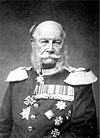 |
German Emperor |  Hohenzollern |
1 January 1871[9] | 9 March 1888 |
| Friedrich III, German Emperor (Friedrich III., Deutscher Kaiser) |
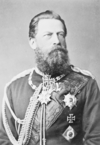 |
German Emperor |  Hohenzollern |
9 March 1888 | 15 June 1888 |
| Wilhelm II, German Emperor (Wilhelm II., Deutscher Kaiser) |
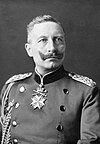 |
German Emperor |  Hohenzollern |
15 June 1888 | 9/28 November 1918[10] |
President, 1919–1945[edit]
† denotes people who died in office.
| Portrait | Reichspräsident | Took office | Left office | Time in office | Party | Election | |
|---|---|---|---|---|---|---|---|
|
|
Friedrich Ebert (1871–1925) |
11 February 1919 | 28 February 1925 † | 6 years, 17 days | SPD | 1919 | |
|
|
Hans Luther (1879–1962) Acting [a] |
28 February 1925 | 12 March 1925 | 12 days | Nonpartisan | – | |
|
|
Walter Simons (1861–1937) Acting [b] |
12 March 1925 | 12 May 1925 | 61 days | Nonpartisan | – | |
|
|
Generalfeldmarschall Paul von Hindenburg (1847–1934) |
12 May 1925 | 2 August 1934 † | 9 years, 82 days | Nonpartisan | 1925 1932 |
|
|
|
Adolf Hitler (1889–1945) Führer und Reichskanzler |
2 August 1934 | 30 April 1945 † | 10 years, 271 days | NSDAP | – | |
|
|
Großadmiral Karl Dönitz (1891–1980) |
30 April 1945 | 23 May 1945 | 23 days | NSDAP | – |
Federal Republic of Germany, from 1949[edit]
† denotes people who died in office.
| Portrait | Bundespräsident | Took office | Left office | Time in office | Party | Election | |
|---|---|---|---|---|---|---|---|
|
|
Theodor Heuss (1884–1963) |
13 September 1949 | 12 September 1959 | 9 years, 364 days | FDP | 1949 1954 |
|
|
|
Heinrich Lübke (1894–1972) |
13 September 1959 | 30 June 1969 (resigned) |
9 years, 290 days | CDU | 1959 1964 |
|
|
|
Gustav Heinemann (1899–1976) |
1 July 1969 | 30 June 1974 | 4 years, 364 days | SPD | 1969 | |
|
|
Walter Scheel (1919–2016) |
1 July 1974 | 30 June 1979 | 4 years, 364 days | FDP | 1974 | |
|
|
Karl Carstens (1914–1992) |
1 July 1979 | 30 June 1984 | 4 years, 365 days | CDU | 1979 | |
|
|
Richard von Weizsäcker (1920–2015) |
1 July 1984 | 30 June 1994 | 9 years, 364 days | CDU | 1984 1989 |
|
|
|
Roman Herzog (1934–2017) |
1 July 1994 | 30 June 1999 | 4 years, 364 days | CDU | 1994 | |
|
|
Johannes Rau (1931–2006) |
1 July 1999 | 30 June 2004 | 4 years, 365 days | SPD | 1999 | |
|
|
Horst Köhler (born 1943) |
1 July 2004 | 31 May 2010 (resigned) |
5 years, 334 days | CDU | 2004 2009 |
|
|
|
Jens Böhrnsen (born 1949) Acting [c] |
31 May 2010 | 30 June 2010 | 30 days | SPD | – | |
|
|
Christian Wulff (born 1959) |
30 June 2010 | 17 February 2012 (resigned) |
1 year, 232 days | CDU | 2010 | |
|
|
Horst Seehofer (born 1949) Acting [c] |
17 February 2012 | 18 March 2012 | 30 days | CSU | – | |
|
|
Joachim Gauck (born 1940) |
18 March 2012 | 18 March 2017 | 5 years, 0 days | Independent | 2012 | |
|
|
Frank-Walter Steinmeier (born 1956) |
18 March 2017 | Incumbent | 6 years, 189 days | SPD | 2017 2022 |
German Democratic Republic (East Germany), 1949–1990[edit]
† denotes people who died in office.
| Portrait | Name | Took office | Left office | Time in office | Party | |
|---|---|---|---|---|---|---|
| President of the Republic Präsident der Republik |
||||||
|
|
Wilhelm Pieck (1876–1960) |
11 October 1949 | 7 September 1960 † | 10 years, 332 days | SED | |
|
|
Johannes Dieckmann (1893–1969) Acting [d] |
7 September 1960 | 12 September 1960 | 5 days | LDPD | |
| Chairman of the State Council Vorsitzender des Staatsrats |
||||||
|
|
Walter Ulbricht (1893–1973) |
12 September 1960 | 1 August 1973 † | 12 years, 323 days | SED | |
|
|
Friedrich Ebert Jr. (1894–1979) Acting [e] |
1 August 1973 | 3 October 1973 | 63 days | SED | |
|
|
Willi Stoph (1914–1999) |
3 October 1973 | 29 October 1976 | 3 years, 26 days | SED | |
|
|
Erich Honecker (1912–1994) |
29 October 1976 | 18 October 1989 (resigned) |
12 years, 354 days | SED | |
|
|
Egon Krenz (born 1937) |
18 October 1989 | 6 December 1989 (resigned) |
49 days | SED | |
|
|
Manfred Gerlach (1928–2011) |
6 December 1989 | 5 April 1990 (office abolished) |
120 days | LDPD | |
| President of the People’s Chamber Präsident der Volkskammer |
||||||
|
|
Sabine Bergmann-Pohl (born 1946) |
5 April 1990 | 2 October 1990 (East Germany joined Federal Republic) |
180 days | CDU |
Styles of the Heads of State[edit]
- Unified state (1871 to 1945)
| Country | Years | Title of Head of State |
|---|---|---|
| 1871–1918 | German Emperor Deutscher Kaiser | |
| 1919–1933 | President of the Reich Reichspräsident | |
| 1933–1934 | President of the Reich Reichspräsident | |
| 1934–1945 | Leader and Chancellor Führer und Reichskanzler | |
| 1945 | President of the Reich Reichspräsident |
- East and West Germany (1949 to 1990)
| Country | Years | Title of Head of State |
|---|---|---|
| 1949–1990 | Federal President Bundespräsident | |
| 1949–1960 | President of the German Democratic Republic Präsident der Deutschen Demokratischen Republik | |
| 1960–1990 | Chairman of the State Council Vorsitzender des Staatsrates | |
| 1990 | President of the People’s Chamber Präsident der Volkskammer |
- Unified state (1990 to present)
| Country | Years | Title of Head of State |
|---|---|---|
| 1990–Present | Federal President Bundespräsident |
Notes[edit]
- ^ Acting head of state, as Chancellor of Germany
- ^ Acting head of state, as President of the Reichsgericht.
- ^ a b Acting head of state, as President of the Bundesrat.
- ^ Acting head of state, as President of the Volkskammer.
- ^ Acting head of state, as Deputy Chairman of the State Council.
References[edit]
- ^ Gowers, Bernard (December 2011). «III The Central Middle Ages (900-1200)». Annual Bulletin of Historical Literature. 95 (1): 12–21. doi:10.1111/j.1467-8314.2011.01248.x. ISSN 0066-3832.
- ^ Arnold, Benjamin (1997). Medieval Germany 500–1300. doi:10.1007/978-1-349-25677-8. ISBN 978-0-333-61092-3.
- ^ The bee and the eagle: Napoleonic France and the end of the Holy Roman Empire, 1806. Forrest, Alan I., Wilson, Peter H. (Peter Hamish). Basingstoke [England]: Palgrave Macmillan. 2009. ISBN 978-0-230-00893-9. OCLC 227575082.
{{cite book}}: CS1 maint: others (link) - ^ a b c d Medieval Europeans: studies in ethnic identity and national perspectives in medieval Europe By Alfred P. Smyth, Palgrave Macmillan (1998), p. 64
- ^ a b Ernst Rudolf Huber: Deutsche Verfassungsgeschichte seit 1789. Vol. I: Reform und Restauration 1789 bis 1830. 2nd edition, Kohlhammer Verlag, Stuttgart [et.al.] 1967, p. 589.
- ^ Ernst Rudolf Huber: Deutsche Verfassungsgeschichte seit 1789. Vol. I: Reform und Restauration 1789 bis 1830. 2nd edition, Kohlhammer Verlag, Stuttgart [et.al.] 1967, p. 625–627, 808.
- ^ Elected Emperor of the Germans by the Frankfurt National Assembly on 28 March 1849, but refused the crown on 28 April 1849.
Manfred Botzenhart: Deutscher Parlamentarismus in der Revolutionszeit 1848–1850. Droste Verlag, Düsseldorf 1977, pp. 697/698. - ^ Anlage II: Additional-Akte zu dem Entwurf der Verfassung des Deutschen Reichs. In: Thüringer Landtag Erfurt (ed.): 150 Jahre Erfurter Unionsparlament (1850–2000) (= Schriften zur Geschichte des Parlamentarismus in Thüringen. H. 15) Wartburg Verlag, Weimar 2000, ISBN 3-86160-515-5, S. 27–44, here pp. 185–187.
- ^ a b Ernst Rudolf Huber: Deutsche Verfassungsgeschichte seit 1789. Band III: Bismarck und das Reich. 3. Auflage, Kohlhammer Verlag, Stuttgart 1988, S. 750/751.
- ^ His abdication was announced by the Chancellor on 9 November, and the Emperor went into exile in the Netherlands. He did not formally abdicate until 28 November.
В этой статье содержится список правителей Германии на протяжении всей её истории. Перечислены плюсы и минусы правителей, их основные достижения, ошибки и неудачи — как зависевшие от их воли, так и связанные с непреодолимыми обстоятельствами.
В настоящее время (с 8 декабря 2021 года) главой Германии является Олаф Шольц, федеральный канцлер.
Королевство Пруссия
В 1701 году с провозглашением Королевства Пруссия состоялось окончательное объединение Пруссии и Бранденбурга. Фридрих III провозгласил себя королём Пруссии, тем самым превратив прусское герцогство в королевство.
Провозглашённое Королевство Пруссия не входило в Священную Римскую империю (именно этот факт и позволил Фридриху провозгласить себя королём Пруссии), однако другие территории, находящиеся под правлением прусского короля, входили в неё, то есть до 1806 года не являлись территориями Королевства Пруссия. Несмотря на это, политическим ядром нового королевства стало именно Бранденбургское княжество со столицей в Берлине, формально ликвидированное лишь в 1806 году с распадом Священной Римской империи. Даже резиденция прусских королей находилась в Берлине, лишь коронации происходили традиционно в Кёнигсберге.
Фридрих I, (1688)1701—1713
Герцог Пруссии в 1688—1701 годах, король Пруссии в 1701—1713 годах.
| Правитель | Достижения и успехи | Ошибки и неудачи |
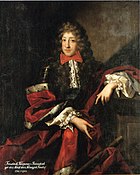 Фридрих I Фридрих I
|
|
|
Фридрих Вильгельм I, 1713—1740
| Правитель | Достижения и успехи | Ошибки и неудачи |
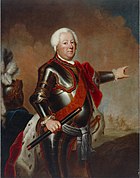 Фридрих Вильгельм I Фридрих Вильгельм I
|
|
|
Фридрих II Великий, 1740—1786
| Правитель | Достижения и успехи | Ошибки и неудачи |
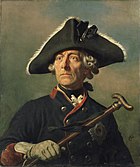 Фридрих II Великий Фридрих II Великий
|
|
|
Фридрих Вильгельм II, 1786—1797
| Правитель | Достижения и успехи | Ошибки и неудачи |
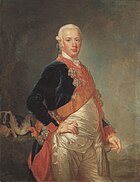 Фридрих Вильгельм II Фридрих Вильгельм II
|
|
|
Фридрих Вильгельм III, 1797—1840
| Правитель | Достижения и успехи | Ошибки и неудачи |
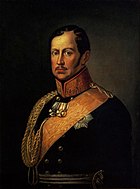 Фридрих Вильгельм III Фридрих Вильгельм III
|
|
|
Фридрих Вильгельм IV, 1840—1861
| Правитель | Достижения и успехи | Ошибки и неудачи |
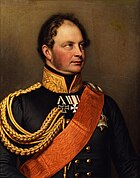 Фридрих Вильгельм IV Фридрих Вильгельм IV
|
|
|
Германская империя
В 1870 году началась Франко-прусская война. Канцлер Пруссии Отто фон Бисмарк и король Вильгельм I надеялись в результате войны объединить Германию и подорвать могущество Франции. Войска Северогерманского союза одержали полную победу. 18 января 1871 года была провозглашена Германская империя, а её кайзером — Вильгельм I. К империи быстро присоединились государства, не входившие в состав Северогерманского союза — Бавария и прочие южногерманские страны.
Вильгельм I, 1861—1888
Король Пруссии с 1861 года, германский император (кайзер) с 1871 года. Первый правитель объединённой Германии.
| Правитель | Достижения и успехи | Ошибки и неудачи |
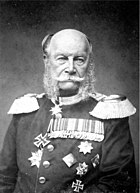 Вильгельм I Вильгельм I
|
|
|
Фридрих III, 9 марта 1888 года — 15 июня 1888 года
| Правитель | Достижения и успехи | Ошибки и неудачи |
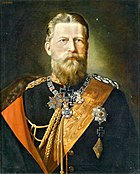 Фридрих III Фридрих III
|
|
|
Вильгельм II, 1888—1918
| Правитель | Достижения и успехи | Ошибки и неудачи |
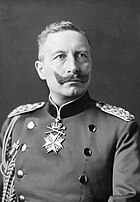 Вильгельм II Вильгельм II
|
|
|
Веймарская республика
Веймарская республика — принятое в историографии наименование Германии в 1918—1933 годах — по созданной после Первой мировой войны в Веймаре Национальным учредительным собранием федеральной республиканской системе государственного управления и принятой там же 11 августа 1919 года новой демократической конституции.
Фридрих Эберт, 1918—1925
Первый рейхсканцлер Германии после Ноябрьской революции 1918 года (как Председатель Совета народных уполномоченных Германии), первый президент Германии (1919—1925), а также первый в истории Германии демократически избранный руководитель государства
| Правитель | Достижения и успехи | Ошибки и неудачи |
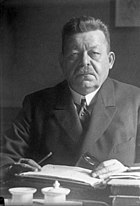 Фридрих Эберт Фридрих Эберт
|
|
|
Пауль фон Гинденбург, 1925—1934
Первый и единственный в истории Германии человек, избранный главой государства на прямых всенародных выборах.
| Правитель | Достижения и успехи | Ошибки и неудачи |
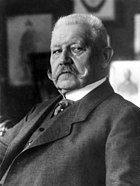 Пауль фон Гинденбург Пауль фон Гинденбург
|
|
|
Третий Рейх
Адольф Гитлер, 1933—1945
Основоположник и центральная фигура национал-социализма, основатель тоталитарной диктатуры Третьего рейха, глава Национал-социалистической немецкой рабочей партии (1921—1945), рейхсканцлер (1933—1945), фюрер и верховный главнокомандующий вооружёнными силами Германии (1934—1945).
Экспансионистская политика Гитлера стала одной из главных причин начала Второй мировой войны в Европе. С его именем связаны многочисленные преступления против человечества, совершённые нацистским режимом как в самой Германии, так и на оккупированных ею территориях, включая Холокост. Международный военный трибунал признал преступными созданные Гитлером организации (СС, Служба безопасности (СД) и гестапо) и само руководство нацистской партии.
| Правитель | Достижения и успехи | Ошибки и неудачи |
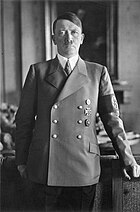 Адольф Гитлер Адольф Гитлер
|
|
|
Карл Дёниц, 30 апреля—23 мая 1945
Перед тем как покончить жизнь самоубийством, Гитлер в политическом завещании от 29 апреля 1945 года назначил Дёница своим преемником на посту рейхспрезидента и верховного главнокомандующего. Став главой страны, 2 мая 1945 года Дёниц выступил с «Воззванием к немецкому народу», в котором сообщил о гибели Адольфа Гитлера и о том, что он стал его преемником, и тогда же сформировал новое правительство Германии во главе с графом Л. Шверином фон Крозигом.
| Правитель | Достижения и успехи | Ошибки и неудачи |
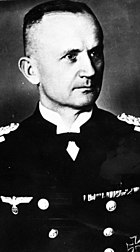 Карл Дёниц Карл Дёниц
|
|
|
Германская Демократическая Республика
ГДР была образована 7 октября 1949 года на месте бывшей советской оккупационной зоны Германии на территории Восточной Германии через четыре года после окончания Второй мировой войны.
ГДР была одним из основных членов социалистического альянса ОВД, вплоть до разрушения Берлинской стены и объединения Германии в 1990 году.
Формальным главой государства являлся президент (до 1960), а затем председатель Государственного совета ГДР. За несколько месяцев до прекращения существования ГДР Госсовет был распущен, а пост президента формально восстановлен, но фактически так и остался вакантным; обязанности президента исполняла председатель Народной палаты ГДР Сабина Бергман-Поль.
Вальтер Ульбрихт, 1950—1971
Несмотря на то, что в 1949 году после образования ГДР Вильгельм Пик стал её первым и единственным президентом и занимал этот пост вплоть до своей смерти в 1960 году, фактически страной управлял Вальтер Ульбрихт, занимавший пост Генерального секретаря ЦК СЕПГ. В 1960 году после смерти Пика занял также пост формального главы государства — председателя Госсовета.
| Правитель | Достижения и успехи | Ошибки и неудачи |
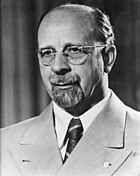 Вальтер Ульбрихт Вальтер Ульбрихт
|
|
|
Эрих Хонеккер, 1971—1989
| Правитель | Достижения и успехи | Ошибки и неудачи |
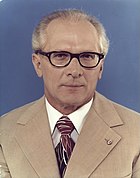 Эрих Хонеккер Эрих Хонеккер
|
|
|
Эгон Кренц, Манфред Герлах и Сабина Бергман-Поль (1989—1990)
| Правитель | Достижения и успехи | Ошибки и неудачи |
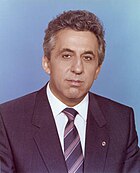 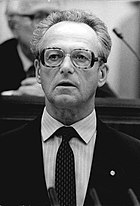  Эгон Кренц (24 октября — 6 декабря 1989), Манфред Герлах (6 декабря 1989 — 5 апреля 1990) и Сабина Бергман-Поль (5 апреля — 3 октября 1990) Эгон Кренц (24 октября — 6 декабря 1989), Манфред Герлах (6 декабря 1989 — 5 апреля 1990) и Сабина Бергман-Поль (5 апреля — 3 октября 1990)
|
|
|
Федеративная Республика Германия
ФРГ была провозглашена 23 мая 1949 года на территориях, расположенных на американской, британской и французской зонах оккупации нацистской Германии (Тризония). По причине оккупации Берлина и придания ему особого статуса столица государства была временно перенесена в провинциальный город Бонн.
В том же году 7 октября в советской зоне оккупации была провозглашена Германская Демократическая Республика (ГДР) со столицей в Берлине (де-факто — лишь в находящейся под контролем ГДР восточной части города). В августе 1961 г. на заседании политбюро Социалистической единой партии Германии (СЕПГ — восточногерманская компартия) и в Совете министров ГДР было принято решение о закрытии границы с Западным Берлином и строительстве Берлинской стены. В течение следующих тридцати лет оба немецких государства существовали параллельно; при этом до начала 1970-х годов власти ФРГ категорически не признавали существования ГДР, а с 1970-х годов встали на путь её частичного признания.
После падения Берлинской стены 9 ноября 1989 года её территория была интегрирована в состав ФРГ в соответствии со статьёй 23 Конституции ФРГ (статья 23 гарантирует всем немецким землям безоговорочное право на вступление в сферу действия этого закона). Одновременно столица была возвращена в Берлин.
Фактическим главой государства является председатель (канцлер) Федерального правительства Германии.
Конрад Аденауэр, 1949—1963
| Правитель | Достижения и успехи | Ошибки и неудачи |
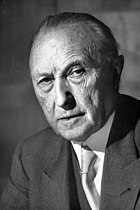 Конрад Аденауэр Конрад Аденауэр
|
|
|
Людвиг Эрхард, 1963—1966
| Правитель | Достижения и успехи | Ошибки и неудачи |
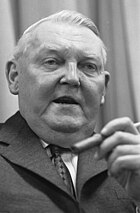 Людвиг Эрхард Людвиг Эрхард
|
|
|
Курт Георг Кизингер, 1966—1969
| Правитель | Достижения и успехи | Ошибки и неудачи |
 Курт Георг Кизингер Курт Георг Кизингер
|
|
|
Вилли Брандт, 1969—1974
| Правитель | Достижения и успехи | Ошибки и неудачи |
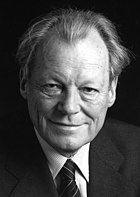 Вилли Брандт Вилли Брандт
|
|
|
Гельмут Шмидт, 1974—1982
Стал единственным канцлером в истории ФРГ, который был смещен с должности путём вынесения ему вотума недоверия.
| Правитель | Достижения и успехи | Ошибки и неудачи |
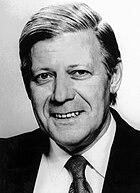 Гельмут Шмидт Гельмут Шмидт
|
|
|
Гельмут Коль, 1982—1998
Находился на посту канцлера 16 лет — дольше всех в истории ФРГ.
| Правитель | Достижения и успехи | Ошибки и неудачи |
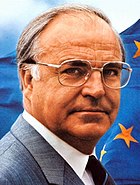 Гельмут Коль Гельмут Коль
|
|
|
Герхард Шрёдер, 1998—2005
| Правитель | Достижения и успехи | Ошибки и неудачи |
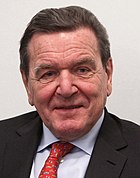 Герхард Шрёдер Герхард Шрёдер
|
|
|
Ангела Меркель, 2005—2021
Первая женщина, избранная на пост канцлера, и первый канцлер после объединения Германии, выросший в бывшей Восточной Германии.
| Правитель | Достижения и успехи | Ошибки и неудачи |
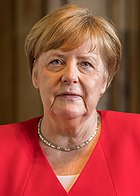 Ангела Меркель Ангела Меркель
|
|
|
Олаф Шольц, 2021—н.в.
| Правитель | Достижения и успехи | Ошибки и неудачи |
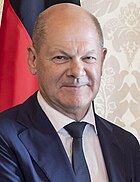 Олаф Шольц Олаф Шольц
|
|
|
Ныне живущие бывшие правители Германии
По состоянию на сегодняшний день живы двое бывших правителей Германии:
| Правитель Германии | Срок полномочий | Дата рождения |
|---|---|---|
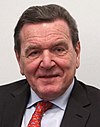 Герхард Шрёдер Герхард Шрёдер |
1998—2005 | 7 апреля 1944 |
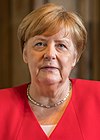 Ангела Меркель Ангела Меркель |
2005—2021 | 17 июля 1954 |
Последним 16 июня 2017 года в возрасте 87 лет скончался Гельмут Коль, президент Германии в 1982—1998 годах[37].
Примечания
- ↑ В «Deutsch-französische Modegeist» 1689 года говорится: «Теперь все должно быть французским: французский язык, французская одежда, французская кухня, посуда, французские танцы, французская музыка и французская болезнь. Гордый, лживый, развратный французский дух совершенно усыпил немцев».
- ↑ Прусское земское уложение состояло из двух частей и заключало в себе права: гражданское, государственное, церковное и уголовное. Оно является вспомогательным правом по отношению к провинциальному и статутарному праву, но в то же время исключает применение обычного права, являющегося по отношению к земскому праву лишь вспомогательным.
- ↑ Впервые Октоберфест состоялся 12 октября 1810 года в честь свадьбы кронпринца Людвига (в будущем король Людвиг I) и принцессы Терезы Саксен-Гильдбурггаузенской (её именем назван луг, где проходит праздник). В честь свадьбы 17 октября также были устроены скачки. По этой причине в разных источниках называется разная дата первого Октоберфеста (12 и 17 октября).
- ↑ Среди сказок были такие всемирно известные как «Бременские музыкант», «Белоснежка», «Гензель и Греттель», «Красная шапочка», «Волк и семеро козлят», «Рапунцель» и многие дргуие.
- ↑ Закончить его они не успели. Вильгельм умер в декабре 1859 года, завершив работу над буквой D; Якоб пережил своего брата почти на четыре года, успев завершить буквы A, B, C и E. Он умер за рабочим столом, работая над словом нем. Frucht (фрукт). Впоследствии продолжен в Гёттингенском университете и Берлинской академии наук. Первое издание было завершено только в 1960 году.
- ↑ Завод проработал с 1873 по 1986 годы, после чего стал эксплуатироваться как индустриальный музей. С 1994 года включён в список Всемирного наследия ЮНЕСКО, став первым в мире промышленным памятником с международным статусом.
- ↑ Германия теряла возможность присоединить немецкие земли Австро-Венгрии.
- ↑ Материковая часть Танзании, Руанда и Бурунди.
- ↑ Современная Намибия.
- ↑ России, неоднократно ранее просившейся в Циндао, в Китае дали гарантии, что она получит преимущественную очередь в случае, если этот порт решено будет сдать иностранцам в аренду.
- ↑ Использовался для проведения Потсдамской конференции (с 17 июля по 2 августа 1945 года).
- ↑ 28 октября 20-летний лейтенант Гюнтер фон Форстнер, во время инструктажа новобранцев в эльзасском городе Цаберн, оскорбительно отозвался о местных жителях; однако полковник привлёк его к ответственности лишь частично, что вызвало протесты среди эльзасцев, в ходе которых несколько десятков горожан были арестованы.
- ↑ Германия передавала Бельгии округа Мальмеди и Эйпен, а также так называемую нейтральную и прусскую части Морене; Польше — Позен (Познань), части Померании (Поморья) и другие территории Западной Пруссии; Мемельская (Клайпедская) область (Мемельланд) передана под управление держав-победительниц (в феврале 1923 года присоединена к Литве).
- ↑ Cерия из трёх вооружённых восстаний поляков и польских силезцев, произошедших в период с 1919 по 1921 годы в Верхней Силезии. Выступления были направлены против немецких властей Веймарской республики и преследовали цель — выйти из состава немецкого государства и слиться со Второй Польской республикой, образованной с окончанием Первой мировой войны.
- ↑ В декабре 1922 года килограмм хлеба стоил около 130 марок, а годом позже — свыше 300 миллиардов. В июле 1923 года золотая марка стоила 262 тысячи бумажных марок, а в ноябре — уже 100 миллиардов.
- ↑ Германия, Италия, Великобритания, Бельгия, Франция, Польша, Чехословакия.
- ↑ Закон отменял гражданские свободы и передавал чрезвычайные полномочия правительству во главе с рейхсканцлером Адольфом Гитлером.
- ↑ Ограничивал личные права и свободы граждан, свободу слова, прессы, собраний и митингов; разрешал просмотр корреспонденции и прослушивание телефонов, обыски и аресты имущества.
- ↑ В то время как в феврале 1933 года в Германии были официально зарегистрированы более 6 млн безработных, в июне 1934 года правительство Гитлера смогло объявить о сокращении их численности до 2,5 млн. В январе 1935 года их было 2,9 млн, в конце августа 1935 года — всего 1,1 млн.
- ↑ К июню 1941 года Германия контролировала большую часть Европы, включая страны-сателлиты — разгром Польши (1939) и Франции (1940), захват Бенилюкса, Дании и Норвегии (1940), Югославии и Греции (1941). В войне против СССР на начальном этапе (летне-осенняя кампания) были оккупированы Белоруссия, Прибалтика и Молдавия, а также значительная часть РСФСР и Украины.
- ↑ Целью сжигания были книги, которые считались подрывными или представляющими идеологию, противоположную нацизму.
- ↑ Согласно этому закону, лица, не соответствующие представлениям о расовой гигиене, подвергались принудительной стерилизации для обеспечения чистоты генофонда немецкого народа и нераспространения «наследственных заболеваний» на следующие поколения. Согласно тексту § 1 закона, наследственными заболеваниями, от которых необходимо защищать генофонд, признавались: врождённое слабоумие, шизофрения, маниакально-депрессивный психоз, наследственная эпилепсия, болезнь Хантингтона, наследственная слепота, наследственная глухота, тяжёлые физические пороки развития, тяжёлые формы алкоголизма. Также принудительной стерилизации должны были быть подвергнуты все оставшиеся в живых лица частично еврейского происхождения, лица частично африканского происхождения, цыгане и ениши.
- ↑ После смерти президента Вильгельма Пика в 1960 году СЕПГ вычеркнула должность президента из конституции. Вместо него был создан коллективный орган государства — Государственный совет. Ульбрихт был назначен его председателем, что приравнивалось к должности президента.
- ↑ Амнистии не подлежали нацисты, военные преступники, «преступники против человечности», шпионы и убийцы.
- ↑ Отличительными чертами периода были низкий уровень инфляции, сокращение количества безработных (до 0,7 %), высокие темпы роста ВВП (до 8 % в год) и значительный рост промышленного производства.
- ↑ Участниками форума в первые 30 лет были военные и политические лидеры государств НАТО, политологи и представители СМИ. С 1990-х годов в конференции участвуют представители России и других стран Восточной Европы (с 1995), Китая, Индии, Японии.
- ↑ Самыми одиозными из них были статс-секретарь канцелярии Ганс Глобке (не член НСДАП, но в 1936 г. комментатор расовых законов (Нюрнбергские законы), лишавших евреев гражданства и других прав) и министр по делам беженцев, переселенцев и пострадавших от войны Теодор Оберлендер, политический руководитель батальона украинских националистов «Нахтигаль».
- ↑ В 2006, 2009 и 2016 годах занимал первое место по медицине среди всех университетов Германии, Австрии и Швейцарии.
- ↑ Эксплуатация в вооружённых силах продолжалась до 2010 года. В некоторых странах используется до сих пор.
- ↑ Членами Боннского соглашения являются Бельгия, Дания, Европейское сообщество, Франция, Германия, Ирландия, Нидерланды, Норвегия, Швеция и Великобритания.
- ↑ Решением Конституционного суда были сняты какие-либо «конституционные возражения» против участия Германии в санкционированных ООН операциях по установлению и поддержанию мира. Германские военнослужащие стали привлекаться к участию в миротворческих операциях за рубежом.
- ↑ По состоянию на 2006 год, в ВС ФРГ несут службу примерно 12 тысяч женщин. Примерно половина из них служит в санитарных частях. Женщины составляют примерно 6,2 % контрактников. В ВМС их доля составляет 8,4 %, в пехоте — 6,9 % и в ВВС — 4,9 %.
- ↑ При правительстве Шрёдера (1998—2005) была поставлена цель провести масштабную конституционную реформу федерализма, чтобы упростить политические процессы в стране, сделать их более прозрачными для населения и менее зависимыми от сиюминутных партийных расчётов. Реформа была призвана перераспределить полномочия между центром и субъектами федерации, уточнить законодательную компетенцию между бундестагом и бундесратом и в итоге повысить дееспособность государства в целом. Число законов, требующих обязательного одобрения бундесрата, планировалось сократить до 35-40 % за счёт изъятия законов о принципах администрирования всех земель из механизма согласования с бундесратом. То есть в будущем земли должны будут исходить из федеральных установок, что предполагает наделение ландтагов большей ответственностью. В марте 2003 года Конвент по проблемам федерализма (в составе глав земельных парламентов и руководителей фракций представленных в них партий) одобрил «Любекское заявление», содержащее конкретные меры по модернизации федеративной системы. 17 октября 2003 года была создана Комиссия по федерализму, куда вошли тогдашний генсек СДПГ Ф. Мюнтеферинг и председатель ХСС и премьер-министр Баварии Э. Штойбер.
- ↑ Медицинское страхование, выплаты по безработице, пенсии.
- ↑ ВВП в 1999—2005 годах вырос всего лишь на 7,5 %. При этом в 2002 и 2003 годах он даже снизился на 0,9 %.
- ↑ Отказ от ядерной энергии и увеличение использования возобновляемых источников энергии.
- ↑ Инициатором выступила партия «Альтернатива для Германии».
- ↑ Der Spiegel назвал этот билет «крупнейшим экспериментом, который Германия когда-либо проводила в своей местной системе общественного транспорта». На август 2022 около 38 миллионов человек воспользовались таким билетом.
- ↑ В нём отражена концепция обеспечения безопасности страны и территории НАТО, в том числе в киберпространстве и космосе, противодействия внешнему влиянию и шпионажу, защиты технологий и объектов критической инфраструктуры, управления во время кризисных ситуаций, пандемий, достижения суверенитета в энергетической и продовольственной сферах.
- ↑ При этом в ноябре она составила 10 %, а в октябре — 10,4 %. Это максимальный уровень с 1951 года, когда инфляция в восстанавливающейся после войны Германии достигала 11 %.
- ↑ Инцидент произошел 1 июня на традиционном мероприятии партии, на котором присутствовали депутаты и сотрудники СДПГ в бундестаге и избирательных округах, а также Олаф Шольц. Не менее восьми присутствовавших на мероприятии женщин пострадали от подмешанных им наркотиков и изнасилования.
|
[ + ] Историософия и геополитика |
||||||||
|---|---|---|---|---|---|---|---|---|
|
Список глав Германии включает руководителей немецкого национального государства с 1867 года (включая период послевоенного разделения страны на восточно- и западногерманское государства).
В Северогерманском союзе впервые был установлен пост федерального президента (нем. Bundespräsident), которым стал король Пруссии. В Германской империи с 1871 по 1918 годы главой государства являлся также прусский король, принявший титул кайзера (первого среди равных федеральных монархов и сенатов свободных городов Гамбурга и Бремена).
В Веймарской республике с 1919 по 1933 годы главой государства являлся рейхспрезидент (нем. Reichspräsident), избираемый национальным собранием. В Третьем рейхе после смерти рейхспрезидента Гинденбурга 2 августа 1934 года официальный титул главы государства стал «фюрер и рейхсканцлер» (объединяя руководство государством и правительством). В ФРГ (с 1949 года) он вновь получил название федерального президента и стал выполнять в основном представительские функции.
В период ноябрьской революции 1918—1919 годов главой государства являлись председатели коллегиальных органов — сначала Исполнительного совета рабочих и солдатских советов Большого Берлина (нем.)русск., позже Центрального совета Германской Социалистической Республики (нем.)русск., наконец учредительного собрания.
Главой ГДР с 1949 по 1960 годы являлся президент, позже до 1990 года — Председатель Государственного совета ГДР, перед объединением Германии в 1990 году должность президента была восстановлена, но его избрание не состоялось.
Содержание
- 1 Северогерманский союз (1867—1871)
- 2 Германская империя (1871—1918)
- 3 Революционный период (1918—1919)
- 4 Веймарская республика (1919—1933)
- 5 Третий рейх (1933—1945)
- 6 Федеративная Республика Германия (с 1949)
- 6.1 Германская Демократическая Республика (1949—1990)
- 7 Диаграмма пребывания в должности
- 8 Штандарты
- 9 См. также
- 10 Примечания
- 11 Ссылки
Северогерманский союз (1867—1871)
Северогерманский союз (нем. Norddeutscher Bund), конфедеративный союз германских государств, стал этапом реализации объединительных стремлений в Германии. После заключения Пражского мира, увенчавшего победу Пруссии в австро-прусской войне 1866 года, некоторые из государств, отклонивших предложенный им Пруссией перед открытием военных действий нейтралитет (Ганновер, Гессен-Кассель, Нассау, вольный город Франкфурт-на-Майне), были прямо присоединены к ней, равно как и Гольштейн и Шлезвиг. Остальные государства Северной Германии (числом 21) 10 августа 1866 года вошли в состав новой федерации, которая, отвергнув принцип союза государств, организовалась в виде союзного государства, руководящая роль в котором была отведена Пруссии. 18 августа 1866 года был подписан союзный договор, объединивший Пруссию и 17 северогерманских государств (осенью присоединились ещё четыре). 12 февраля 1867 года прошли выборы в Конституционный рейхстаг Северо-Германского союза (нем. Wahlgesetz für den konstituierenden Reichstag des Norddeutschen Bundes), 24 февраля он собрался на первое заседание, а 16 апреля принял Северогерманскую федеральную конституцию (нем. Norddeutsche Bundesverfassung), по которой прусскому королю, как федеральному президенту (нем. Bundespräsident), принадлежало право объявлять войну и заключать мир от имени союза, вести дипломатические переговоры, заключать договоры; в качестве главнокомандующего союзной армией он имел право назначать высших офицеров. Он был главою внутреннего управления, назначал главных должностных лиц союза, созывал и распускал рейхстаг.
| № | Федеральный президент | Начало полномочий | Окончание полномочий | |
|---|---|---|---|---|
| 1 | 
|
Вильгельм I (1797—1888) нем. Wilhelm I (урожд. Вильгельм Фридрих Людвиг фон Пройсен нем. Wilhelm Friedrich Ludwig von Preußen) |
1 июля 1867 | 18 января 1871 |
Германская империя (1871—1918)
Герма́нская импе́рия — принятое в российской историографии название немецкого государства в 1871—1918 годах.
Его официальное название в 1871—1945 годах — Deutsches Reich (Германский рейх) — переводится и как «Германская империя», и как «Германское государство» (с 1943 года — Großdeutsches Reich, «Великогерманское государство / империя»). В историографии этот период времени принято делить на Германскую империю (1871—1918), Веймарскую республику (1918—1933) и Третий рейх (нацистскую Германию) (1933—1945).
После победы в франко-прусской войне 1870 года, по итогам которой к Пруссии были присоединены Эльзас и Лотарингия, 18 января 1871 года в Зеркальной галерее Версальского дворца была провозглашена Германская империя, а титул её кайзера принял Вильгельм I. К империи быстро присоединились государства, не входившие в состав Северогерманского союза — королевства Саксония, Бавария и Вюртемберг и прочие южногерманские государства. Германская империя была федерацией; кайзер являлся главой государства и президентом (первым среди равных) федеральных монархов (и сенатов свободных городов Гамбурга и Бремена).
| № | Кайзер | Начало полномочий | Окончание полномочий | |
|---|---|---|---|---|
| (1) | 
|
Вильгельм I (1797—1888) нем. Wilhelm I (урожд. Вильгельм Фридрих Людвиг фон Пройсен нем. Wilhelm Friedrich Ludwig von Preußen) |
18 января 1871 | 9 марта 1888[1] |
| 2 | 
|
Фридрих III (1831—1888) нем. Friedrich III (урожд. Фридрих Вильгельм Николаус Карл фон Пройсен нем. Friedrich Wilhelm Nikolaus Karl von Preußen) |
9 марта 1888 | 15 июня 1888[1] |
| 3 | 
|
Вильгельм II (1859—1941) нем. Wilhelm II (урожд. Фридрих Вильгельм Виктор Альберт фон Пройсен нем. Friedrich Wilhelm Viktor Albert von Preußen) |
15 июня 1888 | 9 ноября 1918[2] |
Революционный период (1918—1919)
Ноя́брьская револю́ция (нем. Novemberrevolution) — революция в ноябре 1918 года в Германской империи, приведшая к установлению в Германии режима парламентской демократии, известного под названием Веймарская республика. Её началом считается восстание матросов в Киле 4 ноября 1918 года, кульминационным моментом — провозглашение республики в полдень 9 ноября, днём формального окончания — 11 августа 1919 года, когда президент республики Фридрих Эберт подписал Веймарскую конституцию.
9 ноября 1918 года рейхсканцлер принц Максимилиан Баденский по собственной инициативе объявил об отречении кайзера от обоих престолов (прусского и имперского) и передал свои полномочия лидеру социал-демократов Фридриху Эберту, который возглавлял большинство в рейхстаге. После этого член правительства Максимилиана Баденского Филипп Шейдеман провозгласил Германию республикой. На следующий день Общее собрание берлинских рабочих и солдатских советов (нем. Vollversammlung der Berliner Arbeiter- und Soldatenräte) избрало временные органы государственной власти — Исполнительный совет рабочих и солдатских советов Большого Берлина (нем.)русск. под председательством Рихарда Мюллера (нем.)русск. и ставший временным правительством Совет народных уполномоченных.
Исполнительный совет рабочих и солдатских советов Большого Берлина, изначально претендовавший на высшую власть в Германии, являясь центром революционной демократии, и продолжавший работать до лета 1919 года, вскоре после формирования Совета народных уполномоченных ограничился руководством созданными в стране советами и не играл существенной роли в государственном управлении.
20 декабря 1918 года начавший работать в декабре первый Всегерманский конгресс рабочих и солдатских советов (нем.)русск. избрал Центральный совет Германской Социалистической Республики (нем.)русск. для надзора за Советом народных уполномоченных, в составе 27 членов, сопредседателями его стали Роберт Лайнерт (нем.)русск., Герман Мюллер и Макс Кохен (нем.)русск..
После состоявшихся 19 января 1919 года выборов, на первом заседании учредительного национального собрания, открывшегося 6 февраля 1919 года, Центральный совет Германской Социалистической Республики сложил перед ним свои полномочия. 10 февраля 1919 года был принят Закон о временной имперской власти, согласно которому главой государства стал рейхспрезидент (нем. Reichspräsident), на следующий день (11 февраля) первым рейхспрезидентом был избран Фридрих Эберт.
| № | Глава государства | Начало полномочий | Окончание полномочий | Партия | |
|---|---|---|---|---|---|
| Председатель Исполнительного совета рабочих и солдатских советов Большого Берлина (нем.)русск. | |||||
| 4 | 
|
Рихард Мюллер (нем.)русск. (1880—1943) нем. Richard Müller |
11 ноября 1918 | 20 декабря 1918 | Независимая социал-демократическая партия Германии |
| Председатели Центрального совета Германской Социалистической Республики (нем.)русск. | |||||
| 5 (а) | 
|
Роберт Лайнерт (нем.)русск. (1873—1940) нем. Robert Leinert |
20 декабря 1918 | 6 февраля 1919 | Социал-демократическая партия Германии |
| 5 (б) | 
|
Герман Мюллер (1876—1931) нем. Hermann Müller |
|||
| 5 (в) | 
|
Макс Коэн (нем.)русск. (1876—1963) нем. Max Cohen |
|||
| Председатель учредительного национального собрания | |||||
| 6 | 
|
Вильгельм Пфаннкух (нем.)русск. (1841—1923) нем. Wilhelm Pfannkuch |
6 февраля 1919[3] | 7 февраля 1919 | Социал-демократическая партия Германии |
| 7 | 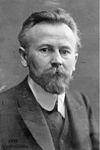
|
Эдуард Генрих Рудольф Давид (1863—1930) нем. Eduard Heinrich Rudolph David |
7 февраля 1919 | 11 февраля 1919 |
Веймарская республика (1919—1933)
После состоявшихся 19 января 1919 года выборов, первое заседание учредительного национального собрания открылось 6 февраля 1919 года.
10 февраля 1919 года был принят Закон о временной имперской власти, согласно которому главой государства стал рейхспрезидент (нем. Reichspräsident), избираемый национальным собранием. На следующий день (11 февраля) первым рейхспрезидентом был избран Фридрих Эберт. В своём окончательном варианте Веймарская конституция была принята Веймарским учредительным собранием 31 июля 1919 года и подписана рейхспрезидентом Фридрихом Эбертом 11 августа.
По ней Германия получила парламентскую демократию с закреплёнными в конституции основными либеральными и социальными правами. Рейхспрезидента, часто сопоставляемого с кайзером, избирали на прямых выборах сроком на семь лет. Он имел право назначать и отправлять в отставку главу правительства (рейхсканцлера), мог с согласия рейхсканцлера объявить в стране чрезвычайное положение, на время которого в стране временно прекращали своё действие основные конституционные права. Возможному сопротивлению этому решению со стороны рейхстага противопоставлялось право рейхспрезидента на роспуск парламента. Это сделало возможной фактическую самоликвидацию демократического строя после назначения рейхспрезидентом Гинденбургом на пост рейхсканцлера Адольфа Гитлера в январе 1933 года.
| № | Рейхспрезидент | Начало полномочий | Окончание полномочий | Партия | Выборы | |
|---|---|---|---|---|---|---|
| 7 | 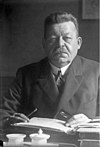
|
Фридрих Эберт (1871—1925) нем. Friedrich Ebert |
11 февраля 1919 | 28 февраля 1925[4] | Социал-демократическая партия Германии | 1919[5] |
| и.о. | 
|
Ганс Лютер (1879—1962) нем. Hans Luther |
28 февраля 1925[6] | 12 марта 1925 | независимый | |
| и.о. | 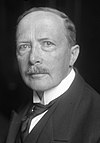
|
Вальтер Симонс (1861—1937) нем. Walter Simons |
12 марта 1925[7] | 12 мая 1925 | ||
| 8 (I—II) |

|
генерал-фельдмаршал Пауль Людвиг Ганс Антон фон Бенекендорф унд фон Гинденбург (1847—1934) нем. Paul Ludwig Hans Anton von Beneckendorff und von Hindenburg |
12 мая 1925 | 10 апреля 1932 | 1925 | |
| 10 апреля 1932 | 2 августа 1934[4] | 1932 |
Третий рейх (1933—1945)
Тре́тий рейх (нем. Drittes Reich — Третья империя, Третья держава) — неофициальное название Германии с 24 марта 1933 года (когда был принят закон «О защите народа и рейха», предоставивший рейхсканцлеру Адольфу Гитлеру чрезвычайные полномочия и основу для создания диктатуры) по 23 мая 1945 года. Первая дата является условной, в части источников в качестве даты основания Третьего рейха используется 30 января 1933 года (назначение Гитлера рейхсканцлером), или 2 августа 1934 года, когда после смерти рейхспрезидента Гинденбурга он стал главой государства (официальный титул — «фюрер и рейхсканцлер»).
Официальное название Германии с 1871 года по 26 июня 1943 года — Deutsches Reich, с 26 июня 1943 по 23 мая 1945 года — Großdeutsches Reich (Великогерманская империя). Слово «рейх», обозначающее земли, подчинённые одной власти, обычно переводится как «государство» или «империя» в зависимости от контекста.
В этот период страна представляла собой тоталитарное государство с однопартийной системой и доминирующей идеологией (национал-социализмом), контролю подвергались все сферы жизни общества. Третий рейх связан с властью Национал-социалистической немецкой рабочей партии под руководством Адольфа Гитлера.
После военного поражения во Второй мировой войне Гитлер покончил с собой 30 апреля 1945 года, передав в своём политическом завещании власть назначенным рейхспрезидентом гроссадмиралу Карлу Дёницу и рейхсканцлером Йозефу Геббельсу. 23 мая 1945 года Карл Дёниц и фленсбургское правительство (названное так по месту своего фактического пребывания в городе Фленсбург недалеко от границы с Данией, пытавшиеся управлять ещё не оккупированной союзниками территорией) были арестованы в соответствии с приказом Верховного главнокомандующего экспедиционными силами союзников генерала армии Эйзенхауэра.
| № | Фюрер и рейхсканцлер (с 30 апреля 1945 рейхспрезидент) |
Начало полномочий | Окончание полномочий | Партия | |
|---|---|---|---|---|---|
| 9 | 
|
Адольф Гитлер (1889—1945) нем. Adolf Hitler |
2 августа 1934 | 30 апреля 1945[8] | Национал-социалистическая немецкая рабочая партия |
| 10 | 
|
гросс-адмирал Карл Дёниц (1891—1980) нем. Karl Dönitz |
30 апреля 1945 | 23 мая 1945[9] | независимый |
Федеративная Республика Германия (с 1949)
Федерати́вная Респу́блика Герма́ния[10] (нем. Bundesrepublik Deutschland) была провозглашена 23 мая 1949 года на территориях, расположенных на американской, британской и французской зонах оккупации нацистской Германии (Тризония). Предполагалось, что впоследствии в её состав войдут и остальные германские территории, что предусматривалось и обеспечивалось специальной статьёй 23 Конституции ФРГ. В том же году 7 октября на территории советской зоны оккупации была провозглашена Германская Демократическая Республика, территория которой 3 октября 1990 года после мирной революции в ГДР была интегрирована в состав ФРГ.
Федеральный президент (глава государства) избирается на 5 лет и выполняет в основном представительские функции. Назначает федерального канцлера (главу правительства).
| № | Федеральный президент | Начало полномочий | Окончание полномочий | Партия | Выборы | |
|---|---|---|---|---|---|---|
| и.о. | 
|
Карл Арнольд (нем.)русск. (1901—1958) нем. Karl Arnold |
7 сентября 1949[11] | 12 сентября 1949 | Христианско-демократический союз Германии | |
| 11 (I—II) |
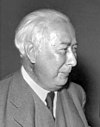
|
Теодор Хойс (1884—1963) нем. Theodor Heuss |
12 сентября 1949 | 17 июля 1954 | Свободная демократическая партия | 1949 (англ.)русск. |
| 17 июля 1954 | 12 сентября 1959 | 1954 (англ.)русск. | ||||
| 12 (I—II) |

|
Карл Генрих Любке (1894—1972) нем. Karl Heinrich Lübke |
13 сентября 1959 | 1 июля 1964 | Христианско-демократический союз Германии | 1959 (англ.)русск. |
| 1 июля 1964 | 30 июня 1969 | 1964 (англ.)русск. | ||||
| 13 | 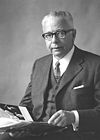
|
Густав Вальтер Хайнеман (1899—1976) нем. Gustav Walter Heinemann |
1 июля 1969 | 30 июня 1974 | Социал-демократическая партия Германии | 1969 (англ.)русск. |
| 14 | 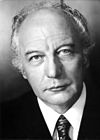
|
Вальтер Шеель (1919—2016) нем. Walter Scheel |
1 июля 1974 | 30 июня 1979 | Свободная демократическая партия | 1974 (англ.)русск. |
| 15 | 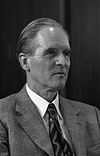
|
Карл Вальтер Клаус Карстенс (1914—1992) нем. Karl Walter Claus Carstens |
1 июля 1979 | 30 июня 1984 | Христианско-демократический союз Германии | 1979 (англ.)русск. |
| 16 (I—II) |

|
Рихард Карл Фрайхерр фон Вайцзеккер (1920—2015) нем. Richard Karl Freiherr von Weizsäcker |
1 июля 1984 | 30 июня 1989 | 1984 (англ.)русск. | |
| 1 июля 1989 | 30 июня 1994 | 1989 (англ.)русск. | ||||
| 17 | 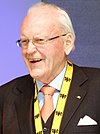
|
Роман Херцог (1934—2017) нем. Roman Herzog |
1 июля 1994 | 30 июня 1999 | 1994 (англ.)русск. | |
| 18 | 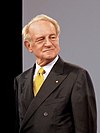
|
Йоханнес Рау (1931—2006) нем. Johannes Rau |
1 июля 1999 | 30 июня 2004 | Социал-демократическая партия Германии | 1999 (англ.)русск. |
| 19 (I—II) |

|
Хорст Кёлер (1943—) нем. Horst Köhler |
1 июля 2004 | 30 июня 2009 | Христианско-демократический союз Германии | 2004 (англ.)русск. |
| 30 июня 2009 | 31 мая 2010[12] | 2009 | ||||
| и.о. | 
|
Йенс Бёрнзен (1949—) нем. Jens Böhrnsen |
31 мая 2010[11] | 30 июня 2010 | Социал-демократическая партия Германии | |
| 20 | 
|
Кристиан Вильгельм Вальтер Вульф (1959—) нем. Christian Wilhelm Walter Wulff |
30 июня 2010 | 17 февраля 2012[12] | Христианско-демократический союз Германии | 2010 (англ.)русск. |
| и.о. | 
|
Хорст Лоренц Зеехофер (1949—) нем. Horst Lorenz Seehofer |
17 февраля 2012[11] | 18 марта 2012 | Христианско-социальный союз в Баварии | |
| 21 | 
|
Йоахим Вильгельм Гаук (1940—) нем. Joachim Wilhelm Gauck |
18 марта 2012 | 18 марта 2017 | независимый | 2012 (англ.)русск. |
| 22 | 
|
Франк-Вальтер Штайнмайер (1956—) нем. Frank-Walter Steinmeier |
18 марта 2017 | действующий | Социал-демократическая партия Германии | 2017 |
Германская Демократическая Республика (1949—1990)
Герма́нская Демократи́ческая Респу́блика (ГДР) (нем. Deutsche Demokratische Republik, DDR) — государство, существовавшее с 7 октября 1949 года до 3 октября 1990 года.
В ходе II-го Немецкого народного конгресса 19 марта 1948 года был выделен постоянно действующий Народный совет. Основной закон Федеративной Республики Германии, принятый 23 мая 1949 года, германские земли Советской оккупационной зоны не признали. 15—16 мая 1949 года в них прошли выборы делегатов III-го Немецкого народного конгресса, который 30 мая 1949 года принял конституцию ГДР, признанную пятью землями Советской зоны оккупации и оформившую их политический союз. 7 октября 1949 года Народный совет провозгласил создание ГДР и сам реорганизовался в Народную палату ГДР.
Выборы в Народную палату и Палату земель первого созыва были назначены на 19 октября 1949 года, до их проведения и формирования Правительства были образованы Временные законодательные органы и Временное правительство, президентом был избран один из сопредседателей Социалистической единой партии Германии Вильгельм Пик. После его смерти 7 сентября 1960 года в конституцию страны были внесены изменения, согласно которым вместо президента был создан коллегиальный Государственный совет ГДР, председатель которого являлся главой государства.
5 апреля 1990 года был упразднён Государственный совет ГДР, до выборов президента ГДР, которые так и не состоялись, исполнять обязанности главы государства стала избранная председателем Народной палаты ГДР Сабина Бергман-Поль.
3 октября 1990 года произошло вхождение ГДР и Западного Берлина в состав ФРГ в соответствии с конституцией ФРГ. На территории ГДР были воссозданы пять новых земель, объединённый Берлин также был провозглашён самостоятельной землёй. Правовую основу для объединения положил Договор об окончательном урегулировании в отношении Германии.
| № | Президент ГДР (с 12 сентября 1960 Председатель Государственного совета ГДР) |
Начало полномочий | Окончание полномочий | Партия | Выборы | |
|---|---|---|---|---|---|---|
| и.о. | 
|
Иоганнес Дикман (1893—1969) нем. Johannes Dieckmann |
7 октября 1949[13] | 11 октября 1949 | Либерально-демократическая партия Германии | |
| А | 
|
Фридрих Вильгельм Рейнхольд Пик (1876—1960) нем. Friedrich Wilhelm Reinhold Pieck |
7 октября 1949 | 7 сентября 1960[14] | Социалистическая единая партия Германии | 1949 1953 1957 |
| и.о. | 
|
Иоганнес Дикман (1893—1969) нем. Johannes Dieckmann |
7 сентября 1960[13] | 12 сентября 1960 | Либерально-демократическая партия Германии | |
| Б | 
|
Вальтер Эрнст Пауль Ульбрихт (1893—1973) нем. Walter Ernst Paul Ulbricht |
12 сентября 1960 | 1 августа 1973[15] | Социалистическая единая партия Германии | |
| и.о. | 
|
Фридрих Эберт (мл.) (1894—1979) нем. Friedrich Ebert |
1 августа 1973[16] | 3 октября 1973 | ||
| В | 
|
Вилли Штоф (1914—1999) нем. Willi Stoph |
3 октября 1973 | 29 октября 1976 | ||
| Г | 
|
Эрих Эрнст Пауль Хонеккер (1912—1994) нем. Erich Ernst Paul Honecker |
29 октября 1976 | 24 октября 1989 | ||
| Д | 
|
Эгон Руди Эрнст Кренц (1937—) нем. Egon Rudi Ernst Krenz |
24 октября 1989 | 6 декабря 1989 | ||
| Е | 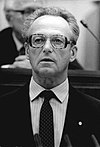
|
Манфред Герлах (1928—2011) нем. Manfred Gerlach |
6 декабря 1989 | 5 апреля 1990 | Либерально-демократическая партия Германии | |
| и.о. | 
|
Сабина Бергман-Поль (1946—) нем. Sabine Bergmann-Pohl |
5 апреля 1990 | 2 октября 1990 | Христианско-демократический союз |
Диаграмма пребывания в должности
- Легенда диаграммы:
- 1 Период монархии
- 2 Революционный период
- 3 Веймарская республика
- 4 Период нацизма
- 5 ФРГ
- 6 ГДР
Штандарты
-
23 сентября 1919 – 1921
-
1921 – 1926
-
1926 – 30 января 1933
-
30 января 1933 – 2 августа 1934
-
2 августа 1934 – 30 апреля 1945
-
30 апреля 1945 – 23 мая 1945
-
11 октября 1949 — 7 сентября 1960 (ГДР)
-
7 сентября 1960 — 2 октября 1990 (ГДР)[17]
-
с 13 сентября 1949 (ФРГ)
См. также
- Федеральный президент Германии
- Рейхспрезидент
- Список монархов Германии
- Правители ГДР
- Список канцлеров Германии
Примечания
- ↑ 1 2 Скончался на престоле.
- ↑ 9 ноября 1918 года состоялось провозглашение Германии республикой. На следующий день Вильгельм II эмигрировал в Нидерланды, где и отрёкся от престола 28 ноября 1918 года.
- ↑ Председательствовал на первом заседании как старейший по возрасту депутат.
- ↑ 1 2 Скончался на посту рейхспрезидента.
- ↑ Проведены учредительным национальным собранием.
- ↑ Исполняющий обязанности рейхспрезидента как рейхсканцлер.
- ↑ Исполняющий обязанности рейхспрезидента как Президент Имперского суда Германии.
- ↑ Покончил с собой.
- ↑ Арестован в соответствии с приказом Верховного главнокомандующего экспедиционными силами союзников генерала армии Эйзенхауэра
- ↑ В советской историографии для обозначения западногерманского государства во времена холодной войны было принято наименование Федеративная Республика Германии — с буквой «и» на конце, явно показывающее, что данное государство является лишь частью Германии.
- ↑ 1 2 3 Исполняющий обязанности федерального президента как председатель бундесрата.
- ↑ 1 2 Подал в отставку.
- ↑ 1 2 Исполняющий обязанности президента ГДР как председатель Народной палаты ГДР.
- ↑ Умер на посту президента ГДР.
- ↑ Умер на посту Председателя Государственного совета ГДР.
- ↑ Исполняющий обязанности Председателя Государственного совета ГДР как заместитель председателя.
- ↑ Штандарт Председателя Государственного Совета ГДР
Ссылки
- Список руководителей Германии (англ.)
В период с 1871 по 2020 гг. за немецкую политику ответственность несли более 30 канцлеров.
Канцлеры Германской империи (1871-1918)
Империя появилась по итогам франко-прусской войны. В ее состав вошли южнонемецкие земли: Вюртемберг, Бавария, Саксония. Исполнительную власть возглавлял рейхсканцлер. Первым из них был назначен князь Отто фон Бисмарк. Полномочия его продолжались до 1890 г. Это очень яркая историческая личность, получившая прозвище «железный канцлер». Он объединил германские народы. Проводил прогрессивные социальные реформы, улучшив за счет этого жизненные условия рабочего класса. Ввел гражданский брак. Он следил, чтобы народы Европы не объединились против немецкого государства. Не принимал колониальную политику.
Бисмарка сменил граф Лео фон Каприви, занимавший пост канцлера до октября 1894. Таможенную политику осуществлял в интересах промышленников, заключив несколько торговых договоров, которые облегчали экспорт изделий промышленности и снижали пошлины на импорт сельскохозяйственных товаров. Это вызвало недовольство среди представителей юнкерства.
После Каприви к власти пришел Хлодвиг цу Гогенлоэ-Шиллингсфюрст, проработавший до октября 1900 года. При нем началось строительство мощнейшего военно-морского флота, что обострило отношения с Великобританией. Внешняя политика была направлена на установление немецкого господства в мире. В Саксонии отменил всеобщее избирательное право. Усиленно германизировал польские национальные меньшинства.
Следующим рейхсканцлером стал граф Бернхард фон Бюлов, покинувший свой пост в июле 1909 года. Продолжил строительство флота. Добивался увеличения военной мощи Германии, чтобы подготовить войну, направленную на передел мира. Когда рабочие устраивали забастовки, он вводил осадное положение и посылал к ним войска. При Бюлове захватывались территории в Тихом океане и Китае, служившие колониями.
Бюлова сменил Теобальд Теодор Фридрих Альфред фон Бетман-Гольвег, который исполнял обязанности канцлера 8 лет. Придерживался либеральных взглядов. Его правительство предоставило земле Эльзас-Лотарингия Конституцию, которая предусматривала организацию парламента. Его политический курс называли «политика Диагонали» и «неоориентация». Во время войны выступал за сплочение партий и классов.
В июле 1917 г. в должность рейхсканцлера вступил юрист Георг Михаэлис, но не справился со своими обязанностями. Отношения с рейхстагом у него не сложились.
С 1 ноября 1917 г. по 3 октября 1918 г. канцлером был философ Георг Фридрих Карл фон Гертлинг. При нем с Россией был подписан Брестский мир.
37 дней должность занимал Максимилиан Баденский. Собрал правительство, в состав которого впервые вошли представители социал-демократов. Его задачей было помириться с союзниками, которые поддерживали Германию в Первой мировой войне, и сохранить монархию. Однако не справился с миссией, и ушел в отставку.
В революционный период кабинет был передан Фридриху Эберту. Пару дней он состоял в должности рейхсканцлера, затем совместно с Хьюго Хаасе – Председателя Совета народных уполномоченных.
Главы правительства Веймарской республики (1919-1933)
В истории Германию в период с 1919 по 1933 гг. принято именовать Веймарской республикой. Официально страна продолжала называться Германское государство. В это время канцлеры зачастую зависели от поддержки президента. Первым главой кабинета был назначен Филипп Шайдеманн, состоявший в должности 127 дней, которая называлась Империальный премьер-министр. Ему приходилось подавлять в стране революционное движение.
Его заменил Густав Бауэр, который с 21 июня по 14 августа 1919 г. оставался премьер-министром, а с 14 августа должность снова стала называться рейхсканцлер. Был подписан Версальский договор. Его правительство приняло закон о рейхском поселении, перераспределившем большие поместья между некрупными фермерами. Подписал законы о выплате расходов на роды. Увеличил пособия по безработице. В марте 1920 г. из-за путча Каппа-Люттвица правительство, возглавляемое Бауэром, вынуждено было уйти в отставку.
После него к власти пришел Герман Мюллер, занимавший пост с марта по июнь 1920 г. Был принят ряд законов о налогах, о социальном обеспечении инвалидов, повышена зарплата государственным служащим.
В июне в результате выборов сформировано новое правительство во главе с Константином Ференбахом. Он прослужил канцлером до мая 1921 года. Новый канцлер должен был обеспечить выполнение условий Версальского договора. Ференбаху удалось добиться снижения сумм репарационных выплат.
Затем кабинет возглавил Карл Йозеф Вирт. Находился в должности до ноября 1922 года. Правительство, которое возглавлял Вирт, заключило с Россией Рапалльский договор. После Версаля это было первое равноправное соглашение.
В ноябре 1922 г. пост перешел к Вильгельму Куно, которого назначил президент Эберт. В январе 1923 г. войска Франции и Бельгии оккупировали Рурские земли. Куно пытался бороться методом «пассивного сопротивления». В бюджете не хватало средств для выплат бастующему региону. Увеличилась инфляция. Правительство Куно подало в отставку.
В августе 1923 г. к обязанностям канцлера приступил Густав Штреземан. Ушел в отставку в конце ноября 1923 года.
После него рейхсканцлером стал юрист, член Центристской партии Вильгельм Маркс. Занять должность ему предложил Эберт. Он возглавлял правительство в период кризисов и конфликтов. В связи с инфляцией 1923 г. введена новая валюта. Процесс сопровождался финансовыми и экономическими проблемами. Канцлер экономил бюджетные деньги, вводил новые налоги, увольнял наемных сотрудников. В его правление был принят план Дауэса, согласно которому размер репарационных выплат Германии соответствовал экономическим возможностям страны.
В январе 1925 г. вместо Маркса по просьбе Фридриха Эберта пришел независимый Ганс Лютер. Его кабинет восстановил суверенитет страны в политике торговли. Заключены торговые договора с Италией, Испанией, Францией, Советским Союзом и Великобританией. Проведена налоговая реформа, в соответствии с которой снижен ряд налогов. Заключен Локарнский договор. Проведено несколько реформ в области социального страхования. 12 мая 1926 г. Лютер добровольно ушел в отставку.
Его преемником снова стал Вильгельм Маркс. Во время второго срока правления Маркса страна вступила в Лигу Наций.
28 июня 1928 г. Герман Мюллер вновь назначен социал-демократами рейхсканцлером. Кабинету, возглавляемому Мюллером, к январю 1930 г. удалось добиться сокращения репарационных платежей в соответствии с Планом Янга. Союзники дали обещание вывести оккупационные войска до мая 1930 г. из Рейнского региона. В 1928 г. создана государственная страховка по безработице. В 1929 г. учредили особую пенсию, предназначенную безработным 60-летнего возраста. В марте 1930 г. президент Пауль фон Гинденбург вынудил Мюллера отправиться в отставку.
30 марта 1930 г. главой правительства назначен член Центристской партии Генрих Брюнинг. При нем, в июле 1930 г. осуществлена эвакуация Рейнской области. В 1931 г. его кабинет добился отсрочки платежей по репарациям сроком на год. В январе 1932 г. выступил с заявлением, что страна не в состоянии осуществлять репарационные выплаты. Брюнинг покинул пост в мае 1932 года.
После него в соответствии с указом президента немецкое правительство возглавил беспартийный политический деятель Франц фон Папен. На Лозаннской конференции, прошедшей летом 1932 г., ему удалось заключить соглашение об отмене репараций в отношении Германии. Папеном был организован переворот Пруссии против социал-демократов. Был уволен Гинденбургом в ноябре 1932 г. в связи с неспособностью обеспечить поддержку в Рейхстаге.
Папена заменил Курт фон Шлейхер, став последним главой правительства Веймарской республики. Эту должность он занимал менее двух месяцев. Занимался перевооружением Германии, однако рейхстаг его не поддержал, и в результате заговора политиков был смещен с поста.
Канцлеры нацистской Германии или Третьего рейха (1933-1945)
Этот исторический период длился с 24 марта 1933 г. по 23 мая 1945 г., и характеризовался диктаторским правлением канцлера. В стране существовал тоталитарный режим, характеризующийся полным контролем всех сфер жизни общества.
Власть в стране была захвачена Адольфом Гитлером, вступившим в должность 30 января 1933 г. Он заложил основы национал-социализма. Главный устроитель Второй мировой войны. В стране была устранена безработица, поддерживались массовые спортивные и культурные мероприятия. Преследовались цыгане и евреи. Восстановлены после Первой мировой войны немецкие вооруженные силы. Гитлером были захвачены многие территории других государств. Когда во время войны Берлин был окружен войсками Советского Союза, Гитлер 30 апреля 1945 г. покончил с собой.
Своим преемником Гитлер назначил Йозефа Геббельса, отслужившего рейхсканцлером всего один день. Не желая подписывать акт о безоговорочной капитуляции Германии, Геббельс 1 мая 1945 г. застрелился.
По поручению президента Карла Дёница 2 мая правительство возглавил беспартийный граф Иоганн Людвиг Шверин фон Крозиг. Его правительство было арестовано 23 мая.
Федеральные канцлеры Федеративной Республики Германии (1949-2020)
В 1949 г. Германия разделилась на два государства: Западная (ФРГ) и Восточная (ГДР). Страну объединили в 1990 г., сохранив наименование Федеративной Республики Германии.
Первым федеральным канцлером, приступившим к своим обязанностям в сентябре, стал Конрад Аденауэр. Финансовая реформа, которую провело правительство Аденауэра, восстановила экономику страны. Этот феномен получил наименование «экономическое чудо». Ему удалось договориться в Москве, чтобы освободили свыше 30 тыс. немецких солдат, попавших в плен. С СССР были установлены дипломатические отношения. Он правил 14 лет, и покинул пост в октябре 1963 г. в возрасте 87 лет.
Аденауэра сменил Людвиг Эрхард, член ХДС (Христианско-демократический союз). Он продолжил политический курс своего предшественника.
Через три года, 1 декабря 1966 г., править стал Курт Георг Кизингер. При нем все системы страны продолжали организованно работать. Жизненный уровень граждан и производство увеличивались. Процент безработных был низким, причем они были обеспечены высокой суммой пособий.
В период с октября 1969 по май 1974 г. федеральным канцлером был Вилли Брандт. Он поставил задачу уменьшить напряжение с другими европейскими странами. Его политическая программа получила название «Остполитик», в рамках которой государство наладило отношения с Югославией, Румынией, Польшей. В Московском соглашении, подписанном в августе 1970 г., закреплен принцип нерушимости границ государств, входящих в состав Европы. В 1971 г. Брандта наградили Нобелевской премией за большую роль в улучшении международных отношений.
После отставки Вилли Брандта 9 дней исполнял обязанности канцлера Уолтер Шил.
В мае 1974 г. руководителем правительства ФРГ был назначен Гельмут Шмидт. Правил он в тяжелое для государства время, что вызвано нефтяным мировым кризисом, который произошел в 1973-1975 гг. С трудностями он справлялся лучше других западных правителей. Показатель безработицы был ниже, чем в других государствах. Поддерживались хорошие отношения с СССР.
Следующим лидером страны, в период с октября 1982 г. по октябрь 1998 г. был Гельмут Коль. Среди канцлеров ФРГ пребывал у власти самый долгий срок (16 лет). Внес большой вклад в установление добрых связей Германии с Россией. Была введена единая европейская валюта. Европейский центральный банк был размещен во Франкфурте-на-Майне. Напрямую участвовал в объединении Германии, за что его прозвали «канцлером единства». После очередных выборов 1991 г. стал первым канцлером объединенной страны.
На выборах, которые прошли в сентябре 1998 г., победила оппозиционная партия, и пост федерального канцлера передали Герхарду Шрёдеру. Правительство под его руководством реализовало реформы, за счет которых Германия стала лидером среди государств Европы. При нем страна вступила в конфликт с США по причине вторжения американцев в Ирак.
Осенью 2005 г. было принято решение отдать пост федерального канцлера Ангеле Меркель, которая в настоящее время является действующим руководителем правительства. Вступила в должность 22 ноября. Это первая женщина-канцлер в истории немецкого государства. Благодаря ей, ФРГ стала одной из первых стран, летом 2009 г. вышедших из глобального кризиса. Германия стала лидером в Европе. Журнал «Forbes» 12 раз признавал Меркель самой влиятельной женщиной мира.
Зимой 2021-го года Шольц Олаф был избран канцлером, получив большинство голосов. Шольц не стал называть Бога при своей инаугурации. В декабре 2021 вступил в должность. Шольц повторял свои уверения, что у ФРГ найдутся деньги для бюджета, чтобы преодолеть последствия кризиса, вызванного эпидемией коронавируса. Результат таких речей – к декабрю 2022-го года бюджетный долг ФРГ может вырасти до четырёхсот млрд. евро. Германия сумеет благодаря росту экономики рассчитаться с “ковидными” долгами, заявлял Олаф. При Шольц Германия отказалась от поставок оружия в Украину, на фоне кризиса дипломатии между США и РФ в 2022 году.
The concept of Germany as a distinct region in Central Europe can be traced to Julius Caesar, who referred to the unconquered area east of the Rhine as Germania, thus distinguishing it from Gaul (France). The victory of the Germanic tribes in the Battle of the Teutoburg Forest (AD 9) prevented annexation by the Roman Empire, although the Roman provinces of Germania Superior and Germania Inferior were established along the Rhine. Following the Fall of the Western Roman Empire, the Franks conquered the other West Germanic tribes. When the Frankish Empire was divided among Charles the Great’s heirs in 843, the eastern part became East Francia. In 962, Otto I became the first Holy Roman Emperor of the Holy Roman Empire, the medieval German state.
The period of the High Middle Ages saw several important developments within the German-speaking areas of Europe. The first was the establishment of the trading conglomerate known as the Hanseatic League, which was dominated by a number of German port cities along the Baltic and North Sea coasts. The second was the growth of a crusading element within German christendom. This led to the establishment of the State of the Teutonic Order along the Baltic coast of what is today Estonia, Latvia, and Lithuania. This crusader state led to the Christianization of these regions, as well as an extension of Germanic culture and language eastward. It would later become the Duchy and Kingdom of Prussia. Also during this period, German Emperors became embroiled in conflicts with the Catholic Church over various political issues, resulting in the Investiture Controversy.
In the Late Middle Ages, the regional dukes, princes, and bishops gained power at the expense of the emperors. Martin Luther led the Protestant Reformation within the Catholic Church after 1517, as the northern and eastern states became Protestant, while most of the southern and western states remained Catholic. The two parts of the Holy Roman Empire clashed in the Thirty Years’ War (1618–1648), which was ruinous to the twenty million civilians living in both parts. The Thirty Years’ War brought tremendous destruction to Germany; more than 1/4 of the population in the German states were killed by the catastrophic war. The estates of the Holy Roman Empire attained a high extent of autonomy in the Peace of Westphalia, some of them being capable of their own foreign policies or controlling land outside of the Empire, the most important being Austria, Prussia, Bavaria, and Saxony. With the French Revolution and the Napoleonic Wars from 1803 to 1815, feudalism fell away by reforms and the dissolution of the Holy Roman Empire. Napoleon instead established the Confederation of the Rhine as his German puppet state. After the French defeat, the German Confederation was established under Austrian presidency. Thereafter liberalism and nationalism clashed with reaction. The German revolutions of 1848–49 failed. The Industrial Revolution modernized the German economy, led to the rapid growth of cities and the emergence of the socialist movement in Germany. Prussia, with its capital Berlin, grew in power. German universities became world-class centers for science and humanities, while music and art flourished. The unification of Germany (excluding Austria and the German-speaking areas of Switzerland) was achieved under the leadership of the Chancellor Otto von Bismarck with the formation of the German Empire in 1871. This resulted in the Kleindeutsche Lösung, («small Germany solution», Germany without Austria), rather than the Großdeutsche Lösung, («greater Germany solution», Germany with Austria). The new Reichstag, an elected parliament, had only a limited role in the imperial government. Germany joined the other powers in colonial expansion in Africa and the Pacific.
By 1900, Germany was the dominant power on the European continent and its rapidly expanding industry had surpassed Britain’s while provoking it in a naval arms race. Germany led the Central Powers in World War I (1914–1918) against the Allied Powers. Defeated and partly occupied, Germany was forced to pay war reparations by the Treaty of Versailles and was stripped of its colonies and significant territory along its borders. The German Revolution of 1918–1919 put an end to the German Empire with the abdication of Wilhelm II on 9 November 1918 and established the Weimar Republic, an ultimately unstable parliamentary democracy. In January 1933, Adolf Hitler, leader of the Nazi Party, used the economic hardships of the Great Depression along with popular resentment over the terms imposed on Germany at the end of World War I to establish a totalitarian regime. This Nazi Germany made racism, especially antisemitism, a central tenet of its policies, and became increasingly aggressive with its territorial demands, threatening war if they were not met. Germany quickly remilitarized, then annexed of Austria and the German-speaking areas of Czechoslovakia in 1938. After seizing the rest of Czechoslovakia, Germany launched an invasion of Poland, which quickly grew into World War II. During the war, the Nazi regime established a systematic genocide program known as the Holocaust which killed 17 million people, including 6 million Jews (representing 2/3rd of the European Jewish population of 1933). Following the Allied invasion of Normandy in June, 1944, the German Army was pushed back on all fronts until the final collapse in May 1945. Under occupation by the Allies, Austria was again made a separate country, denazification efforts took place, large populations under former German-occupied territories were displaced, German territories were split up by the victorious powers. Germany spent the entirety of the Cold War era divided into the NATO-aligned West Germany and Warsaw Pact-aligned East Germany. Germans also fled from Communist areas into West Germany, which experienced rapid economic expansion, and became the dominant economy in Western Europe.
In 1989, the Berlin Wall was opened, the Eastern Bloc collapsed, and East Germany was reunited with West Germany in 1990. The Franco-German friendship became the basis for the political integration of Western Europe in the European Union. In 1998–1999, Germany was one of the founding countries of the eurozone. Germany remains one of the economic powerhouses of Europe, contributing about 1/4 of the eurozone’s annual gross domestic product. In the early 2010s, Germany played a critical role in trying to resolve the escalating euro crisis, especially concerning Greece and other Southern European nations. In 2015, Germany faced the European migrant crisis as the main receiver of asylum seekers from Syria and other troubled regions. With the 2022 Russian invasion of Ukraine; Germany chose to join in solidarity with the EU members and other allies to make decisions against Russia and supporting Ukraine further, Germany also decided to strengthen its armed forces.
Prehistory[edit]
Pre-human ancestors, who were present in Germany over 11 million years ago, are theorized to be among the earliest ones to walk on two legs.[1] The discovery of the Homo heidelbergensis mandible in 1907 affirms archaic human presence in Germany by at least 600,000 years ago.[2] The oldest complete set of hunting weapons ever found anywhere in the world was excavated from a coal mine in Schöningen, Lower Saxony. Between 1994 and 1998, eight 380,000-year-old wooden javelins between 1.82 and 2.25 m (5.97 and 7.38 ft) in length were eventually unearthed.[3][4]
In 1856, the fossilized bones of an extinct human species were salvaged from a limestone grotto in the Neander valley near Düsseldorf, North Rhine-Westphalia. The archaic nature of the fossils, now known to be around 40,000 years old, was recognized and the characteristics published in the first-ever paleoanthropologic species description in 1858 by Hermann Schaaffhausen.[5] The species was named Homo neanderthalensis – Neanderthal man in 1864.
The remains of Paleolithic early modern human occupation uncovered and documented in several caves in the Swabian Jura include various mammoth ivory sculptures that rank among the oldest uncontested works of art and several flutes, made of bird bone and mammoth ivory that are confirmed to be the oldest musical instruments ever found. The 40,000-year-old Löwenmensch figurine represents the oldest uncontested figurative work of art and the 35,000-year-old Venus of Hohle Fels has been asserted as the oldest uncontested object of human figurative art ever discovered.[6][7][8][9] These artefacts are attributed to the Aurignacian culture.
Between 12,900 and 11,700 years ago, north-central Germany was part of the Ahrensburg culture (named for Ahrensburg).
The Nebra sky disc, Unetice culture, c. 1800–1600 BC, featuring the oldest concrete depiction of astronomical phenomena known from anywhere in the world.[10][11][12]
The Celtic city of Heuneburg by the Danube, c. 600 BC, the oldest city north of the Alps.[13]
The first groups of early farmers different from the indigenous hunter-gatherers to migrate into Europe came from a population in western Anatolia at the beginning of the Neolithic period between 10,000 and 8,000 years ago.[14]
Central Germany was one of the primary areas of the Linear Pottery culture (c. 5500 BC to 4500 BC), which was partially contemporary with the Ertebølle culture (c. 5300 BC to 3950 BC) of Denmark and northern Germany. The construction of the Central European Neolithic circular enclosures falls in this time period with the best known and oldest being the Goseck circle, constructed c. 4900 BC. Afterwards, northeastern Germany, along with great parts of Poland and Denmark, was part of the Funnelbeaker culture (c. 4300 BC to 2800 BC). The oldest traces for the use of wheel and wagon ever found are located at a northern German site and date to around 3400 BC.[15]
The settlers of the Corded Ware culture (c. 2900 BC to 2350 BC), that had spread all over the fertile plains of Central Europe during the Late Neolithic were of Indo-European ancestry. The Indo-Europeans had, via mass-migration, arrived into the heartland of Europe around 4,500 years ago.[16]
By the late Bronze Age, the Urnfield culture (c. 1300 BC to 750 BC) had replaced the Bell Beaker, Unetice and Tumulus cultures in central Europe,[17] whilst the Nordic Bronze Age had developed in Scandinavia and northern Germany. The Hallstatt culture, which had developed from the Urnfield culture, was the predominant Western and Central European culture from the 12th to 8th centuries BC and during the early Iron Age (8th to 6th centuries BC). It was followed by the La Tène culture (5th to 1st centuries BC).
The people who had adopted these cultural characteristics are regarded as Celts. How and if the Celts are related to the Urnfield culture remains disputed. However, Celtic cultural centres developed in central Europe during the late Bronze Age (circa 1200 BC until 700 BC). Some, like the Heuneburg, the oldest city north of the Alps,[18] grew to become important cultural centres of the Iron Age in Central Europe, that maintained trade routes to the Mediterranean. In the 5th century BC the Greek historian Herodotus mentioned a Celtic city at the Danube – Pyrene, that historians attribute to the Heuneburg. Beginning around 700 BC (or later), Germanic peoples (Germanic tribes) from southern Scandinavia and northern Germany expanded south and gradually replaced the Celtic peoples in Central Europe.[19][20][21][22][23][24]
Early history: Germanic tribes, Roman conquests, and the Migration Period[edit]
Early migrations, the Suebi and the Roman Republic[edit]
The ethnogenesis of the Germanic tribes remains debated. However, for author Averil Cameron «it is obvious that a steady process» occurred during the Nordic Bronze Age, or at the latest during the Pre-Roman Iron Age[26] (Jastorf culture). From their homes in southern Scandinavia and northern Germany the tribes began expanding south, east and west during the 1st century BC,[27] and came into contact with the Celtic tribes of Gaul, as well as with Iranic,[28] Baltic,[29] and Slavic cultures in Central/Eastern Europe.[30]
Factual and detailed knowledge about the early history of the Germanic tribes is rare. Researchers have to be content with the recordings of the tribes’ affairs with the Romans, linguistic conclusions, archaeological discoveries and the rather new yet auspicious results of archaeogenetic study.[31] In the mid-1st century BC, Republican Roman statesman Julius Caesar erected the first known bridges across the Rhine during his campaign in Gaul and led a military contingent across and into the territories of the local Germanic tribes. After several days and having made no contact with Germanic troops (who had retreated inland) Caesar returned to the west of the river.[32] By 60 BC, the Suebi tribe under chieftain Ariovistus, had conquered lands of the Gallic Aedui tribe to the west of the Rhine. Consequent plans to populate the region with Germanic settlers from the east were vehemently opposed by Caesar, who had already launched his ambitious campaign to subjugate all Gaul. Julius Caesar defeated the Suebi forces in 58 BC in the Battle of Vosges and forced Ariovistus to retreat across the Rhine.[33][34]
Roman settlement of the Rhine[edit]
Augustus, first emperor of the Roman Empire, considered conquest beyond the Rhine and the Danube not only regular foreign policy but also necessary to counter Germanic incursions into a still rebellious Gaul. A series of forts and commercial centers were established along the two rivers. Some tribes, such as the Ubii consequently allied with Rome and readily adopted advanced Roman culture. During the 1st century CE Roman legions conducted extended campaigns into Germania magna, the area north of the Upper Danube and east of the Rhine, attempting to subdue the various tribes. Roman ideas of administration, the imposition of taxes and a legal framework were frustrated by the total absence of an infrastructure. The campaigns of Germanicus, for example were almost exclusively characterized by frequent massacres of villagers and indiscriminate pillaging. The tribes, however maintained their elusive identities. In 9 AD a coalition of tribes under the Cherusci chieftain Arminius, who was familiar with Roman tactical doctrines, defeated a sizeable Roman force in the Battle of the Teutoburg Forest. Consequently, Rome resolved to permanently establish the Rhine/Danube border and refrain from further territorial advance into Germania.[35][36] By AD 100 the frontier along the Rhine and the Danube and the Limes Germanicus was firmly established. Several Germanic tribes lived under Roman rule south and west of the border, as described in Tacitus’s Germania. These lands represent the modern states Baden-Württemberg, southern Bavaria, southern Hesse, Saarland and the Rhineland. Austria formed the regular provinces of Noricum and Raetia.[37][38][39] The provinces Germania Inferior (with the capital situated at Colonia Claudia Ara Agrippinensium, modern Cologne) and Germania Superior (with its capital at Mogontiacum, modern Mainz), were formally established in 85 AD, after long and painful campaigns as lasting military control was confined to the lands surrounding the rivers.[40] Christianity was introduced to Roman controlled western Germania well before the Middle Ages, with Christian religious structures such as the Aula Palatina of Trier built during the reign of Constantine I (r. 306–337 AD).[41]
Migration Period and decline of the Western Roman Empire[edit]
Rome’s Third Century Crisis coincided with the emergence of a number of large West Germanic tribes: the Alamanni, Franks, Bavarii, Chatti, Saxons, Frisii, Sicambri, and Thuringii. By the 3rd century the Germanic speaking peoples began to migrate beyond the limes and the Danube frontier.[42] Several large tribes – the Visigoths, Ostrogoths, Vandals, Burgundians, Lombards, Saxons and Franks – migrated and played their part in the decline of the Roman Empire and the transformation of the old Western Roman Empire.[43] By the end of the 4th century the Huns invaded eastern and central Europe, establishing the Hunnic Empire. The event triggered the Migration Period.[44] Hunnic hegemony over a vast territory in central and eastern Europe lasted until the death of Attila’s son Dengizich in 469.[45] Another pivotal moment in the Migration Period was the Crossing of the Rhine in December of 406 by a large group of tribes including Vandals, Alans and Suebi who settled permanently within the crumbling Western Roman Empire.[46]
Stem duchies and marches[edit]
Depiction of the German stem duchies and principal states in East Francia and the early Holy Roman Empire.
Stem duchies (German: Stammesherzogtümer) in Germany refer to the traditional territory of the various Germanic tribes. The concept of such duchies survived especially in the areas which by the 9th century would constitute East Francia,[47] which included the Duchy of Bavaria, the Duchy of Swabia, the Duchy of Saxony, the Duchy of Franconia and the Duchy of Thuringia,[48] unlike further west the County of Burgundy or Lorraine in Middle Francia.[49]
[50]
The Salian emperors (reigned 1027–1125) retained the stem duchies as the major divisions of Germany, but they became increasingly obsolete during the early high-medieval period under the Hohenstaufen, and Frederick Barbarossa finally abolished them in 1180 in favour of more numerous territorial duchies.
Successive kings of Germany founded a series of border counties or marches in the east and the north. These included Lusatia, the North March (which would become Brandenburg and the heart of the future Prussia), and the Billung March. In the south, the marches included Carniola, Styria, and the March of Austria that would become Austria.
Middle Ages[edit]
Frankish Empire[edit]
The Western Roman Empire fell in 476 with the deposition of Romulus Augustus by the Germanic foederati leader Odoacer, who became the first King of Italy.[51] Afterwards, the Franks, like other post-Roman Western Europeans, emerged as a tribal confederacy in the Middle Rhine-Weser region, among the territory soon to be called Austrasia (the «eastern land»), the northeastern portion of the future Kingdom of the Merovingian Franks. As a whole, Austrasia comprised parts of present-day France, Germany, Belgium, Luxembourg and the Netherlands. Unlike the Alamanni to their south in Swabia, they absorbed large swaths of former Roman territory as they spread west into Gaul, beginning in 250. Clovis I of the Merovingian dynasty conquered northern Gaul in 486 and in the Battle of Tolbiac in 496 the Alemanni tribe in Swabia, which eventually became the Duchy of Swabia.
By 500, Clovis had united all the Frankish tribes, ruled all of Gaul[52] and was proclaimed King of the Franks between 509 and 511.[53] Clovis, unlike most Germanic rulers of the time, was baptized directly into Roman Catholicism instead of Arianism. His successors would cooperate closely with papal missionaries, among them Saint Boniface. After the death of Clovis in 511, his four sons partitioned his kingdom including Austrasia. Authority over Austrasia passed back and forth from autonomy to royal subjugation, as successive Merovingian kings alternately united and subdivided the Frankish lands.[54]
During the 5th and 6th centuries the Merovingian kings conquered the Thuringii (531 to 532), the Kingdom of the Burgundians and the principality of Metz and defeated the Danes, the Saxons and the Visigoths.[55] King Chlothar I (558 to 561) ruled the greater part of what is now Germany and undertook military expeditions into Saxony, while the South-east of what is modern Germany remained under the influence of the Ostrogoths. Saxons controlled the area from the northern sea board to the Harz Mountains and the Eichsfeld in the south.[56]
The Merovingians placed the various regions of their Frankish Empire under the control of semi-autonomous dukes – either Franks or local rulers,[57] and followed imperial Roman strategic traditions of social and political integration of the newly conquered territories.[58][59] While allowed to preserve their own legal systems,[60] the conquered Germanic tribes were pressured to abandon the Arian Christian faith.[61]
In 718 Charles Martel waged war against the Saxons in support of the Neustrians. In 743 his son Carloman in his role as Mayor of the Palace renewed the war against the Saxons, who had allied with and aided the duke Odilo of Bavaria.[62] The Catholic Franks, who by 750 controlled a vast territory in Gaul, north-western Germany, Swabia, Burgundy and western Switzerland, that included the alpine passes allied with the Curia in Rome against the Lombards, who posed a permanent threat to the Holy See.[52] Pressed by Liutprand, King of the Lombards, a Papal envoy for help had already been sent to the de facto ruler Charles Martel after his victory in 732 over the forces of the Umayyad Caliphate at the Battle of Tours, however a lasting and mutually beneficial alliance would only materialize after Charles’ death under his successor Duke of the Franks, Pepin the Short.[63]
In 751 Pippin III, Mayor of the Palace under the Merovingian king, himself assumed the title of king and was anointed by the Church. Pope Stephen II bestowed him the hereditary title of Patricius Romanorum as protector of Rome and St. Peter[64] in response to the Donation of Pepin, that guaranteed the sovereignty of the Papal States. Charles the Great (who ruled the Franks from 774 to 814) launched a decades-long military campaign against the Franks’ heathen rivals, the Saxons and the Avars. The campaigns and insurrections of the Saxon Wars lasted from 772 to 804. The Franks eventually overwhelmed the Saxons and Avars, forcibly converted the people to Christianity, and annexed their lands to the Carolingian Empire.
Foundation of the Holy Roman Empire[edit]
After the death of Frankish king Pepin the Short in 768, his oldest son «Charlemagne» («Charles the Great») consolidated his power over and expanded the Kingdom. Charlemagne ended 200 years of Royal Lombard rule with the Siege of Pavia, and in 774 he installed himself as King of the Lombards. Loyal Frankish nobles replaced the old Lombard aristocracy following a rebellion in 776.[65] The next 30 years of his reign were spent ruthlessly strengthening his power in Francia and on the conquest of the Slavs and Pannonian Avars in the east and all tribes, such as the Saxons and the Bavarians.[66][67] On Christmas Day, 800 AD, Charlemagne was crowned Imperator Romanorum (Emperor of the Romans) in Rome by Pope Leo III.[67]
Fighting among Charlemagne’s three grandsons over the continuation of the custom of partible inheritance or the introduction of primogeniture caused the Carolingian empire to be partitioned into three parts by the Treaty of Verdun of 843.[68] Louis the German received the Eastern portion of the kingdom, East Francia, all lands east of the Rhine river and to the north of Italy. This encompassed the territories of the German stem duchies – Franks, Saxons, Swabians, and Bavarians – that were united in a federation under the first non-Frankish king Henry the Fowler, who ruled from 919 to 936.[69] The royal court permanently moved in between a series of strongholds, called Kaiserpfalzen, that developed into economic and cultural centers. Aachen Palace played a central role, as the local Palatine Chapel served as the official site for all royal coronation ceremonies during the entire Medieval period until 1531.[67][70]
The Holy Roman Empire, maps
Otto the Great[edit]
Equestrian monument, probably Otto the Great, Magdeburg, around 1240
In 936, Otto I was crowned German king at Aachen, in 961 King of Italy in Pavia and crowned emperor by Pope John XII in Rome in 962. The tradition of the German King as protector of the Kingdom of Italy and the Latin Church resulted in the term Holy Roman Empire in the 12th century. The name, that was to identify with Germany continued to be used officially, with the extension added: Nationis Germanicæ (of the German nation) after the last imperial coronation in Rome in 1452 until its dissolution in 1806.[69] Otto strengthened the royal authority by re-asserting the old Carolingian rights over ecclesiastical appointments.[71] Otto wrested from the nobles the powers of appointment of the bishops and abbots, who controlled large land holdings. Additionally, Otto revived the old Carolingian program of appointing missionaries in the border lands. Otto continued to support celibacy for the higher clergy, so ecclesiastical appointments never became hereditary. By granting lands to the abbots and bishops he appointed, Otto actually turned these bishops into «princes of the Empire» (Reichsfürsten).[72] In this way, Otto was able to establish a national church. Outside threats to the kingdom were contained with the decisive defeat of the Hungarian Magyars at the Battle of Lechfeld in 955. The Slavs between the Elbe and the Oder rivers were also subjugated. Otto marched on Rome and drove John XII from the papal throne and for years controlled the election of the pope, setting a firm precedent for imperial control of the papacy for years to come.[73][74]
During the reign of Conrad II’s son, Henry III (1039 to 1056), the empire supported the Cluniac reforms of the Church, the Peace of God, prohibition of simony (the purchase of clerical offices), and required celibacy of priests. Imperial authority over the Pope reached its peak. However, Rome reacted with the creation of the College of Cardinals and Pope Gregory VII’s series of clerical reforms. Pope Gregory insisted in his Dictatus Papae on absolute papal authority over appointments to ecclesiastical offices. The subsequent conflict in which emperor Henry IV was compelled to submit to the Pope at Canossa in 1077, after having been excommunicated came to be known as the Investiture Controversy. In 1122, a temporary reconciliation was reached between Henry V and the Pope with the Concordat of Worms. With the conclusion of the dispute the Roman church and the papacy regained supreme control over all religious affairs.[75][76] Consequently, the imperial Ottonian church system (Reichskirche) declined. It also ended the royal/imperial tradition of appointing selected powerful clerical leaders to counter the Imperial secular princes.[77]
Between 1095 and 1291 the various campaigns of the crusades to the Holy Land took place. Knightly religious orders were established, including the Knights Templar, the Knights of St John (Knights Hospitaller), and the Teutonic Order.[78][79]
The term sacrum imperium (Holy Empire) was first used officially by Friedrich I in 1157,[80] but the words Sacrum Romanum Imperium, Holy Roman Empire, were only combined in July 1180 and would never consistently appear on official documents from 1254 onwards.[81]
Hanseatic League[edit]
Main trading routes of the Hanseatic League
The Hanseatic League was a commercial and defensive alliance of the merchant guilds of towns and cities in northern and central Europe that dominated marine trade in the Baltic Sea, the North Sea and along the connected navigable rivers during the Late Middle Ages ( 12th to 15th centuries ). Each of the affiliated cities retained the legal system of its sovereign and, with the exception of the Free imperial cities, had only a limited degree of political autonomy.[82] Beginning with an agreement of the cities of Lübeck and Hamburg, guilds cooperated in order to strengthen and combine their economic assets, like securing trading routes and tax privileges, to control prices and better protect and market their local commodities. Important centers of commerce within the empire, such as Cologne on the Rhine river and Bremen on the North Sea joined the union, which resulted in greater diplomatic esteem.[83] Recognized by the various regional princes for the great economic potential, favorable charters for, often exclusive, commercial operations were granted.[84] During its zenith the alliance maintained trading posts and kontors in virtually all cities between London and Edinburgh in the west to Novgorod in the east and Bergen in Norway. By the late 14th century the powerful league enforced its interests with military means, if necessary. This culminated in a war with the sovereign Kingdom of Denmark from 1361 to 1370. Principal city of the Hanseatic League remained Lübeck, where in 1356 the first general diet was held and its official structure was announced. The league declined after 1450 due to a number of factors, such as the 15th-century crisis, the territorial lords’ shifting policies towards greater commercial control, the silver crisis and marginalization in the wider Eurasian trade network, among others.[85][86]
Eastward expansion[edit]
The Ostsiedlung (lit. Eastern settlement) is the term for a process of largely uncoordinated immigration and chartering of settlement structures by ethnic Germans into territories, already inhabited by Slavs and Balts east of the Saale and Elbe rivers, such as modern Poland and Silesia and to the south into Bohemia, modern Hungary and Romania during the High Middle Ages from the 11th to the 14th century.[87][88] The primary purpose of the early imperial military campaigns into the lands to the east during the 10th and 11th century, was to punish and subjugate the local heathen tribes. Conquered territories were mostly lost after the troops had retreated, but eventually were incorporated into the empire as marches, fortified borderlands with garrisoned troops in strongholds and castles, who were to ensure military control and enforce the exaction of tributes. Contemporary sources do not support the idea of policies or plans for the organized settlement of civilians.[89]
Emperor Lothair II re-established feudal sovereignty over Poland, Denmark and Bohemia from 1135 and appointed margraves to turn the borderlands into hereditary fiefs and install a civilian administration. There is no discernible chronology of the immigration process as it took place in many individual efforts and stages, often even encouraged by the Slavic regional lords. However, the new communities were subjected to German law and customs. Total numbers of settlers were generally rather low and, depending on who held a numerical majority, populations usually assimilated into each other. In many regions only enclaves would persist, like Hermannstadt, founded by the Transylvanian Saxons in the medieval Hungarian Kingdom(today in Romania) who called on by Geza II. in 1147[Saxons called those part of Transylvania as «Altland» to distinguish it from later immigrant Saxon settlements what established about 1220 by Teutonic Order][90][91]
In 1230, the Catholic monastic order of the Teutonic Knights launched the Prussian Crusade. The campaign, that was supported by the forces of Polish duke Konrad I of Masovia, initially intended to Christianize the Baltic Old Prussians, succeeded primarily in the conquest of large territories. The order, emboldened by imperial approval, quickly resolved to establish an independent state, without the consent of duke Konrad. Recognizing only papal authority and based on a solid economy, the order steadily expanded the Teutonic state during the following 150 years, engaging in several land disputes with its neighbors. Permanent conflicts with the Kingdom of Poland, the Grand Duchy of Lithuania, and the Novgorod Republic, eventually led to military defeat and containment by the mid-15th century. The last Grand Master Albert of Brandenburg converted to Lutheranism in 1525 and turned the remaining lands of the order into the secular Duchy of Prussia.[92][93]
Church and state[edit]
Henry V (1086–1125), great-grandson of Conrad II, who had overthrown his father Henry IV became Holy Roman Emperor in 1111. Hoping to gain greater control over the church inside the Empire, Henry V appointed Adalbert of Saarbrücken as the powerful archbishop of Mainz in the same year. Adalbert began to assert the powers of the Church against secular authorities, that is, the Emperor. This precipitated the «Crisis of 1111» as yet another chapter of the long-term Investiture Controversy.[94] In 1137, the prince-electors turned back to the Hohenstaufen family for a candidate, Conrad III. Conrad tried to divest his rival Henry the Proud of his two duchies—Bavaria and Saxony—that led to war in southern Germany as the empire was divided into two powerful factions. The faction of the Welfs or Guelphs (in Italian) supported the House of Welf of Henry the Proud, which was the ruling dynasty in the Duchy of Bavaria. The rival faction of the Waiblings or Ghibellines (in Italian) pledged allegiance to the Swabian House of Hohenstaufen. During this early period, the Welfs generally maintained ecclesiastical independence under the papacy and political particularism (the focus on ducal interests against the central imperial authority). The Waiblings, on the other hand, championed strict control of the church and a strong central imperial government.[95]
During the reign of the Hohenstaufen emperor Frederick I (Barbarossa), an accommodation was reached in 1156 between the two factions. The Duchy of Bavaria was returned to Henry the Proud’s son Henry the Lion, duke of Saxony, who represented the Guelph party. However, the Margraviate of Austria was separated from Bavaria and turned into the independent Duchy of Austria by virtue of the Privilegium Minus in 1156.[96]
Having become wealthy through trade, the confident cities of Northern Italy, supported by the Pope, increasingly opposed Barbarossa’s claim of feudal rule (Honor Imperii) over Italy. The cities united in the Lombard League and finally defeated Barbarossa in the Battle of Legnano in 1176. The following year a reconciliation was reached between the emperor and Pope Alexander III in the Treaty of Venice.[97] The 1183 Peace of Constance eventually settled that the Italian cities remained loyal to the empire but were granted local jurisdiction and full regal rights in their territories.[98]
In 1180, Henry the Lion was outlawed, Saxony was divided, and Bavaria was given to Otto of Wittelsbach, who founded the Wittelsbach dynasty, which was to rule Bavaria until 1918.
From 1184 to 1186, the empire under Frederick I Barbarossa reached its cultural peak with the Diet of Pentecost held at Mainz and the marriage of his son Henry in Milan to the Norman princess Constance of Sicily.[99] The power of the feudal lords was undermined by the appointment of ministerials (unfree servants of the Emperor) as officials. Chivalry and the court life flowered, as expressed in the scholastic philosophy of Albertus Magnus and the literature of Wolfram von Eschenbach.[100]
Between 1212 and 1250, Frederick II established a modern, professionally administered state from his base in Sicily. He resumed the conquest of Italy, leading to further conflict with the Papacy. In the Empire, extensive sovereign powers were granted to ecclesiastical and secular princes, leading to the rise of independent territorial states. The struggle with the Pope sapped the Empire’s strength, as Frederick II was excommunicated three times. After his death, the Hohenstaufen dynasty fell, followed by an interregnum during which there was no Emperor (1250–1273). This interregnum came to an end with the election of a small Swabian count, Rudolf of Habsburg, as emperor.[101][102]
The failure of negotiations between Emperor Louis IV and the papacy led to the 1338 Declaration at Rhense by six princes of the Imperial Estate to the effect that election by all or the majority of the electors automatically conferred the royal title and rule over the empire, without papal confirmation. As result, the monarch was no longer subject to papal approbation and became increasingly dependent on the favour of the electors. Between 1346 and 1378 Emperor Charles IV of Luxembourg, king of Bohemia, sought to restore imperial authority. The 1356 decree of the Golden Bull stipulated that all future emperors were to be chosen by a college of only seven – four secular and three clerical – electors. The secular electors were the King of Bohemia, the Count Palatine of the Rhine, the Duke of Saxony, and the Margrave of Brandenburg, the clerical electors were the Archbishops of Mainz, Trier, and Cologne.[103]
Between 1347 and 1351 Germany and almost the entire European continent were consumed by the most severe outbreak of the Black Death pandemic. Estimated to have caused the abrupt death of 30 to 60% of Europe’s population, it led to widespread social and economic disruption and deep religious disaffection and fanaticism. Minority groups, and Jews in particular were blamed, singled out and attacked. As a consequence, many Jews fled and resettled in Eastern Europe.[104][105]
Towns and cities[edit]
Total population estimates of the German territories range around 5 to 6 million by the end of Henry III’s reign in 1056 and about 7 to 8 million after Friedrich Barabarossa’s rule in 1190.[106][107] The vast majority were farmers, typically in a state of serfdom under feudal lords and monasteries.[95] Towns gradually emerged and in the 12th century many new cities were founded along the trading routes and near imperial strongholds and castles. The towns were subjected to the municipal legal system. Cities such as Cologne, that had acquired the status of Imperial Free Cities, were no longer answerable to the local landlords or bishops, but immediate subjects of the Emperor and enjoyed greater commercial and legal liberties.[108] The towns were ruled by a council of the – usually mercantile – elite, the patricians. Craftsmen formed guilds, governed by strict rules, which sought to obtain control of the towns; a few were open to women. Society had diversified, but was divided into sharply demarcated classes of the clergy, physicians, merchants, various guilds of artisans, unskilled day labourers and peasants. Full citizenship was not available to paupers. Political tensions arose from issues of taxation, public spending, regulation of business, and market supervision, as well as the limits of corporate autonomy.[109]
Cologne’s central location on the Rhine river placed it at the intersection of the major trade routes between east and west and was the basis of Cologne’s growth.[110] The economic structures of medieval and early modern Cologne were characterized by the city’s status as a major harbor and transport hub upon the Rhine. It was the seat of an archbishop, under whose patronage the vast Cologne Cathedral was built since 1240. The cathedral houses sacred Christian relics and it has since become a well known pilgrimage destination. By 1288 the city had secured its independence from the archbishop (who relocated to Bonn), and was ruled by its burghers.[111]
Towns and cities of the Medieval and Early Modern Holy Roman Empire
Learning and culture[edit]
Benedictine abbess Hildegard von Bingen (1098–1179) wrote several influential theological, botanical, and medicinal texts, as well as letters, liturgical songs, poems, and arguably the oldest surviving morality play, Ordo Virtutum, while supervising brilliant miniature Illuminations. About 100 years later, Walther von der Vogelweide (c. 1170 – c. 1230) became the most celebrated of the Minnesänger, who were Middle High German lyric poets.
Around 1439, Johannes Gutenberg of Mainz, used movable type printing and issued the Gutenberg Bible. He was the global inventor of the printing press, thereby starting the Printing Revolution. Cheap printed books and pamphlets played central roles for the spread of the Reformation and the Scientific Revolution.
Around the transition from the 15th to the 16th century, Albrecht Dürer from Nuremberg established his reputation across Europe as painter, printmaker, mathematician, engraver, and theorist when he was still in his twenties and secured his reputation as one of the most important figures of the Northern Renaissance.
influential German speaking authors, artists and scholars of the Late Middle Ages and the Renaissance
-
Hildegard von Bingen (1098–1179), Benedictine abbess, philosopher, author, artist and visionary naturalist
-
-
Early modern Germany[edit]
- See List of states in the Holy Roman Empire for subdivisions and the political structure
[edit]
Detail of Albrecht Dürer’s Arch of Honour, 1515, printed 1517–18 (The Metropolitan Museum of Art). The scene shows «a new coordinated professional military, which features large-scale infantry, complemented by traditional cavalry, but now supplemented with a newer military weapon resource, portable artillery».[112]
The early-modern European society gradually developed after the disasters of the 14th century as religious obedience and political loyalties declined in the wake of the Great Plague, the schism of the Church and prolonged dynastic wars. The rise of the cities and the emergence of the new burgher class eroded the societal, legal and economic order of feudalism.[113]
Georg Gossembrot, who by 1500 was Emperor Maximilian I’s most important financier and also personal friend. Having become a target of envy, he died in 1502, likely poisoned.[114][115]
The commercial enterprises of the mercantile elites in the quickly developing cities in South Germany (such as Augsburg and Nuremberg), with the most prominent families being the Gossembrots, Fuggers (the wealthiest family in Europe during the fifteenth and sixteenth centuries[116]), Welsers, Hochstetters, Imholts, generated unprecedented financial means. As financiers to both the leading ecclesiastical and secular rulers, these families fundamentally influenced the political affairs in the empire during the fifteenth and sixteenth century.[117][118][119][120] The increasingly money based economy also provoked social discontent among knights and peasants and predatory «robber knights» became common.[121]
From 1438 the Habsburg dynasty, who had acquired control in the south-eastern empire over the Duchy of Austria, Bohemia and Hungary after the death of King Louis II in 1526, managed to permanently occupy the position of the Holy Roman Emperor until 1806 (with the exception of the years between 1742 and 1745).
Some Europe-wide revolutions were born in the Empire: the combination of the first modern postal system established by Maximilian (with the management under the Taxis family) with the printing system invented by Gutenberg produced a communication revolution[122][123][124] – the Empire’s decentralized nature made censorship difficult and this combined with the new communication system to facilitate free expression, thus elevating cultural life. The system also helped the authorities to disseminate orders and policies, boosted the Empire’s coherence in general, and helped reformers like Luther to broadcast their views and communicate with each other effectively, thus contributing to the religious Reformation.[125][126][127]
Maximilian’s military reforms, especially his development of the Landsknechte, caused a military revolution that broke the back of the knight class[128][129] and spread all over Europe shortly after his death.[130][131]
Imperial reform[edit]
Personification of the Reich as Germania, a figure reinvented by Maximilian and his humanists,[132] by Jörg Kölderer, 1512. The «German woman», wearing her hair loose and a crown, sitting on the Imperial throne, corresponds both to the self-image of Maximilian I as King of Germany and the formula Holy Roman Empire of the German Nation (omitting other nations). While usually depicted during the Middle Age as subordinate to both imperial power and Italia or Gallia, she now takes central stage in Maximilian’s Triumphal Procession, being carried in front of Roma.[133][134][135]
During his reign from 1493 to 1519, Maximilian I, in a combined effort with the Estates (who sometimes acted as opponents and sometimes as cooperators to him), his officials and his humanists, reformed the empire. A dual system of Supreme Courts (the Reichskammergericht and the Reichshofrat) was established (with the Reichshofrat playing a more efficient role during the Early Modern period),[136] together with the formalized Reception of Roman Law;[137][138][139][140] the Imperial Diet (Reichstag) became the all-important political forum and the supreme legal and constitutional institution, which would act as a guarantee for the preservation of the Empire in the long run;[141][142] a Permanent Land Piece (Ewiger Landfriede) was declared in 1495 with regional leagues and unions providing the supporting structure, together with the creation of the Reichskreise (Imperial Circles, which would serve the purpose of organize imperial armies, collect taxes and enforce orders of the imperial institutions);[143][144][145] the Imperial and Court Chanceries were combined to become the decisive government institution;[146][147] the Landsknechte that Maximilian created became a form of imperial army;[148] a national political culture began to emerge;[149][150] and the German language began to attain an unified form.[151][152] The political structure remained incomplete and piecemeal though, mainly due to the failure of the Common Penny (an imperial tax) that the Estates resisted.[136][a] Through many compromises between emperor and estates though, a flexible, future-oriented problem-solving mechanism for the Empire was formed, together with a monarchy through which the emperor shared power with the Estates.[154][b] Whether the Reform also equated to a (successful or unsuccessful) nation building process remains a debate.[156]
The addition Nationis Germanicæ (of German Nation) to the emperor’s title appeared first in the 15th century: in a 1486 law decreed by Frederick III and in 1512 in reference to the Imperial Diet in Cologne by Maximilian I. In 1525, the Heilbronn reform plan – the most advanced document of the German Peasants’ War (Deutscher Bauernkrieg) – referred to the Reich as von Teutscher Nation (of German nation). During the fifteen century, the term «German nation» had witness a rise in use due to the growth of a «community of interests». The Estates also increasingly distinguished between their German Reich and the wider, «universal» Reich.[157]
Protestant Reformation[edit]
In order to manage their ever growing expenses, the Renaissance Popes of the 15th and early 16th century promoted the excessive sale of indulgences and offices and titles of the Roman Curia.
In 1517, the monk Martin Luther published a pamphlet with 95 Theses that he posted in the town square of Wittenberg and handed copies to feudal lords. Whether he nailed them to a church door at Wittenberg remains unclear. The list detailed 95 assertions, he argued, represented corrupt practice of the Christian faith and misconduct within the Catholic Church. Although perhaps not Luther’s chief concern, he received popular support for his condemnation of the sale of indulgences and clerical offices, the pope’s and higher clergy’s abuse of power and his doubts of the very idea of the institution of the Church and the papacy.[158]
The Protestant Reformation was the first successful challenge to the Catholic Church and began in 1521 as Luther was outlawed at the Diet of Worms after his refusal to repent. The ideas of the reformation spread rapidly, as the new technology of the modern printing press ensured cheap mass copies and distribution of the theses and helped by the Emperor Charles V’s wars with France and the Turks.[158] Hiding in the Wartburg Castle, Luther translated the Bible into German, thereby greatly contributing to the establishment of the modern German language. This is highlighted by the fact that Luther spoke only a local dialect of minor importance during that time. After the publication of his Bible, his dialect suppressed others and constitutes to a great extent what is now modern German. With the protestation of the Lutheran princes at the Imperial Diet of Speyer in 1529 and the acceptance and adoption of the Lutheran Augsburg Confession by the Lutheran princes beginning in 1530, the separate Lutheran church was established.[159]
The 1524/25 German Peasants’ War, that began in the southwest in Alsace and Swabia and spread further east into Franconia, Thuringia and Austria, was a series of economic and religious revolts of the rural lower classes, encouraged by the rhetoric of various radical religious reformers and Anabaptists against the ruling feudal lords. Although occasionally assisted by war-experienced noblemen like Götz von Berlichingen and Florian Geyer (in Franconia) and the theologian Thomas Müntzer (in Thuringia), the peasant forces lacked military structure, skill, logistics and equipment and as many as 100,000 insurgents were eventually defeated and massacred by the territorial princes.[160]
The Catholic Counter-Reformation, initiated in 1545 at the Council of Trent was spearheaded by the scholarly religious Jesuit order, that was founded just five years prior by several clerics around Ignatius of Loyola. Its intent was to challenge and contain the Protestant Reformation via apologetic and polemical writings and decrees, ecclesiastical reconfiguration, wars and imperial political maneuverings. In 1547, emperor Charles V defeated the Schmalkaldic League, a military alliance of Protestant rulers.[161] The 1555 Peace of Augsburg decreed the recognition of the Lutheran Faith and religious division of the empire. It also stipulated the ruler’s right to determine the official confession in his principality (Cuius regio, eius religio). The Counter-Reformation eventually failed to reintegrate the central and northern German Lutheran states. In 1608/1609 the Protestant Union and the Catholic League were formed.
Thirty Years’ War, 1618–1648[edit]
The 1618 to 1648 Thirty Years’ War, that took place almost exclusively in the Holy Roman Empire has its origins, which remain widely debated, in the unsolved and recurring conflicts of the Catholic and Protestant factions. The Catholic emperor Ferdinand II attempted to achieve the religious and political unity of the empire, while the opposing Protestant Union forces were determined to defend their religious rights. The religious motive served as the universal justification for the various territorial and foreign princes, who over the course of several stages joined either of the two warring parties in order to gain land and power.[162][163]
The conflict was sparked by the revolt of the Protestant nobility of Bohemia against emperor Matthias’ succession policies. After imperial triumph at the Battle of White Mountain and a short-lived peace, the war grew to become a political European conflict by the intervention of King Christian IV of Denmark from 1625 to 1630, Gustavus Adolphus of Sweden from 1630 to 1648 and France under Cardinal Richelieu from 1635 to 1648. The conflict increasingly evolved into a struggle between the French House of Bourbon and the House of Habsburg for predominance in Europe, for which the central German territories of the empire served as the battleground.[164]
The war ranks among the most catastrophic in history as three decades of constant warfare and destruction had left the land devastated. Marauding armies incessantly pillaged the countryside, seized and levied heavy taxes on cities and indiscriminately plundered the food stocks of the peasantry. There were also the countless bands of murderous outlaws, sick, homeless, disrupted people and invalid soldiery. Overall social and economic disruption caused a dramatic decline in population as a result of pandemic murder and random rape and killings, endemic infectious diseases, crop failures, famine, declining birth rates, wanton burglary, witch-hunts and the emigration of terrified people. Estimates vary between a 38% drop from 16 million people in 1618 to 10 million by 1650 and a mere 20% drop from 20 million to 16 million. The Altmark and Württemberg regions were especially hard hit, where it took generations to fully recover.[162][165]
The war was the last major religious struggle in mainland Europe and ended in 1648 with the Peace of Westphalia. It resulted in increased autonomy for the constituent states of the Holy Roman Empire, limiting the power of the emperor. Most of Alsace was ceded to France, Western Pomerania and Bremen-Verden were given to Sweden as Imperial fiefs, and the Netherlands officially left the Empire.[166]
Culture and literacy[edit]
The population of Germany reached about twenty million people by the mid-16th century, the great majority of whom were peasant farmers.[168]
The Protestant Reformation was a triumph for literacy and the new printing press.[169][c][171][172] Luther’s translation of the Bible into High German (the New Testament was published in 1522; the Old Testament was published in parts and completed in 1534) was a decisive impulse for the increase of literacy of literacy in early modern Germany,[167] and stimulated printing and distribution of religious books and pamphlets. From 1517 onward religious pamphlets flooded Germany and much of Europe. The Reformation instigated a media revolution as by 1530 over 10,000 individual works are published with a total of ten million copies. Luther strengthened his attacks on Rome by depicting a «good» against «bad» church. It soon became clear that print could be used for propaganda in the Reformation for particular agendas. Reform writers used pre-Reformation styles, clichés, and stereotypes and changed items as needed for their own purposes.[173] Especially effective were Luther’s Small Catechism, for use of parents teaching their children, and Larger Catechism, for pastors.[174] Using the German vernacular they expressed the Apostles’ Creed in simpler, more personal, Trinitarian language. Illustrations in the newly translated Bible and in many tracts popularized Luther’s ideas. Lucas Cranach the Elder (1472–1553), the great painter patronized by the electors of Wittenberg, was a close friend of Luther, and illustrated Luther’s theology for a popular audience. He dramatized Luther’s views on the relationship between the Old and New Testaments, while remaining mindful of Luther’s careful distinctions about proper and improper uses of visual imagery.[175]
Luther’s translation of the Bible into High German was also decisive for the German language and its evolution from Early New High German to Modern Standard German.[167] The publication of Luther’s Bible was a decisive moment in the spread of literacy in early modern Germany,[167] and promoted the development of non-local forms of language and exposed all speakers to forms of German from outside their own area.[176]
Science[edit]
The Northern Hemisphere of the Celestial Globe created by Albrecht Dürer.
Notable late fifteenth to early eighteenth-century polymaths include: Johannes Trithemius, one of the founder of modern cryptography, founder of steganography, as well as bibliography and literary studies as branches of knowledge;[177][178][179] Conrad Celtes, the first and foremost German cartographic writer and «the greatest lyric genius and certainly the greatest organizer and popularizer of German Humanism»;[180][181][182][183] Athanasius Kircher, described by Fletcher as «a founder figure of various disciplines—of geology (certainly vulcanology), musicology (as a surveyor of musical forms), museum curatorship, Coptology, to name a few—and might be claimed today as the first theorist of gravity and a long-term originator of the moving pictures (with his magic lantern shows). Through his many enthusiasms, moreover, he was the conduit of others’ pursuits in the rapidly widening horizon of knowledge that marks the later Renaissance.»;[184] and Gottfried Wilhelm Leibniz, one of the greatest, if not the greatest «Universal genius», of all times.[185][186]
Cartography developed strongly, with the center being Nuremberg, at the beginning of the sixteenth century. Martin Waldseemüller and Matthias Ringmann’s Universalis Cosmographia and the 1513 edition of Geography marked the climax of a cartography revolution.[187][188] The emperor himself dabbled in cartography.[189]
In 1515, Johannes Stabius (court astronomer under Maximilian I), Albrecht Dürer and the astronomer Konrad Heinfogel produced the first planispheres of both southern and northerns hemispheres, also the first printed celestial maps. These maps prompted the revival of interest in the field of uranometry throughout Europe.[190][191][192][193]
Astronomer Johannes Kepler from Weil der Stadt was one of the pioneering minds of empirical and rational research. Through rigorous application of the principles of the Scientific method he construed his laws of planetary motion. His ideas influenced contemporary Italian scientist Galileo Galilei and provided fundamental mechanical principles for Isaac Newton’s theory of universal gravitation.[194]
Scientists, scholars and artists of the Early modern period in Germany
Colonies[edit]
German Colonies in the Americas existed because the Free Imperial Cities of Augsburg and Nuremberg got colonial rights in the Province of Venezuela or North of South America in return for debts owed by the Holy Roman Empire Charles V, who was also King of Spain. In 1528, Charles V issued a charter by which the Welser family possessed the rights to explore, rule and colonize the area, also with the motivation of searching for the legendary golden city of El Dorado.[195] Their principal colony was Klein-Venedig. A never realized colonial project was Hanauish-Indies intended by Friedrich Casimir, Count of Hanau-Lichtenberg as a fief of the Dutch West India Company. The project failed due to a lack of funds and the outbreak of the Franco-Dutch War in 1672.
1648–1815[edit]
Rise of Prussia[edit]
Prussia became a European great power after 1763 and Austria’s greatest rival in Germany
Frederick William, ruler of Brandenburg-Prussia since 1640 and later called the Great Elector, acquired East Pomerania via the Peace of Westphalia in 1648. He reorganized his loose and scattered territories and managed to throw off the vassalage of Prussia under the Kingdom of Poland during the Second Northern War.[196] In order to address the demographic problem of Prussia’s largely rural population of about three million, he attracted the immigration and settlement of French Huguenots in urban areas. Many became craftsmen and entrepreneurs.[197] King Frederick William I, known as the Soldier King, who reigned from 1713 to 1740, established the structures for the highly centralized Prussian state and raised a professional army, that was to play a central role.[198] He also successfully operated a command economy that some historians consider mercantilist.[199][200]
The total population of Germany (in its 1914 territorial extent) grew from 16 million in 1700 to 17 million in 1750 and reached 24 million in 1800. The 18th-century economy noticeably profited from widespread practical application of the Scientific method as greater yields and a more reliable agricultural production and the introduction of hygienic standards positively affected the birth rate – death rate balance.[201]
Wars[edit]
Louis XIV of France waged a series of successful wars in order to extend the French territory. He occupied Lorraine (1670) and annexed the remainder of Alsace (1678–1681) that included the free imperial city of Straßburg. At the start of the Nine Years’ War, he also invaded the Electorate of the Palatinate (1688–1697).[202] Louis established a number of courts whose sole function was to reinterpret historic decrees and treaties, the Treaties of Nijmegen (1678) and the Peace of Westphalia (1648) in particular in favor of his policies of conquest. He considered the conclusions of these courts, the Chambres de réunion as sufficient justification for his boundless annexations. Louis’ forces operated inside the Holy Roman Empire largely unopposed, because all available imperial contingents fought in Austria in the Great Turkish War. The Grand Alliance of 1689 took up arms against France and countered any further military advances of Louis. The conflict ended in 1697 as both parties agreed to peace talks after either side had realized, that a total victory was financially unattainable. The Treaty of Ryswick provided for the return of the Lorraine and Luxembourg to the empire and the abandoning of French claims to the Palatinate.[203]
After the last-minute relief of Vienna from a siege and the imminent seizure by a Turkish force in 1683, the combined troops of the Holy League, that had been founded the following year, embarked on the military containment of the Ottoman Empire and reconquered Hungary in 1687.[204] The Papal States, the Holy Roman Empire, the Polish–Lithuanian Commonwealth, the Republic of Venice and since 1686 Russia had joined the league under the leadership of Pope Innocent XI. Prince Eugene of Savoy, who served under emperor Leopold I, took supreme command in 1697 and decisively defeated the Ottomans in a series of spectacular battles and
manoeuvres. The 1699 Treaty of Karlowitz marked the end of the Great Turkish War and Prince Eugene continued his service for the Habsburg monarchy as president of the War Council. He effectively ended Turkish rule over most of the territorial states in the Balkans during the Austro-Turkish War of 1716–18. The Treaty of Passarowitz left Austria to freely establish royal domains in Serbia and the Banat and maintain hegemony in Southeast Europe, on which the future Austrian Empire was based.[205][206]
Enlightened absolutism[edit]
Frederick II «the Great» is best known for his military genius and unique utilisation of the highly organized army to make Prussia one of the great powers in Europe as well as escaping from almost certain national disaster at the last minute. He was also an artist, author and philosopher, who conceived and promoted the concept of enlightened absolutism.[207][208]
Austrian empress Maria Theresa succeeded in bringing about a favorable conclusion for her in the 1740 to 1748 war for recognition of her succession to the throne. However, Silesia was permanently lost to Prussia as a consequence of the Silesian Wars and the Seven Years’ War. The 1763 Treaty of Hubertusburg ruled that Austria and Saxony had to relinquish all claims to Silesia. Prussia, that had nearly doubled its territory was eventually recognized as a great European power with the consequence that the politics of the following century were fundamentally influenced by German dualism, the rivalry of Austria and Prussia for supremacy in Central Europe.[209]
The concept of enlightened absolutism, although rejected by the nobility and citizenry, was advocated in Prussia and Austria and implemented since 1763. Prussian king Frederick II defended the idea in an essay and argued that the benevolent monarch simply is the first servant of the state, who effects his absolute political power for the benefit of the population as a whole. A number of legal reforms (e.g. the abolition of torture and the emancipation of the rural population and the Jews), the reorganization of the Prussian Academy of Sciences, the introduction of compulsory education for boys and girls and promotion of religious tolerance, among others, caused rapid social and economic development.[210]
During 1772 to 1795 Prussia instigated the partitions of Poland by occupying the western territories of the former Polish–Lithuanian Commonwealth. Austria and Russia resolved to acquire the remaining lands with the effect that Poland ceased to exist as a sovereign state until 1918.[211]
Smaller states[edit]
Karl Friedrich ruled Baden from 1738 to 1811
The smaller German states were overshadowed by Prussia and Austria. Bavaria had a rural economy. Saxony was in economically good shape, although numerous wars had taken their toll. During the time when Prussia rose rapidly within Germany, Saxony was distracted by foreign affairs. The House of Wettin concentrated on acquiring and then holding on to the Polish throne which was ultimately unsuccessful.[212][clarification needed]
Many of the smaller states of Germany were run by bishops, who in reality were from powerful noble families and showed scant interest in religion. While none of the later ecclesial rulers reached the outstanding reputation of Mainz’ Johann Philipp von Schönborn or Münster’s Christoph Bernhard von Galen, some of them promoted Enlightenment like the benevolent and progressive Franz Ludwig von Erthal in Würzburg and Bamberg.[213]
In Hesse-Kassel, the Landgrave Frederick II, ruled from 1760 to 1785 as an enlightened despot, and raised money by renting soldiers (called «Hessians») to Great Britain to help fight the American Revolutionary War. He combined Enlightenment ideas with Christian values, cameralist plans for central control of the economy, and a militaristic approach toward diplomacy.[214]
Hanover did not have to support a lavish court—its rulers were also kings of England and resided in London. George III, elector (ruler) from 1760 to 1820, never once visited Hanover. The local nobility who ran the country opened the University of Göttingen in 1737; it soon became a world-class intellectual center. Baden sported perhaps the best government of the smaller states. Karl Friedrich ruled well for 73 years (1738–1811) and was an enthusiast for the Enlightenment; he abolished serfdom in 1783.[215]
The smaller states failed to form coalitions with each other, and were eventually overwhelmed by Prussia who swallowed up many of them between 1807 and 1871.[216]
[edit]
Prussia underwent major social change between the mid-17th and mid-18th centuries as the nobility declined as the traditional aristocracy struggled to compete with the rising merchant class,[217] which developed into a new Bourgeoisie middle class,[218][219][220] while the emancipation of the serfs granted the rural peasantry land purchasing rights and freedom of movement,[221] and a series of agrarian reforms in northwestern Germany abolished feudal obligations and divided up feudal land, giving rise to wealthier peasants and paved the way for a more efficient rural economy.[222]
Enlightenment[edit]
Since the mid-18th century recognition and application of Enlightenment ideas, higher cultural, intellectual and spiritual standards have led to higher quality works of art in music, philosophy, science and literature. Philosopher Christian Wolff (1679–1754) was a pioneering author on a near universal number of Enlightenment rationality topics in Germany and established German as the language of philosophic reasoning, scholarly instruction and research.[223]
In 1685, Margrave Frederick William of Prussia issued the Edict of Potsdam within a week after French king Louis XIV’s Edict of Fontainebleau, that decreed the abolishment of the 1598 concession to free religious practice for Protestants. Frederick William offered his co-religionists, who are oppressed and assailed for the sake of the Holy Gospel and its pure doctrine…a secure and free refuge in all Our Lands.[224] Around 20,000 Huguenot refugees arrived in an immediate wave and settled in the cities, 40% in Berlin, the ducal residence alone. The French Lyceum in Berlin was established in 1689 and the French language had by the end of the 17th century replaced Latin to be spoken universally in international diplomacy. The nobility and the educated middle-class of Prussia and the various German states increasingly used the French language in public conversation in combination with universal cultivated manners. Like no other German state, Prussia had access to and the skill set for the application of pan-European Enlightenment ideas to develop more rational political and administrative institutions.[225] The princes of Saxony carried out a comprehensive series of fundamental fiscal, administrative, judicial, educational, cultural and general economic reforms. The reforms were aided by the country’s strong urban structure and influential commercial groups, who modernized pre-1789 Saxony along the lines of classic Enlightenment principles.[226]
Johann Gottfried von Herder (1744–1803) broke new ground in philosophy and poetry, as a leader of the Sturm und Drang movement of proto-Romanticism. Weimar Classicism («Weimarer Klassik») was a cultural and literary movement based in Weimar that sought to establish a new humanism by synthesizing Romantic, classical, and Enlightenment ideas. The movement, from 1772 until 1805, involved Herder as well as polymath Johann Wolfgang von Goethe (1749–1832) and Friedrich Schiller (1759–1805), a poet and historian. Herder argued that every folk had its own particular identity, which was expressed in its language and culture. This legitimized the promotion of German language and culture and helped shape the development of German nationalism. Schiller’s plays expressed the restless spirit of his generation, depicting the hero’s struggle against social pressures and the force of destiny.[227]
German music, sponsored by the upper classes, came of age under composers Johann Sebastian Bach (1685–1750), Joseph Haydn (1732–1809), and Wolfgang Amadeus Mozart (1756–1791).[228]
Königsberg philosopher Immanuel Kant (1724–1804) tried to reconcile rationalism and religious belief, individual freedom, and political authority. Kant’s work contained basic tensions that would continue to shape German thought – and indeed all of European philosophy – well into the 20th century.[229][230] The ideas of the Enlightenment and their implementation received general approval and recognition as principal cause for widespread cultural progress.[231]
French Revolution, 1789–1815[edit]
German reaction to the French Revolution was mixed at first. German intellectuals celebrated the outbreak, hoping to see the triumph of Reason and The Enlightenment. The royal courts in Vienna and Berlin denounced the overthrow of the king and the threatened spread of notions of liberty, equality, and fraternity. By 1793, the execution of the French king and the onset of the Terror disillusioned the Bildungsbürgertum (educated middle classes). Reformers said the solution was to have faith in the ability of Germans to reform their laws and institutions in peaceful fashion.[232]
Europe was racked by two decades of war revolving around France’s efforts to spread its revolutionary ideals, and the opposition of reactionary royalty. War broke out in 1792 as Austria and Prussia invaded France, but were defeated at the Battle of Valmy (1792). The German lands saw armies marching back and forth, bringing devastation (albeit on a far lower scale than the Thirty Years’ War, almost two centuries before), but also bringing new ideas of liberty and civil rights for the people. Prussia and Austria ended their failed wars with France but (with Russia) partitioned Poland among themselves in 1793 and 1795.
French consulate suzereignity[edit]
France took control of the Rhineland, imposed French-style reforms, abolished feudalism, established constitutions, promoted freedom of religion, emancipated Jews, opened the bureaucracy to ordinary citizens of talent, and forced the nobility to share power with the rising middle class. Napoleon created the Kingdom of Westphalia (1807–1813) as a model state.[233] These reforms proved largely permanent and modernized the western parts of Germany. When the French tried to impose the French language, German opposition grew in intensity. A Second Coalition of Britain, Russia, and Austria then attacked France but failed. Napoleon established direct or indirect control over most of western Europe, including the German states apart from Prussia and Austria. The old Holy Roman Empire was little more than a farce; Napoleon simply abolished it in 1806 while forming new countries under his control. In Germany Napoleon set up the «Confederation of the Rhine», comprising most of the German states except Prussia and Austria.[234]
Imperial French suzereignity[edit]
Under Frederick William II’s weak rule (1786—1797) Prussia had undergone a serious economic, political and military decline. His successor king Frederick William III tried to remain neutral during the War of the Third Coalition and French emperor Napoleon’s dissolution of the Holy Roman Empire and reorganisation of the German principalities. Induced by the queen and a pro-war party Frederick William joined the Fourth Coalition in October 1806. Napoleon easily defeated the Prussian army at the Battle of Jena and occupied Berlin. Prussia lost its recently acquired territories in western Germany, its army was reduced to 42,000 men, no trade with Britain was allowed and Berlin had to pay Paris high reparations and fund the French army of occupation. Saxony changed sides to support Napoleon and joined the Confederation of the Rhine. Ruler Frederick Augustus I was rewarded with the title of king and given a part of Poland taken from Prussia, which became known as the Duchy of Warsaw.[235]
After Napoleon’s military fiasco in Russia in 1812, Prussia allied with Russia in the Sixth Coalition. A series of battles followed and Austria joined the alliance. Napoleon was decisively defeated in the Battle of Leipzig in late 1813. The German states of the Confederation of the Rhine defected to the Coalition against Napoleon, who rejected any peace terms. Coalition forces invaded France in early 1814, Paris fell and in April Napoleon surrendered. Prussia as one of the winners at the Congress of Vienna, gained extensive territory.[201]
1815–1871[edit]
Overview[edit]
In 1815, continental Europe was in a state of overall turbulence and exhaustion, as a consequence of the French Revolutionary and Napoleonic Wars. The liberal spirit of the Enlightenment and Revolutionary era diverged toward Romanticism.[236] The victorious members of the Coalition had negotiated a new peaceful balance of powers in Vienna and agreed to maintain a stable German heartland that keeps French imperialism at bay. However, the idea of reforming the defunct Holy Roman Empire was discarded. Napoleon’s reorganization of the German states was continued and the remaining princes were allowed to keep their titles. In 1813, in return for guarantees from the Allies that the sovereignty and integrity of the Southern German states (Baden, Württemberg, and Bavaria) would be preserved, they broke with France.[237]
German Confederation[edit]
During the 1815 Congress of Vienna the 39 former states of the Confederation of the Rhine joined the German Confederation, a loose agreement for mutual defense. Attempts of economic integration and customs coordination were frustrated by repressive anti-national policies. Great Britain approved of the union, convinced that a stable, peaceful entity in central Europe could discourage aggressive moves by France or Russia. Most historians, however, concluded, that the Confederation was weak and ineffective and an obstacle to German nationalism. The union was undermined by the creation of the Zollverein in 1834, the 1848 revolutions, the rivalry between Prussia and Austria and was finally dissolved in the wake of the Austro-Prussian War of 1866,[238] to be replaced by the North German Confederation during the same year.[238]
Society and economy[edit]
Increasingly after 1815, a centralized Prussian government based in Berlin took over the powers of the nobles, which in terms of control over the peasantry had been almost absolute. To help the nobility avoid indebtedness, Berlin set up a credit institution to provide capital loans in 1809, and extended the loan network to peasants in 1849. When the German Empire was established in 1871, the Junker nobility controlled the army and the navy, the bureaucracy, and the royal court; they generally set governmental policies.[239]
Population of German territories 1800 – 2000
Population[edit]
Between 1815 and 1865 the population of the German Confederation (excluding Austria) grew around 60% from 21 million to 34 million.[240] Simultaneously the Demographic Transition took place as the high birth rates and high death rates of the pre-industrial country shifted to low birth and death rates of the fast-growing industrialized urban economic and agricultural system. Increased agricultural productivity secured a steady food supply, as famines and epidemics declined. This allowed people to marry earlier, and have more children. The high birthrate was offset by a very high rate of infant mortality and after 1840, large-scale emigration to the United States. Emigration totaled at 480,000 in the 1840s, 1,200,000 in the 1850s, and at 780,000 in the 1860s. The upper and middle classes first practiced birth control, soon to be universally adopted.[241]
Industrialization[edit]
Many companies, such as steam-machine producer J. Kemna, modeled themselves on English industry.
In 1800, Germany’s social structure was poorly suited to entrepreneurship or economic development. Domination by France during the French Revolution (1790s to 1815), however, produced important institutional reforms, that included the abolition of feudal restrictions on the sale of large landed estates, the reduction of the power of the guilds in the cities, and the introduction of a new, more efficient commercial law. The idea, that these reforms were beneficial for Industrialization has been contested.[242] Nevertheless, traditionalism remained strong in the many small principalities. Until 1850, the guilds, the landed aristocracy, the churches and the government bureaucracies maintained many rules and restrictions that held entrepreneurship in low esteem and given little opportunity to develop. From the 1830s and 1840s, Prussia, Saxony and other states introduced agriculture based on sugar beets, turnips and potatoes, that yielded higher crops, which enabled a surplus rural population to move to industrial areas.
In the early 19th century the Industrial Revolution was in full swing in Britain, France, and Belgium. The various small federal states in Germany developed only slowly and independently as competition was strong. Early investments for the railway network during the 1830s came almost exclusively from private hands. Without a central regulatory agency the construction projects were quickly realized. Actual industrialization only took off after 1850 in the wake of the railroad construction.[243] The textile industry grew rapidly, profiting from the elimination of tariff barriers by the Zollverein.[244] During the second half of the 19th century the German industry grew exponentially and by 1900, Germany was an industrial world leader along with Britain and the United States.[245]
Historian Thomas Nipperdey remarks:
On the whole, industrialisation in Germany must be considered to have been positive in its effects. Not only did it change society and the countryside, and finally the world…it created the modern world we live in. It solved the problems of population growth, under-employment and pauperism in a stagnating economy, and abolished dependency on the natural conditions of agriculture, and finally hunger. It created huge improvements in production and both short- and long-term improvements in living standards. However, in terms of social inequality, it can be assumed that it did not change the relative levels of income. Between 1815 and 1873 the statistical distribution of wealth was on the order of 77% to 23% for entrepreneurs and workers respectively. On the other hand, new problems arose, in the form of interrupted growth and new crises, such as urbanisation, «alienation», new underclasses, proletariat and proletarian misery, new injustices and new masters and, eventually, class warfare.[246]</ref>
Urbanization[edit]
In 1800, the population was predominantly rural, as only 10% lived in communities of 5,000 or more people, and only 2% lived in cities of more than 100,000 people. After 1815, the urban population grew rapidly, due to the influx of young people from the rural areas. Berlin grew from 172,000 in 1800, to 826,000 inhabitants in 1870, Hamburg from 130,000 to 290,000, Munich from 40,000 to 269,000 and Dresden from 60,000 to 177,000.[247]
Railways[edit]
The takeoff stage of economic development came with the railroad revolution in the 1840s, which opened up new markets for local products, created a pool of middle managers, increased the demand for engineers, architects and skilled machinists and stimulated investments in coal and iron. Political disunity of three dozen states and a pervasive conservatism made it difficult to build railways in the 1830s. However, by the 1840s, trunk lines did link the major cities; each German state was responsible for the lines within its own borders. Economist Friedrich List summed up the advantages to be derived from the development of the railway system in 1841:
- 1. As a means of national defence, it facilitates the concentration, distribution and direction of the army.
- 2. It is a means to the improvement of the culture of the nation. It brings talent, knowledge and skill of every kind readily to market.
- 3. It secures the community against dearth and famine, and against excessive fluctuation in the prices of the necessaries of life.
- 4. It promotes the spirit of the nation, as it has a tendency to destroy the Philistine spirit arising from isolation and provincial prejudice and vanity. It binds nations by ligaments, and promotes an interchange of food and of commodities, thus making it feel to be a unit. The iron rails become a nerve system, which, on the one hand, strengthens public opinion, and, on the other hand, strengthens the power of the state for police and governmental purposes.[248]
Lacking a technological base at first, engineering and hardware was imported from Britain. In many cities, the new railway shops were the centres of technological awareness and training, so that by 1850, Germany was self-sufficient in meeting the demands of railroad construction, and the railways were a major impetus for the growth of the new steel industry. Observers found that even as late as 1890, their engineering was inferior to Britain. However, German unification in 1870 stimulated consolidation, nationalisation into state-owned companies, and further rapid growth. Unlike the situation in France, the goal was the support of industrialisation. Eventually numerous lines criss-crossed the Ruhr area and other industrial centers and provided good connections to the major ports of Hamburg and Bremen. By 1880, 9,400 locomotives pulled 43,000 passengers and 30,000 tons of freight a day.[243]
Newspapers and magazines[edit]
While there existed no national newspaper the many states issued a great variety of printed media, although they rarely exceeded regional significance. In a typical town existed one or two outlets, urban centers, such as Berlin and Leipzig had dozens. The audience was limited to a few percent of male adults, chiefly from the aristocratic and upper middle class. Liberal publishers outnumbered conservative ones by a wide margin. Foreign governments bribed editors to guarantee a favorable image.[249] Censorship was strict, and the imperial government issued the political news that was supposed to be published. After 1871, strict press laws were enforced by Bismarck to contain the Socialists and hostile editors. Editors focused on political commentary, culture, the arts, high culture and the popular serialized novels. Magazines were politically more influential and attracted intellectual authors.[250]
Science and culture during the 18th and 19th century[edit]
19th-century artists and intellectuals were greatly inspired by the ideas of the French Revolution and the great poets and writers Johann Wolfgang von Goethe (1749–1832), Gotthold Ephraim Lessing (1729–1781) and Friedrich Schiller (1759–1805). The Sturm und Drang romantic movement was embraced and emotion was given free expression in reaction to the perceived rationalism of the Enlightenment. Philosophical principles and methods were revolutionized by Immanuel Kant’s paradigm shift. Ludwig van Beethoven (1770–1827) was the most influential composer of the period from classical to Romantic music. His use of tonal architecture in such a way as to allow significant expansion of musical forms and structures was immediately recognized as bringing a new dimension to music. His later piano music and string quartets, especially, showed the way to a completely unexplored musical universe, and influenced Franz Schubert (1797–1828) and Robert Schumann (1810–1856). In opera, a new Romantic atmosphere combining supernatural terror and melodramatic plot in a folkloric context was first successfully achieved by Carl Maria von Weber (1786–1826) and perfected by Richard Wagner (1813–1883) in his Ring Cycle. The Brothers Grimm (1785–1863 & 1786–1859) collected folk stories into the popular Grimm’s Fairy Tales and are ranked among the founding fathers of German studies, who initiated the work on the Deutsches Wörterbuch («The German Dictionary»), the most comprehensive work on the German language.[251]
University professors developed international reputations, especially in the humanities led by history and philology, which brought a new historical perspective to the study of political history, theology, philosophy, language, and literature. With Georg Wilhelm Friedrich Hegel (1770–1831), Friedrich Wilhelm Joseph Schelling (1775–1854), Arthur Schopenhauer (1788–1860), Friedrich Nietzsche (1844–1900), Max Weber (1864–1920), Karl Marx (1818–1883) and Friedrich Engels (1820–1895) in philosophy, Friedrich Schleiermacher (1768–1834) in theology and Leopold von Ranke (1795–1886) in history became famous. The University of Berlin, founded in 1810, became the world’s leading university. Von Ranke, for example, professionalized history and set the world standard for historiography. By the 1830s mathematics, physics, chemistry, and biology had emerged with world class science, led by Alexander von Humboldt (1769–1859) in natural science and Carl Friedrich Gauss (1777–1855) in mathematics. Young intellectuals often turned to politics, but their support for the failed revolution of 1848 forced many into exile.[201]
18th- and 19th-century German artists, scientists and philosophers
Religion[edit]
King Frederick William III ruled Prussia 1797 to 1840
Two main developments reshaped religion in Germany. Across the land, there was a movement to unite the larger Lutheran and the smaller Reformed Protestant churches. The churches themselves brought this about in Baden, Nassau, and Bavaria. However, in Prussia King Frederick William III was determined to handle unification entirely on his own terms, without consultation. His goal was to unify the Protestant churches, and to impose a single standardized liturgy, organization and even architecture. The long-term goal was to have fully centralized royal control of all the Protestant churches. In a series of proclamations over several decades the Church of the Prussian Union was formed, bringing together the more numerous Lutherans, and the less numerous Reformed Protestants. The government of Prussia now had full control over church affairs, with the king himself recognized as the leading bishop. Opposition to unification came from the «Old Lutherans» in Silesia who clung tightly to the theological and liturgical forms they had followed since the days of Luther. The government attempted to crack down on them, so they went underground. Tens of thousands migrated, to South Australia, and especially to the United States, where they formed the Missouri Synod, which is still in operation as a conservative denomination. Finally in 1845 a new king Frederick William IV offered a general amnesty and allowed the Old Lutherans to form a separate church association with only nominal government control.[252][253][254]
From the religious point of view of the typical Catholic or Protestant, major changes were underway in terms of a much more personalized religiosity that focused on the individual more than the church or the ceremony. The rationalism of the late 19th century faded away, and there was a new emphasis on the psychology and feeling of the individual, especially in terms of contemplating sinfulness, redemption, and the mysteries and the revelations of Christianity. Pietistic revivals were common among Protestants. Among, Catholics there was a sharp increase in popular pilgrimages. In 1844 alone, half a million pilgrims made a pilgrimage to the city of Trier in the Rhineland to view the Seamless robe of Jesus, said to be the robe that Jesus wore on the way to his crucifixion. Catholic bishops in Germany had historically been largely independent of Rome, but now the Vatican exerted increasing control, a new «ultramontanism» of Catholics highly loyal to Rome.[255] A sharp controversy broke out in 1837–38 in the largely Catholic Rhineland over the religious education of children of mixed marriages, where the mother was Catholic and the father Protestant. The government passed laws to require that these children always be raised as Protestants, contrary to Napoleonic law that had previously prevailed and allowed the parents to make the decision. It put the Catholic Archbishop under house arrest. In 1840, the new King Frederick William IV sought reconciliation and ended the controversy by agreeing to most of the Catholic demands. However Catholic memories remained deep and led to a sense that Catholics always needed to stick together in the face of an untrustworthy government.[256]
Politics of restoration and revolution[edit]
After Napoleon[edit]
After the fall of Napoleon, Europe’s statesmen convened in Vienna in 1815 for the reorganisation of European affairs, under the leadership of the Austrian Prince Metternich. The political principles agreed upon at this Congress of Vienna included the restoration, legitimacy and solidarity of rulers for the repression of revolutionary and nationalist ideas.
The German Confederation (German: Deutscher Bund) was founded, a loose union of 39 states (35 ruling princes and 4 free cities) under Austrian leadership, with a Federal Diet (German: Bundestag) meeting in Frankfurt am Main. It was a loose coalition that failed to satisfy most nationalists. The member states largely went their own way, and Austria had its own interests.
In 1819, a student radical assassinated the reactionary playwright August von Kotzebue, who had scoffed at liberal student organisations. In one of the few major actions of the German Confederation, Prince Metternich called a conference that issued the repressive Carlsbad Decrees, designed to suppress liberal agitation against the conservative governments of the German states.[257] The Decrees terminated the fast-fading nationalist fraternities (German: Burschenschaften), removed liberal university professors, and expanded the censorship of the press. The decrees began the «persecution of the demagogues», which was directed against individuals who were accused of spreading revolutionary and nationalist ideas. Among the persecuted were the poet Ernst Moritz Arndt, the publisher Johann Joseph Görres and the «Father of Gymnastics» Ludwig Jahn.[258]
In 1834, the Zollverein was established, a customs union between Prussia and most other German states, but excluding Austria. As industrialisation developed, the need for a unified German state with a uniform currency, legal system, and government became more and more obvious.
1848[edit]
Growing discontent with the political and social order imposed by the Congress of Vienna led to the outbreak, in 1848, of the March Revolution in the German states. In May the German National Assembly (the Frankfurt Parliament) met in Frankfurt to draw up a national German constitution.
But the 1848 revolution turned out to be unsuccessful: King Frederick William IV of Prussia refused the imperial crown, the Frankfurt parliament was dissolved, the ruling princes repressed the risings by military force, and the German Confederation was re-established by 1850. Many leaders went into exile, including a number who went to the United States and became a political force there.[259]
1850s[edit]
The 1850s were a period of extreme political reaction. Dissent was vigorously suppressed, and many Germans emigrated to America following the collapse of the 1848 uprisings. Frederick William IV became extremely depressed and melancholic during this period, and was surrounded by men who advocated clericalism and absolute divine monarchy. The Prussian people once again lost interest in politics. Prussia not only expanded its territory but began to industrialize rapidly, while maintaining a strong agricultural base.
Bismarck takes charge (1862–1866)[edit]
In 1857, the Prussian king Frederick William IV suffered a stroke and his brother William served as regent until 1861 when he became King William I. Although conservative, William was very pragmatic. His most significant accomplishment was the naming of Otto von Bismarck as Prussian minister president in 1862. The cooperation of Bismarck, Defense Minister Albrecht von Roon, and Field Marshal Helmut von Moltke set the stage for the military victories over Denmark, Austria, and France, that led to the unification of Germany.[260][261]
In 1863–64, disputes between Prussia and Denmark over Schleswig escalated, which was not part of the German Confederation, and which Danish nationalists wanted to incorporate into the Danish kingdom. The conflict led to the Second War of Schleswig in 1864. Prussia, joined by Austria, easily defeated Denmark and occupied Jutland. The Danes were forced to cede both the Duchy of Schleswig and the Duchy of Holstein to Austria and Prussia. The subsequent management of the two duchies led to tensions between Austria and Prussia. Austria wanted the duchies to become an independent entity within the German Confederation, while Prussia intended to annex them. The disagreement served as a pretext for the Seven Weeks War between Austria and Prussia, that broke out in June 1866. In July, the two armies clashed at Sadowa-Königgrätz (Bohemia) in an enormous battle involving half a million men. Prussian superior logistics and the modern breech-loading needle guns superiority over the slow muzzle-loading rifles of the Austrians, proved to be elementary for Prussia’s victory. The battle had also decided the struggle for hegemony in Germany and Bismarck was deliberately lenient with defeated Austria, that was to play only a subordinate role in future German affairs.[262][263]
North German Confederation, 1866–1871[edit]
After the Seven Weeks War, the German Confederation was dissolved and the North German Federation (German Norddeutscher Bund) was established under the leadership of Prussia. Austria was excluded and its immense influence over Germany finally came to an end. The North German Federation was a transitional organisation that existed from 1867 to 1871, between the dissolution of the German Confederation and the founding of the German Empire.[264]
German Empire, 1871–1918[edit]
Overview[edit]
Imperial Germany 1871–1918
Chancellor Otto von Bismarck determined the political course of the German Empire until 1890. He fostered alliances in Europe to contain France on the one hand and aspired to consolidate Germany’s influence in Europe on the other. His principal domestic policies focused on the suppression of socialism and the reduction of the strong influence of the Roman Catholic Church on its adherents. He issued a series of anti-socialist laws in accord with a set of social laws, that included universal health care, pension plans and other social security programs. His Kulturkampf policies were vehemently resisted by Catholics, who organized political opposition in the Center Party (Zentrum). German industrial and economic power had grown to match Britain by 1900.
In 1888, the young and ambitious Kaiser Wilhelm II became emperor. He rejected advice from experienced politicians and ordered Bismarck’s resignation in 1890. He opposed Bismarck’s careful and delicate foreign policy and was determined to pursue colonialist policies, as Britain and France had been doing for centuries. The Kaiser promoted the active colonization of Africa and Asia for the lands that were not already colonies of other European powers. The Kaiser took a mostly unilateral approach in Europe only allied with the Austro-Hungarian Empire, and embarked on a dangerous naval arms race with Britain. His aggressive and erroneous policies greatly contributed to the situation in which the assassination of the Austrian-Hungarian crown prince would spark off World War I.
Bismarck era[edit]
Bismarck was the dominant personality not just in Germany but in all of Europe and indeed the entire diplomatic world 1870–1890, but historians continue to debate his personality. Lothar Gall and Ernst Engelberg consider Bismarck was a future-oriented modernizer. In sharp contrast, Jonathan Steinberg decided he was basically a traditional Prussian whose highest priorities were to reinforce the monarchy, the Army, and the social and economic dominance of his own Junker class, thereby being responsible for a tragic history after his removal in 1890.[265]
The new empire[edit]
In 1868, the Spanish queen Isabella II was deposed in the Glorious Revolution, leaving the country’s throne vacant. When Prussia suggested the Hohenzollern candidate, Prince Leopold as successor, France vehemently objected. The matter evolved into a diplomatic scandal and in July 1870, France resolved to end it in a full-scale war. The conflict was quickly decided as Prussia, joined by forces of a pan-German alliance never gave up the tactical initiative. A series of victories in north-eastern France followed and another French army group was simultaneously encircled at Metz. A few weeks later, the French army contingent under Emperor Napoleon III’s personal command was finally forced to capitulate in the fortress of Sedan.[266][267] Napoleon was taken prisoner and a provisional government hastily proclaimed in Paris. The new government resolved to fight on and tried to reorganize the remaining armies while the Germans settled down to besiege Paris. The starving city surrendered in January 1871 and Jules Favre signed the surrender at Versailles. France was forced to pay indemnities of 5 billion francs and cede Alsace-Lorraine to Germany. This conclusion left the French national psyche deeply humiliated and further aggravated the French–German enmity.
During the Siege of Paris, the German princes assembled in the Hall of Mirrors of the Palace of Versailles on 18 January 1871 and announced the establishment of the German Empire and proclaimed the Prussian King Wilhelm I as German Emperor. The act unified all ethnic German states with the exception of Austria in the Little German solution of a federal economic, political and administrative unit. Bismarck, was appointed to serve as Chancellor.
A federal empire[edit]
The new empire was a federal union of 25 states that varied considerably in size, demography, constitution, economy, culture, religion and socio-political development. However, even Prussia itself, which accounted for two-thirds of the territory as well as of the population, had emerged from the empire’s periphery as a newcomer. It also faced colossal cultural and economic internal divisions. The Prussian provinces of Westphalia and the Rhineland for example had been under French control during the previous decades. The local people, who had benefited from the liberal, civil reforms, that were derived from the ideas of the French Revolution, had only little in common with predominantly rural communities in authoritarian and disjointed Junker estates of Pommerania.[268]
The inhabitants of the smaller territorial lands, especially in central and southern Germany greatly rejected the Prussianized concept of the nation and preferred to associate such terms with their individual home state. The Hanseatic port cities of Hamburg, Bremen and Lübeck ranked among the most ferocious opponents of the so-called contract with Prussia. As advocates of free trade, they objected to Prussian ideas of economic integration and refused to sign the renewed Zollverein (Custom Union) treaties until 1888.[269] The Hanseatic merchants’ overseas economic success corresponded with their globalist mindset. The citizen of Hamburg, whom Bismark characterized as extremely irritating and the German ambassador in London as the worst Germans we have, were particularly appalled by Prussian militarism and its unopposed growing influence.[270][unreliable source?]
The Prusso-German authorities were aware of necessary integration concepts as the results and the 52% voter turnout of the first imperial elections had clearly demonstrated. Historians increasingly argue, that the nation-state was forged through empire.[271] National identity was expressed in bombastic imperial stone iconography and was to be achieved as an imperial people, with an emperor as head of state and it was to develop imperial ambitions – domestic, European and global.[272][271]
Bismarck’s domestic policies as Chancellor of Germany were based on his effort to universally adopt the idea of the Protestant Prussian state and achieve the clear separation of church and state in all imperial principalities. In the Kulturkampf (lit.: culture struggle) from 1871 to 1878, he tried to minimize the influence of the Roman Catholic Church and its political arm, the Catholic Centre Party, via secularization of all education and introduction of civil marriage, but without success. The Kulturkampf antagonised many Protestants as well as Catholics and was eventually abandoned. The millions of non-German imperial subjects, like the Polish, Danish and French minorities, were left with no choice but to endure discrimination or accept[273][274] the policies of Germanisation.
A three class system[edit]
- Aristocracy
The new Empire provided attractive top level career opportunities for the national nobility in the various branches of the consular and civil services and the army. As a consequence the aristocratic near total control of the civil sector guaranteed a dominant voice in the decision making in the universities and the churches. The 1914 German diplomatic corps consisted of 8 princes, 29 counts, 20 barons, 54 representants of the lower nobility and a mere 11 commoners. These commoners were indiscriminately recruited from elite industrialist and banking families. The consular corps employed numerous commoners, that however, occupied positions of little to no executive power.[275] The Prussian tradition to reserve the highest military ranks for young aristocrats was adopted and the new constitution put all military affairs under the direct control of the Emperor and beyond control of the Reichstag.[276] With its large corps of reserve officers across Germany, the military strengthened its role as «The estate which upheld the nation», and historian Hans-Ulrich Wehler added: «it became an almost separate, self-perpetuating caste».[277]
Power increasingly was centralized among the 7000 aristocrats, who resided in the national capital of Berlin and neighboring Potsdam. Berlin’s rapidly increasing rich middle-class copied the aristocracy and tried to marry into it. A peerage could permanently boost a rich industrial family into the upper reaches of the establishment.[278] However, the process tended to work in the other direction as the nobility became industrialists. For example, 221 of the 243 mines in Silesia were owned by nobles or by the King of Prussia himself.[279]
- Middle class
The middle class in the cities grew exponentially, although it never acquired the powerful parliamentary representation and legislative rights as in France, Britain or the United States. The Association of German Women’s Organizations or BDF was established in 1894 to encompass the proliferating women’s organizations that had emerged since the 1860s. From the beginning the BDF was a bourgeois organization, its members working toward equality with men in such areas as education, financial opportunities, and political life. Working-class women were not welcome and were organized by the Socialists.[280]
- Working class
The rise of the Socialist Workers’ Party (later known as the Social Democratic Party of Germany, SPD), aimed to peacefully establish a socialist order through the transformation of the existing political and social conditions. From 1878, Bismarck tried to oppose the growing social democratic movement by outlawing the party’s organisation, its assemblies and most of its newspapers. Nonetheless, the Social Democrats grew stronger and Bismarck initiated his social welfare program in 1883 in order to appease the working class.[281]
Bismarck built on a tradition of welfare programs in Prussia and Saxony that began as early as the 1840s. In the 1880s he introduced old age pensions, accident insurance, medical care, and unemployment insurance that formed the basis of the modern European welfare state. His paternalistic programs won the support of German industry because its goals were to win the support of the working classes for the Empire and reduce the outflow of immigrants to America, where wages were higher but welfare did not exist.[282][283] Bismarck further won the support of both industry and skilled workers by his high tariff policies, which protected profits and wages from American competition, although they alienated the liberal intellectuals who wanted free trade.[284][285]
Kulturkampf[edit]
Between Berlin and Rome, Bismarck (left) confronts Pope Pius IX, 1875.
Bismarck would not tolerate any power outside Germany—as in Rome—having a say in domestic affairs. He launched the Kulturkampf («culture war») against the power of the pope and the Catholic Church in 1873, but only in the state of Prussia. This gained strong support from German liberals, who saw the Catholic Church as the bastion of reaction and their greatest enemy. The Catholic element, in turn, saw in the National-Liberals the worst enemy and formed the Center Party.[286]
Catholics, although nearly a third of the national population, were seldom allowed to hold major positions in the Imperial government, or the Prussian government. After 1871, there was a systematic purge of the remaining Catholics; in the powerful interior ministry, which handled all police affairs, the only Catholic was a messenger boy. Jews were likewise heavily discriminated against.[287][288]
Most of the Kulturkampf was fought out in Prussia, but Imperial Germany passed the Pulpit Law which made it a crime for any cleric to discuss public issues in a way that displeased the government. Nearly all Catholic bishops, clergy, and laymen rejected the legality of the new laws and defiantly faced the increasingly heavy penalties and imprisonments imposed by Bismarck’s government. Historian Anthony Steinhoff reports the casualty totals:
As of 1878, only three of eight Prussian dioceses still had bishops, some 1,125 of 4,600 parishes were vacant, and nearly 1,800 priests ended up in jail or in exile … Finally, between 1872 and 1878, numerous Catholic newspapers were confiscated, Catholic associations and assemblies were dissolved, and Catholic civil servants were dismissed merely on the pretence of having Ultramontane sympathies.[289]
Bismarck underestimated the resolve of the Catholic Church and did not foresee the extremes that this struggle would attain.[290][291] The Catholic Church denounced the harsh new laws as anti-Catholic and mustered the support of its rank and file voters across Germany. In the following elections, the Center Party won a quarter of the seats in the Imperial Diet.[292] The conflict ended after 1879 because Pope Pius IX died in 1878 and Bismarck broke with the Liberals to put his main emphasis on tariffs, foreign policy, and attacking socialists. Bismarck negotiated with the conciliatory new pope Leo XIII.[293] Peace was restored, the bishops returned and the jailed clerics were released. Laws were toned down or taken back (Mitigation Laws 1880–1883 and Peace Laws 1886/87), but the laws concerning education, civil registry of marriages and religious disaffiliation remained in place. The Center Party gained strength and became an ally of Bismarck, especially when he attacked socialism.[294]
Historians have cited the campaign against the Catholic church, as well as a similar campaign against the Social Democratic Party, as leaving a lasting influence on the German consciousness, whereby national unity can be encouraged by excluding or persecuting a minority. This strategy, later referred to as «negative integration», set a tone of either being loyal to the government or an enemy of the state, which directly influenced German nationalist sentiment and the later Nazi movement.[295]
Foreign policies and relations[edit]
Chancellor Bismarck’s imperial foreign policy basically aimed at security and the prevention of a Franco-Russian alliance, in order to avoid a likely Two-front war. The League of Three Emperors was signed in 1873 by Russia, Austria, and Germany. It stated that republicanism and socialism were common enemies and that the three powers would discuss any matters concerning foreign policy. Bismarck needed good relations with Russia in order to keep France isolated. Russia fought a victorious war against the Ottoman Empire from 1877 to 1878 and attempted to establish the Principality of Bulgaria, that was strongly opposed by France and Britain in particular, as they were long concerned with the preservation of the Ottoman Empire and Russian containment at the Bosphorus Strait and the Black Sea. Germany hosted the Congress of Berlin in 1878, where a more moderate peace settlement was agreed upon.
In 1879, Germany formed the Dual Alliance with Austria-Hungary, an agreement of mutual military assistance in the case of an attack from Russia, which was not satisfied with the agreement of the Congress of Berlin. The establishment of the Dual Alliance led Russia to take a more conciliatory stance and in 1887, the so-called Reinsurance Treaty was signed between Germany and Russia. In it, the two powers agreed on mutual military support in the case that France attacked Germany or an Austrian attack on Russia. Russia turned its attention eastward to Asia and remained largely inactive in European politics for the next 25 years. In 1882, Italy, seeking supporters for its interests in North Africa against France’s colonial policy, joined the Dual Alliance, which became the Triple Alliance. In return for German and Austrian support, Italy committed itself to assisting Germany in the case of a French attack.[296]
Bismarck had always argued that the acquisition of overseas colonies was impractical and the burden of administration and maintenance would outweigh the benefits. Eventually, Bismarck gave way, and a number of colonies were established in Africa (Togo, the Cameroons, German South-West Africa, and German East Africa) and in Oceania (German New Guinea, the Bismarck Archipelago, and the Marshall Islands). Consequently, Bismarck initiated the Berlin Conference of 1885, a formal meeting of the European colonial powers, who sought to «established international guidelines for the acquisition of African territory» (see Colonisation of Africa). Its outcome, the General Act of the Berlin Conference, can be seen as the formalisation of the «Scramble for Africa» and «New Imperialism».[297]
Wilhelminian Era (1888–1918)[edit]
Wilhelm II[edit]
«Dropping the Pilot» – British editorial cartoon depicting Bismarck’s dismissal by Wilhelm II in 1890
Emperor William I died in 1888. His son Frederick III, open for a more liberal political course, reigned only for ninety-nine days, as he was stricken with throat cancer and died three months after his coronation. His son Wilhelm II followed him on the throne at the age of 29. Wilhelm rejected the liberal ideas of his parents and embarked on a conservative autocratic rule. He early on decided to replace the political elite and in March 1890 he forced chancellor Bismarck into retirement.[298] Following his principle of «Personal Regiment», Wilhelm was determined to exercise maximum influence on all government affairs.[299][300][301]
Alliances and diplomacy[edit]
The young Kaiser Wilhelm set out to apply his imperialist ideas of Weltpolitik (German: [ˈvɛltpoliˌtiːk], «world politics»), as he envisaged a gratuitously aggressive political course to increase the empire’s influence in and control over the world. After the removal of Bismarck, foreign policies were tackled with by the Kaiser and the Federal Foreign Office under Friedrich von Holstein. Wilhelm’s increasingly erratic and reckless conduct was unmistakably related to character deficits and the lack of diplomatic skills.[302][303] The foreign office’s rather sketchy assessment of the current situation and its recommendations for the empire’s most suitable course of action were:
First a long-term coalition between France and Russia had to fall apart, secondly, Russia and Britain would never get together, and finally, Britain would eventually seek an alliance with Germany.
Subsequently, Wilhelm refused to renew the Reinsurance Treaty with Russia. Russia promptly formed a closer relationship with France in the Dual Alliance of 1894, as both countries were concerned about the novel disagreeability of Germany. Furthermore, Anglo–German relations provided, from a British point of view, no basis for any consensus as the Kaiser refused to divert from his, although somewhat peculiarly desperate and anachronistic, aggressive imperial engagement and the naval arms race in particular. Von Holstein’s analysis proved to be mistaken on every point, Wilhelm, however, failed too, as he did not adopt a nuanced political dialogue. Germany was left gradually isolated and dependent on the Triple Alliance with Austria-Hungary, and Italy. This agreement was hampered by differences between Austria and Italy and in 1915 Italy left the alliance.[234]
In 1897, Admiral Alfred von Tirpitz, state secretary of the German Imperial Naval Office devised his initially rather practical, yet nonetheless ambitious plan to build a sizeable naval force. Although basically posing only an indirect threat as a Fleet in being, Tirpitz theorized, that its mere existence would force Great Britain, dependent on unrestricted movement on the seas, to agree to diplomatic compromises.[304] Tirpitz started the program of warship construction in 1898 and enjoyed the full support of Kaiser Wilhelm. Wilhelm entertained less rational ideas on the fleet, that circled around his romantic childhood dream to have a «fleet of [his] own some day» and his obsessive adherence to direct his policies along the line of Alfred Thayer Mahan’s work The Influence of Sea Power upon History.[305] In exchange for the eastern African island of Zanzibar, Germany had bargained the island of Heligoland in the German Bight with Britain in 1890, and converted the island into a naval base and installed immense coastal defense batteries. Britain considered the imperial German endeavours to be a dangerous infringement on the century-old delicate balance of global affairs and trade on the seas under British control. The British, however, resolved to keep up the naval arms race and introduced the highly advanced new Dreadnought battleship concept in 1907. Germany quickly adopted the concept and by 1910 the arms race again escalated.[306][307]
In the First Moroccan Crisis of 1905, Germany nearly clashed with Britain and France when the latter attempted to establish a protectorate over Morocco. Kaiser Wilhelm II was upset at having not been informed about French intentions, and declared their support for Moroccan independence. William II made a highly provocative speech regarding this. The following year, a conference was held in which all of the European powers except Austria-Hungary (by now little more than a German satellite) sided with France. A compromise was brokered by the United States where the French relinquished some, but not all, control over Morocco.[308]
The Second Moroccan Crisis of 1911 saw another dispute over Morocco erupt when France tried to suppress a revolt there. Germany, still smarting from the previous quarrel, agreed to a settlement whereby the French ceded some territory in central Africa in exchange for Germany’s renouncing any right to intervene in Moroccan affairs. This confirmed French control over Morocco, which became a full protectorate of that country in 1912.[309]
Economy[edit]
By 1890, the economy continued to industrialize and grow on an even higher rate than during the previous two decades and increased dramatically in the years leading up to World War I. Growth rates for the individual branches and sectors often varied considerably, and periodical figures provided by the Kaiserliches Statistisches Amt («Imperial Statistical Bureau) are often disputed or just assessments. Classification and naming of internationally traded commodities and exported goods was still in progress and the structure of production and export had changed during four decades. Published documents provide numbers such as: The proportion of goods manufactured by the modern industry was approximately 25% in 1900, while the proportion of consumer related products in manufactured exports stood at 40%.[310] Reasonably exact are the figures for the entire industrial production between 1870 and 1914, which increased about 500%.[311]
Historian J. A. Perkins argued that more important than Bismarck’s new tariff on imported grain was the introduction of the sugar beet as a main crop. Farmers quickly abandoned traditional, inefficient practices in favor of modern methods, including the use of artificial fertilizers and mechanical tools. Intensive methodical farming of sugar and other root crops made Germany the most efficient agricultural producer in Europe by 1914. Even so, farms were usually small in size and women did much of the field work. An unintended consequence was the increased dependence on migratory, especially foreign, labor.[312][313]
The basics of the modern chemical research laboratory layout and the introduction of essential equipment and instruments such as Bunsen burners, the Petri dish, the Erlenmeyer flask, task-oriented working principles and team research originated in 19th-century Germany and France. The organisation of knowledge acquisition was further refined by laboratory integration in research institutes of the universities and the industries. Germany acquired the leading role in the world’s Chemical industry by the late 19th century through strictly organized methodology. In 1913, the German Chemical industry produced almost 90 percent of the global supply of dyestuffs and sold about 80 percent of its production abroad.[314][315]
Germany became Europe’s leading steel-producing nation in the 1890s, thanks in large part to the protection from American and British competition afforded by tariffs and cartels.[316] The leading firm was «Friedrich Krupp AG Hoesch-Krupp», run by the Krupp family.[317] The merger of several major firms into the Vereinigte Stahlwerke (United Steel Works) in 1926 was modeled on the U.S. Steel corporation in the United States. The new company emphasized rationalization of management structures and modernization of the technology; it employed a multi-divisional structure and used return on investment as its measure of success. By 1913, American and German exports dominated the world steel market, as Britain slipped to third place.[318]
In machinery, iron and steel, and other industries, German firms avoided cut-throat competition and instead relied on trade associations. Germany was a world leader because of its prevailing «corporatist mentality», its strong bureaucratic tradition, and the encouragement of the government. These associations regulate competition and allowed small firms to function in the shadow of much larger companies.[319]
Colonies[edit]
A colonial lord in the German colony Togoland (c. 1885)
By the 1890s, German colonial expansion in Asia and the Pacific (Kiauchau in China, the Marianas, the Caroline Islands, Samoa) led to frictions with Britain, Russia, Japan and the United States.[320] The construction of the Baghdad Railway, financed by German banks, was designed to eventually connect Germany with the Turkish Empire and the Persian Gulf, but it also collided with British and Russian geopolitical interests.[321]
The largest colonial enterprises were in Africa.[322] The harsh treatment of the Nama and Herero in what is now Namibia in Africa in 1906–07 led to charges of genocide against the Germans. Historians are examining the links and precedents between the Herero and Namaqua Genocide and the Holocaust of the 1940s.[323][324][325]
Other claimed territories of the German Colonial Empire are: Bear Island (occupied in 1899),[326] Togo-Hinterlands,[327] German Somali Coast,[328] Katanga Territories, Pondoland (failed attempt by Emil Nagel [de]),[329] Nyassaland (Mozambique), Southwestern Madagascar,[330] Santa Lucia Bay (South Africa) (failed attempt in 1884),[331] and the Farasan Islands.[332]
World War I[edit]
German soldiers on the way to the front in 1914. Awaiting a short war, a message on the car spells out «Trip to Paris».
Causes[edit]
Ethnic demands for nation states upset the balance between the empires that dominated Europe, leading to World War I, which started in August 1914. Germany stood behind its ally Austria in a confrontation with Serbia, but Serbia was under the protection of Russia, which was allied to France. Germany was the leader of the Central Powers, which included Austria-Hungary, the Ottoman Empire, and later Bulgaria; arrayed against them were the Allies, consisting chiefly of Russia, France, Britain, and in 1915 Italy.
In explaining why neutral Britain went to war with Germany, author Paul M. Kennedy recognized it was critical for war that Germany become economically more powerful than Britain, but he downplays the disputes over economic trade imperialism, the Baghdad Railway, confrontations in Central and Eastern Europe, high-charged political rhetoric and domestic pressure-groups. Germany’s reliance time and again on sheer power, while Britain increasingly appealed to moral sensibilities, played a role, especially in seeing the invasion of Belgium as a necessary military tactic or a profound moral crime. The German invasion of Belgium was not important because the British decision had already been made and the British were more concerned with the fate of France. Kennedy argues that by far the main reason was London’s fear that a repeat of 1870 – when Prussia and the German states smashed France – would mean that Germany, with a powerful army and navy, would control the English Channel and northwest France. British policy makers insisted that would be a catastrophe for British security.[333]
Western Front[edit]
Entrenched German troops fighting off a French attack
In the west, Germany sought a quick victory by encircling Paris using the Schlieffen Plan. But it failed due to Belgian resistance, Berlin’s diversion of troops, and very stiff French resistance on the Marne, north of Paris. The Western Front became an extremely bloody battleground of trench warfare. The stalemate lasted from 1914 until early 1918, with ferocious battles that moved forces a few hundred yards at best along a line that stretched from the North Sea to the Swiss border. The British imposed a tight naval blockade in the North Sea which lasted until 1919, sharply reducing Germany’s overseas access to raw materials and foodstuffs. Food scarcity became a serious problem by 1917.[334] The United States joined with the Allies in April 1917. The entry of the United States into the war – following Germany’s declaration of unrestricted submarine warfare – marked a decisive turning-point against Germany.[335]
Total casualties on the Western Front were 3,528,610 killed and 7,745,920 wounded.[336]
Eastern Front[edit]
More wide open was the fighting on the Eastern Front. In the east, there were decisive victories against the Russian army, the trapping and defeat of large parts of the Russian contingent at the Battle of Tannenberg, followed by huge Austrian and German successes. The breakdown of Russian forces – exacerbated by internal turmoil caused by the 1917 Russian Revolution – led to the Treaty of Brest-Litovsk the Bolsheviks were forced to sign on 3 March 1918 as Russia withdrew from the war. It gave Germany control of Eastern Europe. Spencer Tucker says, «The German General Staff had formulated extraordinarily harsh terms that shocked even the German negotiator.»[337] When Germany later complained that the Treaty of Versailles of 1919 was too harsh on them, the Allies responded that it was more benign than Brest-Litovsk.[338]
1918[edit]
By defeating Russia in 1917, Germany was able to bring hundreds of thousands of combat troops from the east to the Western Front, giving it a numerical advantage over the Allies. By retraining the soldiers in new storm-trooper tactics, the Germans expected to unfreeze the Battlefield and win a decisive victory before the American army arrived in strength.[339] However, the spring offensives all failed, as the Allies fell back and regrouped, and the Germans lacked the reserves necessary to consolidate their gains. In the summer, with the Americans arriving at 10,000 a day, and the German reserves exhausted, it was only a matter of time before multiple Allied offenses destroyed the German army.[340]
Homefront[edit]
Although war was not expected in 1914, Germany rapidly mobilized its civilian economy for the war effort, the economy was handicapped by the British blockade that cut off food supplies.[341]
Steadily conditions deteriorated rapidly on the home front, with severe food shortages reported in all urban areas. Causes involved the transfer of many farmers and food workers into the military, an overburdened railroad system, shortages of coal, and especially the British blockade that cut off imports from abroad. The winter of 1916–1917 was known as the «turnip winter», because that vegetable, usually fed to livestock, was used by people as a substitute for potatoes and meat, which were increasingly scarce. Thousands of soup kitchens were opened to feed the hungry people, who grumbled that the farmers were keeping the food for themselves. Even the army had to cut the rations for soldiers.[342] Morale of both civilians and soldiers continued to sink. According to historian William H. MacNeil:
- By 1917, after three years of war, the various groups and bureaucratic hierarchies which had been operating more or less independently of one another in peacetime (and not infrequently had worked at cross purposes) were subordinated to one (and perhaps the most effective) of their number: the General Staff. Military officers controlled civilian government officials, the staffs of banks, cartels, firms, and factories, engineers and scientists, workingmen, farmers-indeed almost every element in German society; and all efforts were directed in theory and in large degree also in practice to forwarding the war effort.[343]
1918 was the year of the deadly 1918 Spanish Flu pandemic which struck hard at a population weakened by years of malnutrition.
Revolution 1918[edit]
The end of October 1918, in Wilhelmshaven, in northern Germany, saw the beginning of the German Revolution of 1918–19. Units of the German Navy refused to set sail for a last, large-scale operation in a war which they saw as good as lost, initiating the uprising. On 3 November, the revolt spread to other cities and states of the country, in many of which workers’ and soldiers’ councils were established. Meanwhile, Hindenburg and the senior commanders had lost confidence in the Kaiser and his government. The Kaiser and all German ruling princes abdicated. On 9 November 1918, the Social Democrat Philipp Scheidemann proclaimed a Republic.
On 11 November, the Compiègne armistice was signed, ending the war. The Treaty of Versailles was signed on 28 June 1919. Germany was to cede Alsace-Lorraine to France. Eupen-Malmédy would temporarily be ceded to Belgium, with a plebiscite to be held to allow the people the choice of the territory either remaining with Belgium or being returned to German control. Following a plebiscite, the territory was allotted to Belgium on 20 September 1920. The future of North Schleswig was to be decided by plebiscite. In the Schleswig Plebiscites, the Danish-speaking population in the north voted for Denmark and the southern, German speaking populace, part voted for Germany. Schleswig was thus partitioned. Holstein remained German without a referendum. Memel was ceded to the Allied and Associated powers, to decide the future of the area. On 9 January 1923, Lithuanian forces invaded the territory. Following negotiations, on 8 May 1924, the League of Nations ratified the annexation on the grounds that Lithuania accepted the Memel Statute, a power-sharing arrangement to protect non-Lithuanians in the territory and its autonomous status. Until 1929, German-Lithuanian co-operation increased and this power sharing arrangement worked. Poland was restored and most of the provinces of Posen and West Prussia, and some areas of Upper Silesia were reincorporated into the reformed country after plebiscites and independence uprisings. All German colonies were to be handed over to League of Nations, who then assigned them as Mandates to Australia, France, Japan, New Zealand, Portugal, and the United Kingdom. The new owners were required to act as a disinterested trustee over the region, promoting the welfare of its inhabitants in a variety of ways until they were able to govern themselves. The left and right banks of the Rhine were to be permanently demilitarised. The industrially important Saarland was to be governed by the League of Nations for 15 years and its coalfields administered by France. At the end of that time a plebiscite was to determine the Saar’s future status. To ensure execution of the treaty’s terms, Allied troops would occupy the left (German) bank of the Rhine for a period of 5–15 years. The German army was to be limited to 100,000 officers and men; the general staff was to be dissolved; vast quantities of war material were to be handed over and the manufacture of munitions rigidly curtailed. The navy was to be similarly reduced, and no military aircraft were allowed. Germany was also required to pay reparations for all civilian damage caused during the war.
Weimar Republic, 1919–1933[edit]
Overview[edit]
The humiliating peace terms in the Treaty of Versailles provoked bitter indignation throughout Germany, and seriously weakened the new democratic regime. In December 1918, the Communist Party of Germany (KPD) was founded, and in 1919 it tried and failed to overthrow the new republic. Adolf Hitler in 1919 took control of the new National Socialist German Workers’ Party (NSDAP), which failed in a coup in Munich in 1923. Both parties, as well as parties supporting the republic, built militant auxiliaries that engaged in increasingly violent street battles. Electoral support for both parties increased after 1929 as the Great Depression hit the economy hard, producing many unemployed men who became available for the paramilitary units. The Nazis (NSDAP), with a mostly rural and lower middle class base, came to power by appearing to work within the Weimar constitution[344] and ruled Germany from 1933 to 1945.
The early years[edit]
On 11 August 1919, the Weimar constitution came into effect, with Friedrich Ebert as first President.
On 30 December 1918, the Communist Party of Germany was founded by the Spartacus League, who had split from the Social Democratic Party during the war. It was headed by Rosa Luxemburg and Karl Liebknecht, and rejected the parliamentary system. In 1920, about 300,000 members from the Independent Social Democratic Party of Germany joined the party, transforming it into a mass organization. The Communist Party had a following of about 10% of the electorate.[345]
Flag of the Weimar Republic, 1919–1933
In the first months of 1920, the Reichswehr was to be reduced to 100,000 men, in accordance with the Treaty of Versailles. This included the dissolution of many Freikorps – units made up of volunteers. In an attempt at a coup d’état in March 1920, the Kapp Putsch, extreme right-wing politician Wolfgang Kapp let Freikorps soldiers march on Berlin and proclaimed himself Chancellor of the Reich. After four days the coup d’état collapsed, due to popular opposition and lack of support by the civil servants and the officers. Other cities were shaken by strikes and rebellions, which were bloodily suppressed.
Germany was the first state to establish diplomatic relations with the new Soviet Union. Under the Treaty of Rapallo, Germany accorded the Soviet Union de jure recognition, and the two signatories mutually cancelled all pre-war debts and renounced war claims. For the next twenty years Russia and Germany would work together helping to re-establish a military build up in Germany, and assist Russia in creating an industrial power under the weight of centralised planning of Lenin’s communism.
When Germany defaulted on its reparation payments, French and Belgian troops occupied the heavily industrialised Ruhr district (January 1923). The German government encouraged the population of the Ruhr to passive resistance: shops would not sell goods to the foreign soldiers, coal-miners would not dig for the foreign troops, trams in which members of the occupation army had taken a seat would be left abandoned in the middle of the street. The passive resistance proved effective, insofar as the occupation became a loss-making deal for the French government. But the Ruhr fight also helped fuel hyperinflation,[346] and many who lost all their fortune would become bitter enemies of the Weimar Republic and voters of the anti-democratic right. See 1920s German inflation.
In September 1923, the deteriorating economic conditions led Chancellor Gustav Stresemann to call an end to the passive resistance in the Ruhr. In November, his government introduced a new currency, the Rentenmark (later: Reichsmark), together with other measures to stop the hyperinflation. In the following six years the economic situation improved. In 1928, Germany’s industrial production even regained the pre-war levels of 1913.
The national elections of 1924 led to a swing to the right. Field Marshal Paul von Hindenburg was elected President in 1925.
In October 1925, the Treaty of Locarno was signed by Germany, France, Belgium, Britain and Italy; it recognised Germany’s borders with France and Belgium. Moreover, Britain, Italy and Belgium undertook to assist France in the case that German troops marched into the demilitarised Rheinland. Locarno paved the way for Germany’s admission to the League of Nations in 1926.
Reparations[edit]
The actual amount of reparations that Germany was obliged to pay out was not the 132 billion marks decided in the London Schedule of 1921 but rather the 50 billion marks stipulated in the A and B Bonds. Historian Sally Marks says the «C bonds» were entirely chimerical—a device to fool the public into thinking Germany would pay much more. The actual total payout from 1920 to 1931 (when payments were suspended indefinitely) was 20 billion German gold marks, worth about US$5 billion or £1 billion stg. 12.5 billion was cash that came mostly from loans from New York bankers. The rest was goods like coal and chemicals, or from assets like railway equipment. The reparations bill was fixed in 1921 on the basis of a German capacity to pay, not on the basis of Allied claims. The highly publicized rhetoric of 1919 about paying for all the damages and all the veterans’ benefits was irrelevant for the total, but it did determine how the recipients spent their share. Germany owed reparations chiefly to France, Britain, Italy and Belgium; the US received $100 million.[347]
Economic collapse and political problems, 1929–1933[edit]
The Wall Street Crash of 1929 marked the beginning of the worldwide Great Depression, which hit Germany as hard as any nation. In July 1931, the Darmstätter und Nationalbank – one of the biggest German banks – failed. In early 1932, the number of unemployed had soared to more than 6,000,000.
On top of the collapsing economy came a political crisis: the proportional representation that the political system operated on meant that for every 60,000 votes a party received, it earned a seat in the Reichstag. This resulted in a disparate and myriad collection of minor parties that struggled to cooperate.[348] The political parties represented in the Reichstag were unable to build a governing majority in the face of escalating extremism from both the far right (the Nazis, NSDAP) and the far left (Communist Party of Germany).[349] In March 1930, President Hindenburg appointed Heinrich Brüning Chancellor, invoking article 48 of Weimar’s constitution, which allowed him to override the Parliament. To push through his package of austerity measures against a majority of Social Democrats, Communists and the NSDAP (Nazis), Brüning made use of emergency decrees and dissolved Parliament. In March and April 1932, Hindenburg was re-elected in the German presidential election of 1932.[350]
The Nazi Party was the largest party in the national elections of 1932. On 31 July 1932 it received 37.3% of the votes, and in the election on 6 November 1932 it received less, but still the largest share, 33.1%, making it the biggest party in the Reichstag. The Communist KPD came third, with 15%.[351] Together, the anti-democratic parties of the far right were now able to hold a considerable share of seats in Parliament, but they were at sword’s point with the political left, fighting it out in the streets. The Nazis were particularly successful among Protestants, among unemployed young voters, among the lower middle class in the cities and among the rural population. It was weakest in Catholic areas and in large cities. On 30 January 1933, pressured by former Chancellor Franz von Papen and other conservatives, President Hindenburg appointed Hitler as Chancellor.[352]
Science and culture in 19th and 20th century[edit]
The Weimar years saw a flowering of German science and high culture, before the Nazi regime resulted in a decline in the scientific and cultural life in Germany and forced many renowned scientists and writers to flee.
German recipients dominated the Nobel prizes in science.[353] Germany dominated the world of physics before 1933, led by Hermann von Helmholtz, Wilhelm Conrad Röntgen, Albert Einstein, Otto Hahn, Max Planck and Werner Heisenberg. Chemistry likewise was dominated by German professors and researchers at the great chemical companies such as BASF and Bayer and persons like Justus von Liebig, Fritz Haber and Emil Fischer. Theoretical mathematicians Georg Cantor in the 19th century and David Hilbert in the 20th century. Karl Benz, the inventor of the automobile, and Rudolf Diesel were pivotal figures of engineering, and Wernher von Braun, rocket engineer. Ferdinand Cohn, Robert Koch and Rudolph Virchow were three key figures in microbiology.
Among the most important German writers were Thomas Mann (1875–1955), Hermann Hesse (1877–1962) and Bertolt Brecht (1898–1956). The reactionary historian Oswald Spengler wrote The Decline of the West (1918–23) on the inevitable decay of Western Civilization, and influenced intellectuals in Germany such as Martin Heidegger, Max Scheler, and the Frankfurt School, as well as intellectuals around the world.[354]
After 1933, Nazi proponents of «Aryan physics», led by the Nobel Prize-winners Johannes Stark and Philipp Lenard, attacked Einstein’s theory of relativity as a degenerate example of Jewish materialism in the realm of science. Many scientists and humanists emigrated; Einstein moved permanently to the U.S. but some of the others returned after 1945.[355][356]
19th and 20th century German authors, scientists and philosophers
Nazi Germany, 1933–1945[edit]
European territory occupied by Nazi Germany and its allies at its greatest extent in 1942, Germany (Reich) is shown in the darkest blue
The Nazi regime restored economic prosperity and ended mass unemployment using heavy spending on the military, while suppressing labor unions and strikes. The return of prosperity gave the Nazi Party enormous popularity, with only minor, isolated and subsequently unsuccessful cases of resistance among the German population over the 12 years of rule. The Gestapo (secret police) under Heinrich Himmler destroyed the political opposition and persecuted the Jews, trying to force them into exile, while taking their property. The Party took control of the courts, local government, and all civic organizations except the Protestant and Catholic churches. All expressions of public opinion were controlled by Hitler’s propaganda minister, Joseph Goebbels, who made effective use of film, mass rallies, and Hitler’s hypnotic speaking. The Nazi state idolized Hitler as its Führer (leader), putting all powers in his hands. Nazi propaganda centered on Hitler and was quite effective in creating what historians called the «Hitler Myth»—that Hitler was all-wise and that any mistakes or failures by others would be corrected when brought to his attention.[357] In fact Hitler had a narrow range of interests and decision making was diffused among overlapping, feuding power centers; on some issues he was passive, simply assenting to pressures from whoever had his ear. All top officials reported to Hitler and followed his basic policies, but they had considerable autonomy on a daily basis.[358]
Establishment of the Nazi regime[edit]
National flag of Germany, 1935–45
In order to secure a majority for his Nazi Party in the Reichstag, Hitler called for new elections. On the evening of 27 February 1933, the Reichstag building was set afire. Hitler swiftly blamed an alleged Communist uprising, and convinced President Hindenburg to sign the Reichstag Fire Decree, which rescinded most German civil liberties, including rights of assembly and freedom of the press. The decree allowed the police to detain people indefinitely without charges or a court order. Four thousand members of the Communist Party of Germany were arrested.[359] Communist agitation was banned, but at this time not the Communist Party itself. Communists and Socialists were brought into hastily prepared Nazi concentration camps such as Kemna concentration camp, where they were at the mercy of the Gestapo, the newly established secret police force. Communist Reichstag deputies were taken into protective custody (despite their constitutional privileges).
Despite the terror and unprecedented propaganda, the last free General Elections of 5 March 1933, while resulting in 43.9% failed to give the majority for the NSDAP as Hitler had hoped. Together with the German National People’s Party (DNVP), however, he was able to form a slim majority government. On 23 March 1933, the Enabling Act, an amendment to the Weimar Constitution, passed in the Reichstag by a vote of 444 to 94,[360] marking the beginning of Nazi Germany. To obtain the two-thirds majority needed to pass the bill, accommodations were made to the Catholic Centre Party, and the Nazis used the provisions of the Reichstag Fire Decree to keep several Social Democratic deputies from attending, and the Communists deputies had already been banned.[361] This amendment allowed Hitler and his cabinet to pass laws—even laws that violated the constitution—without the consent of the president or the Reichstag.[362] The Enabling Act formed the basis for the dictatorship and the dissolution of the Länder; the trade unions and all political parties other than the Nazi Party were suppressed. A centralised totalitarian state was established, no longer based on the liberal Weimar constitution. Germany withdrew from the League of Nations shortly thereafter. The coalition parliament was rigged by defining the absence of arrested and murdered deputies as voluntary and therefore cause for their exclusion as wilful absentees. Subsequently, in July the Centre Party was voluntarily dissolved in a quid pro quo with the Pope under the anti-communist Pope Pius XI for the Reichskonkordat; and by these manoeuvres Hitler achieved movement of these Catholic voters into the Nazi Party, and a long-awaited international diplomatic acceptance of his regime. According to Professor Dick Geary the Nazis gained a larger share of their vote in Protestant areas than in Catholic areas, in the elections held between 1928 and November 1932.[363] The Communist Party was proscribed in April 1933.
Thereafter, the Chief of Staff of the SA, Ernst Röhm, demanded more political and military power for him and his men, which caused anxiety among military, industrial, and political leaders. In response, Hitler used the SS and Gestapo to purge the entire SA leadership—along with a number of Hitler’s political adversaries (such as Gregor Strasser and former chancellor Kurt von Schleicher). It became known as the Night of the Long Knives and took place from 30 June to 2 July 1934.[364] As a reward, the SS became an independent organisation under the command of the Reichsführer-SS Heinrich Himmler. He would rise to become Chief of German Police in June 1936 and already had control over the concentration camps system. Upon Hindenburg’s death on 2 August 1934, Hitler’s cabinet passed a law proclaiming the presidency to be vacant and transferred the role and powers of the head of state to Hitler as Chancellor and Führer (Leader).
Antisemitism and the Holocaust[edit]
The Nazi regime was particularly hostile towards Jews, who became the target of unending antisemitic propaganda attacks. The Nazis attempted to convince the German people to view and treat Jews as «subhumans»[365] and immediately after winning almost 44% of parliamentary seats in the 1933 federal elections the Nazis imposed a nationwide boycott of Jewish businesses. In March 1933 the first official Nazi concentration camp was established at Dachau in Bavaria[366] and from 1933 to 1935 the Nazi regime consolidated their power. The Law for the Restoration of the Professional Civil Service passed on 7 April 1933, which forced all Jewish civil servants to retire from the legal profession and the civil service.[367] The Nuremberg Laws of 1935 banned sexual relations between Jews and Germans and only those of German or related blood were eligible to be considered citizens; the remainder were classed as state subjects, without citizenship rights.[368] This stripped Jews, Roma and others of their legal rights.[369] Jews continued to suffer persecution under the Nazi regime, exemplified by the Kristallnacht pogrom of 1938, and about half of Germany’s 500,000 Jews fled the country before 1939, after which escape became almost impossible.[370]
In 1941, the Nazi leadership decided to implement a plan that they called the «Final Solution» which came to be known as the Holocaust. Under the plan, Jews and other «lesser races» along with political opponents from Germany as well as occupied countries were systematically murdered at murder sites, and starting in 1942, at extermination camps.[371] Between 1941 and 1945 Jews, Gypsies, Slavs, communists, homosexuals, the mentally and physically disabled and members of other groups were targeted and methodically murdered – the origin of the word «genocide». In total approximately 17 million people were killed during the Holocaust including 1.5 million Jewish children.[372]
Military[edit]
In 1935, Hitler officially re-established the Luftwaffe (air force) and reintroduced universal military service. This was in breach of the Treaty of Versailles; Britain, France and Italy issued notes of protest. Hitler had the officers swear their personal allegiance to him.[373] In 1936, German troops marched into the demilitarised Rhineland.[374] As the territory was part of Germany, the British and French governments did not feel that attempting to enforce the treaty was worth the risk of war.[375] The move strengthened Hitler’s standing in Germany. His reputation swelled further with the 1936 Summer Olympics, which were held in the same year in Berlin, and proved another great propaganda success for the regime as orchestrated by master propagandist Joseph Goebbels.[376]
Foreign policy[edit]
Hitler’s diplomatic strategy in the 1930s was to make seemingly reasonable demands, threatening war if they were not met. When opponents tried to appease him, he accepted the gains that were offered, then went to the next target. That aggressive strategy worked as Germany pulled out of the League of Nations (1933), rejected the Versailles Treaty and began to re-arm (1935), won back the Saar (1935), remilitarized the Rhineland (1936), formed an alliance («axis») with Mussolini’s Italy (1936), sent massive military aid to Franco in the Spanish Civil War (1936–39), annexed Austria (1938), took over Czechoslovakia after the British and French appeasement of the Munich Agreement of 1938, formed a peace pact with Joseph Stalin’s Soviet Union in August 1939, and finally invaded Poland on 1 September 1939. Britain and France declared war on Germany two days later and World War II in Europe began.[377][378]
After establishing the «Rome-Berlin axis» with Benito Mussolini, and signing the Anti-Comintern Pact with Japan – which was joined by Italy a year later in 1937 – Hitler felt able to take the offensive in foreign policy. On 12 March 1938, German troops marched into Austria, where an attempted Nazi coup had been unsuccessful in 1934. When Austrian-born Hitler entered Vienna, he was greeted by loud cheers. Four weeks later, 99% of Austrians voted in favour of the annexation (Anschluss) of their country to the German Reich. After Austria, Hitler turned to Czechoslovakia, where the 3.5 million-strong Sudeten German minority was demanding equal rights and self-government. At the Munich Conference of September 1938, Hitler, the Italian leader Benito Mussolini, British Prime Minister Neville Chamberlain and French Prime Minister Édouard Daladier agreed upon the cession of Sudeten territory to the German Reich by Czechoslovakia. Hitler thereupon declared that all of German Reich’s territorial claims had been fulfilled. However, hardly six months after the Munich Agreement, in March 1939, Hitler used the smoldering quarrel between Slovaks and Czechs as a pretext for taking over the rest of Czechoslovakia as the Protectorate of Bohemia and Moravia. In the same month, he secured the return of Memel from Lithuania to Germany. Chamberlain was forced to acknowledge that his policy of appeasement towards Hitler had failed.
World War II[edit]
At first Germany was very successful in its military operations. In less than three months (April – June 1940), Germany conquered Denmark, Norway, the Low Countries, and France. The unexpectedly swift defeat of France resulted in an upswing in Hitler’s popularity and an upsurge in war fever.[379][380] Hitler made peace overtures to the new British leader Winston Churchill in July 1940, but Churchill remained dogged in his defiance. Churchill had major financial, military, and diplomatic help from President Franklin D. Roosevelt in the U.S. Hitler’s bombing campaign against Britain (September 1940 – May 1941) failed. Some 43,000 British civilians were killed and 139,000 wounded in the Blitz; much of London was destroyed, with 1,400,245 buildings destroyed or damaged. Germany’s armed forces invaded the Soviet Union in June 1941 – weeks behind schedule due to the invasion of Yugoslavia – but swept forward until they reached the gates of Moscow. Hitler had assembled more than 4,000,000 troops, including 1,000,000 from his Axis allies. The Soviets had lost nearly 3,000,000 killed in action, while 3,500,000 Soviet troops were captured in the first six months of the war. The Einsatzgruppen (Nazi mobile death squads) executed all Soviet Jews that it located, while the Germans went to Jewish households and forced the families into concentration camps for labor or to extermination camps for death.
US Air Force photographs of the destruction in central Berlin in July 1945
The tide began to turn in December 1941, when the invasion of the Soviet Union hit determined resistance in the Battle of Moscow and Hitler declared war on the United States in the wake of the Japanese Pearl Harbor attack. After surrender in North Africa and losing the Battle of Stalingrad in 1942–43, the Germans were forced into the defensive. By late 1944, the United States, Canada, France, and Great Britain were closing in on Germany in the West, while the Soviets were victoriously advancing in the East.
In 1944–45, Soviet forces completely or partially liberated Romania, Bulgaria, Hungary, Yugoslavia, Poland, Czechoslovakia, Austria, Denmark, and Norway. Nazi Germany collapsed as Berlin was taken by the Soviet Union’s Red Army in a fight to the death on the city streets. 2,000,000 Soviet troops took part in the assault, and they faced 750,000 German troops. 78,000–305,000 Soviets were killed, while 325,000 German civilians and soldiers were killed.[381] Hitler committed suicide on 30 April 1945. The final German Instrument of Surrender was signed on 8 May 1945, marking the end of Nazi Germany.
By September 1945, Nazi Germany and its Axis partners (mainly Italy and Japan) had all been defeated, chiefly by the forces of the Soviet Union, the United States, and Great Britain. Much of Europe lay in ruins, over 60 million people worldwide had been killed (most of them civilians), including approximately 6 million Jews and 11 million non-Jews in what became known as the Holocaust. World War II resulted in the destruction of Germany’s political and economic infrastructure and led directly to its partition, considerable loss of territory (especially in the East), and historical legacy of guilt and shame.[382]
Germany during the Cold War, 1945–1990[edit]
Territorial losses of modern Germany 1919–1945
As a consequence of the defeat of Nazi Germany in 1945 and the onset of the Cold War in 1947, the country’s territory was shrunk and split between the two global blocs in the East and West, a period known as the division of Germany. Millions of refugees from Central and Eastern Europe moved west, most of them to West Germany. Two countries emerged: West Germany was a parliamentary democracy, a NATO member, a founding member of what since became the European Union as one of the world’s largest economies and under allied military control until 1955,[383] while East Germany was a totalitarian Communist dictatorship controlled by the Soviet Union as a satellite of Moscow. With the collapse of Communism in Europe in 1989, reunion on West Germany’s terms followed.
No one doubted Germany’s economic and engineering prowess; the question was how long bitter memories of the war would cause Europeans to distrust Germany, and whether Germany could demonstrate it had rejected totalitarianism and militarism and embraced democracy and human rights.[384]
Expulsion[edit]
At the Potsdam Conference, Germany was divided into four military occupation zones by the Allies and did not regain independence until 1949. The provinces east of the Oder and Neisse rivers (the Oder-Neisse line) were transferred to Poland and Russia (Kaliningrad oblast), pending a final peace conference with Germany, which eventually never took place.[385] Most of the remaining German population was expelled. Around 6.7 million Germans living in «west-shifted» Poland, mostly within previously German lands, and the 3 million in German-settled regions of Czechoslovakia were deported west.[386]
Post-war chaos[edit]
Devastation in Berlin after the Second World War, 1945
The total of German war dead was 8% to 10% out of a prewar population of 69,000,000, or between 5.5 million and 7 million people. This included 4.5 million in the military, and between 1 and 2 million civilians. There was chaos as 11 million foreign workers and POWs left, while soldiers returned home and more than 14 million displaced German-speaking refugees from both the eastern provinces and East-Central and Eastern Europe were expelled from their native land and came to the western German lands, often foreign to them.[387] During the Cold War, the West German government estimated a death toll of 2.2 million civilians due to the flight and expulsion of Germans and through forced labour in the Soviet Union.[388][389] This figure remained unchallenged until the 1990s, when some historians put the death toll at 500,000–600,000 confirmed deaths.[390] In 2006, the German government reaffirmed its position that 2.0–2.5 million deaths occurred.
Occupation zone borders after 1945. Berlin, although within the Soviet zone, was also divided among the four powers. The areas in white to the east were transferred to Poland and the Soviet Union under the terms of the Potsdam Agreement.
Denazification removed, imprisoned, or executed most top officials of the old regime, but most middle and lower ranks of civilian officialdom were not seriously affected. In accordance with the Allied agreement made at the Yalta Conference, millions of POWs were used as forced labor by the Soviet Union and other European countries.[391]
In the East, the Soviets crushed dissent and imposed another police state, often employing ex-Nazis in the dreaded Stasi. The Soviets extracted about 23% of the East German GNP for reparations, while in the West reparations were a minor factor.[392]
In 1945–46 housing and food conditions were bad, as the disruption of transport, markets, and finances slowed a return to normal. In the West, bombing had destroyed the fourth of the housing stock,[393] and over 10 million refugees from the east had crowded in, most living in camps.[394] Food production in 1946–48 was only two-thirds of the prewar level, while grain and meat shipments – which usually supplied 25% of the food – no longer arrived from the East. Furthermore, the end of the war brought the end of large shipments of food seized from occupied nations that had sustained Germany during the war. Coal production was down 60%, which had cascading negative effects on railroads, heavy industry, and heating.[395] Industrial production fell more than half and reached prewar levels only at the end of 1949.[396]
Allied economic policy originally was one of industrial disarmament plus building the agricultural sector. In the western sectors, most of the industrial plants had minimal bomb damage and the Allies dismantled 5% of the industrial plants for reparations.[397]
However, deindustrialization became impractical and the U.S. instead called for a strong industrial base in Germany so it could stimulate European economic recovery.[398] The U.S. shipped food in 1945–47 and made a $600 million loan in 1947 to rebuild German industry. By May 1946 the removal of machinery had ended, thanks to lobbying by the U.S. Army. The Truman administration finally realised that economic recovery in Europe could not go forward without the reconstruction of the German industrial base on which it had previously been dependent. Washington decided that an «orderly, prosperous Europe requires the economic contributions of a stable and productive Germany».[399][400]
In 1945, the occupying powers took over all newspapers in Germany and purged them of Nazi influence. The American occupation headquarters, the Office of Military Government, United States (OMGUS) began its own newspaper based in Munich, Die Neue Zeitung. It was edited by German and Jewish émigrés who fled to the United States before the war. Its mission was to encourage democracy by exposing Germans to how American culture operated. The paper was filled with details on American sports, politics, business, Hollywood, and fashions, as well as international affairs.[401]
East Germany[edit]
In 1949, the western half of the Soviet zone became the «Deutsche Demokratische Republik» – «DDR» («German Democratic Republic» – «GDR», simply often «East Germany»), under control of the Socialist Unity Party. Neither country had a significant army until the 1950s, but East Germany built the Stasi into a powerful secret police that infiltrated every aspect of its society.[402]
East Germany was an Eastern bloc state under political and military control of the Soviet Union through her occupation forces and the Warsaw Treaty. Political power was solely executed by leading members (Politburo) of the communist-controlled Socialist Unity Party (SED). A Soviet-style command economy was set up; later the GDR became the most advanced Comecon state. While East German propaganda was based on the benefits of the GDR’s social programs and the alleged constant threat of a West German invasion, many of her citizens looked to the West for political freedoms and economic prosperity.[403]
Walter Ulbricht (1893–1973) was the party boss from 1950 to 1971. In 1933, Ulbricht had fled to Moscow, where he served as a Comintern agent loyal to Stalin. As World War II was ending, Stalin assigned him the job of designing the postwar German system that would centralize all power in the Communist Party. Ulbricht became deputy prime minister in 1949 and secretary (chief executive) of the Socialist Unity (Communist) party in 1950.[404] Some 2.6 million people had fled East Germany by 1961 when he built the Berlin Wall to stop them – shooting those who attempted it. What the GDR called the «Anti-Fascist Protective Wall» was a major embarrassment for the program during the Cold War, but it did stabilize East Germany and postpone its collapse.[405][406] Ulbricht lost power in 1971, but was kept on as a nominal head of state. He was replaced because he failed to solve growing national crises, such as the worsening economy in 1969–70, the fear of another popular uprising as had occurred in 1953, and the disgruntlement between Moscow and Berlin caused by Ulbricht’s détente policies toward the West.
The transition to Erich Honecker (General Secretary from 1971 to 1989) led to a change in the direction of national policy and efforts by the Politburo to pay closer attention to the grievances of the proletariat. Honecker’s plans were not successful, however, with the dissent growing among East Germany’s population.
In 1989, the socialist regime collapsed after 40 years, despite its omnipresent secret police, the Stasi. The main reasons for its collapse included severe economic problems and growing emigration towards the West.
East Germany’s culture was shaped by Communism and particularly Stalinism. It was characterized by East German psychoanalyst Hans-Joachim Maaz in 1990 as having produced a «Congested Feeling» among Germans in the East as a result of Communist policies criminalizing personal expression that deviates from government approved ideals, and through the enforcement of Communist principals by physical force and intellectual repression by government agencies, particularly the Stasi.[407] Critics of the East German state have claimed that the state’s commitment to communism was a hollow and cynical tool of a ruling elite. This argument has been challenged by some scholars who claim that the Party was committed to the advance of scientific knowledge, economic development, and social progress. However, the vast majority regarded the state’s Communist ideals to be nothing more than a deceptive method for government control.[407]
According to German historian Jürgen Kocka (2010):
- Conceptualizing the GDR as a dictatorship has become widely accepted, while the meaning of the concept dictatorship varies. Massive evidence has been collected that proves the repressive, undemocratic, illiberal, nonpluralistic character of the GDR regime and its ruling party.[408]
West Germany (Bonn Republic)[edit]
Flag of West Germany and unified Germany, 1949 – present
In 1949, the three western occupation zones (American, British, and French) were combined into the Federal Republic of Germany (FRG, West Germany). The government was formed under Chancellor Konrad Adenauer and his conservative CDU/CSU coalition.[409] The CDU/CSU was in power during most of the period since 1949. The capital was Bonn until it was moved to Berlin in 1990. In 1990, FRG absorbed East Germany and gained full sovereignty over Berlin. At all points West Germany was much larger and richer than East Germany, which became a dictatorship under the control of the Communist Party and was closely monitored by Moscow. Germany, especially Berlin, was a cockpit of the Cold War, with NATO and the Warsaw Pact assembling major military forces in west and east. However, there was never any combat.[410]
Economic miracle[edit]
West Germany enjoyed prolonged economic growth beginning in the early 1950s (Wirtschaftswunder or «Economic Miracle»).[411] Industrial production doubled from 1950 to 1957, and gross national product grew at a rate of 9 or 10% per year, providing the engine for economic growth of all of Western Europe. Labor unions supported the new policies with postponed wage increases, minimized strikes, support for technological modernization, and a policy of co-determination (Mitbestimmung), which involved a satisfactory grievance resolution system as well as requiring representation of workers on the boards of large corporations.[412] The recovery was accelerated by the currency reform of June 1948, U.S. gifts of $1.4 billion as part of the Marshall Plan, the breaking down of old trade barriers and traditional practices, and the opening of the global market.[413] West Germany gained legitimacy and respect, as it shed the horrible reputation Germany had gained under the Nazis.
West Germany played a central role in the creation of European cooperation; it joined NATO in 1955 and was a founding member of the European Economic Community in 1958.
Refugee settlements[edit]
To house the German-speakers expelled from all over Eastern Europe, quarters with cheap building were erected on the outskirts of all major and minor towns and villages of West Germany. Most often, these quarters are recognizable by the streets being named after towns of former Eastern Germany, Sudetenland, or other previously German-settled towns.
1948 currency reform[edit]
Berliners watching a transport bringing food and coal during the Berlin Blockade of 1948–49
The most dramatic and successful policy event was the currency reform of 1948.[414] Since the 1930s, prices and wages had been controlled, but money had been plentiful. That meant that people had accumulated large paper assets, and that official prices and wages did not reflect reality, as the black market dominated the economy and more than half of all transactions were taking place unofficially. On 21 June 1948, the Western Allies withdrew the old currency and replaced it with the new Deutsche Mark at the rate of 1 new per 10 old. This wiped out 90% of government and private debt, as well as private savings. Prices were decontrolled, and labor unions agreed to accept a 15% wage increase, despite the 25% rise in prices. The result was that prices of German export products held steady, while profits and earnings from exports soared and were poured back into the economy. The currency reforms were simultaneous with the $1.4 billion in Marshall Plan money coming in from the United States, which was used primarily for investment.
In addition, the Marshall Plan forced German companies, as well as those in all of Western Europe, to modernize their business practices and take account of the international market. Marshall Plan funding helped overcome bottlenecks in the surging economy caused by remaining controls (which were removed in 1949), and Marshall Plan business reforms opened up a greatly expanded market for German exports. Overnight, consumer goods appeared in the stores, because they could be sold for realistic prices, emphasizing to Germans that their economy had turned a corner.[394]
The success of the currency reform angered the Soviets, who cut off all road, rail, and canal links between the western zones and West Berlin. This was the Berlin Blockade, which lasted from 24 June 1948 to 12 May 1949. In response, the U.S. and Britain launched an airlift of food and coal and distributed the new currency in West Berlin as well. The city thereby became economically integrated into West Germany.[415] Until the mid-1960s, it served as «America’s Berlin», symbolizing the United States’ commitment to defending its freedom, which John F. Kennedy underscored during his visit in June 1963.[416]
Adenauer[edit]
Adenauer in 1952; he forged close ties with France and the U.S. and opposed the Soviet Union and its satellite of East Germany
Konrad Adenauer (1876–1967) was the dominant leader in West Germany.[417] He was the first chancellor (top official) of the FRG, 1949–63, and until his death was the founder and leader of the Christian Democratic Union (CDU), a coalition of conservatives, ordoliberals, and adherents of Protestant and Catholic social teaching that dominated West Germany politics for most of its history. During his chancellorship, the West Germany economy grew quickly, and West Germany established friendly relations with France, participated in the emerging European Union, established the country’s armed forces (the Bundeswehr), and became a pillar of NATO as well as firm ally of the United States. Adenauer’s government also commenced the long process of reconciliation with the Jews and Israel after the Holocaust.[418]
Erhard[edit]
Ludwig Erhard (1897–1977) was in charge of economic policy as economics director for the British and American occupation zones and was Adenauer’s long-time economics minister. Erhard’s decision to lift many price controls in 1948 (despite opposition from both the social democratic opposition and Allied authorities), plus his advocacy of free markets, helped set the Federal Republic on its strong growth from wartime devastation.[419] Norbert Walter, a former chief economist at Deutsche Bank, argues that «Germany owes its rapid economic advance after World War II to the system of the Social Market Economy, established by Ludwig Erhard.»[420][421] Erhard was politically less successful when he served as the CDU Chancellor from 1963 until 1966. Erhard followed the concept of a social market economy, and was in close touch with professional economists. Erhard viewed the market itself as social and supported only a minimum of welfare legislation. However, Erhard suffered a series of decisive defeats in his effort to create a free, competitive economy in 1957; he had to compromise on such key issues as the anti-cartel legislation. Thereafter, the West German economy evolved into a conventional west European welfare state.[422]
Meanwhile, in adopting the Godesberg Program in 1959, the Social Democratic Party of Germany (SPD) largely abandoned Marxism ideas and embraced the concept of the market economy and the welfare state. Instead it now sought to move beyond its old working class base to appeal the full spectrum of potential voters, including the middle class and professionals. Labor unions cooperated increasingly with industry, achieving labor representation on corporate boards and increases in wages and benefits.[423]
Grand coalition[edit]
Willy Brandt (1913–1992), German Chancellor and Nobel Peace Prize laureate of 1971
In 1966, Erhard lost support and Kurt Kiesinger (1904–1988) was elected as Chancellor by a new CDU/CSU-SPD alliance combining the two largest parties. Social democratic (SPD) leader Willy Brandt was Deputy Federal Chancellor and Foreign Minister. The Grand Coalition lasted 1966–69 and is best known for reducing tensions with the Soviet bloc nations and establishing diplomatic relations with Czechoslovakia, Romania and Yugoslavia.
Guest workers[edit]
With a booming economy short of unskilled workers, especially after the Berlin Wall cut off the steady flow of East Germans, the FRG negotiated migration agreements with Italy (1955), Spain (1960), Greece (1960), and Turkey (1961) that brought in hundreds of thousands of temporary guest workers, called Gastarbeiter. In 1968, the FRG signed a guest worker agreement with Yugoslavia that employed additional guest workers. Gastarbeiter were young men who were paid full-scale wages and benefits, but were expected to return home in a few years.[424]
The agreement with Turkey ended in 1973 but few workers returned because there were few good jobs in Turkey.[425] By 2010 there were about 4 million people of Turkish descent in Germany. The generation born in Germany attended German schools, but had a poor command of either German or Turkish, and had either low-skilled jobs or were unemployed.[426][427]
Brandt and Ostpolitik[edit]
Brandt (left) and Willi Stoph in 1970, the first encounter of a Federal Chancellor with his East German counterpart
Willy Brandt (1913–1992) was the leader of the Social Democratic Party in 1964–87 and West German Chancellor in 1969–1974. Under his leadership, the German government sought to reduce tensions with the Soviet Union and improve relations with the German Democratic Republic, a policy known as the Ostpolitik.[411] Relations between the two German states had been icy at best, with propaganda barrages in each direction. The heavy outflow of talent from East Germany prompted the building of the Berlin Wall in 1961, which worsened Cold War tensions and prevented East Germans from travel. Although anxious to relieve serious hardships for divided families and to reduce friction, Brandt’s Ostpolitik was intent on holding to its concept of «two German states in one German nation».
Ostpolitik was opposed by the conservative elements in Germany, but won Brandt an international reputation and the Nobel Peace Prize in 1971.[428] In September 1973, both West and East Germany were admitted to the United Nations. The two countries exchanged permanent representatives in 1974, and, in 1987, East Germany’s leader Erich Honecker paid an official state visit to West Germany.[429]
Economic crisis of 1970s[edit]
After 1973, Germany was hard hit by a worldwide economic crisis, soaring oil prices, and stubbornly high unemployment, which jumped from 300,000 in 1973 to 1.1 million in 1975. The Ruhr region was hardest hit, as its easy-to-reach coal mines petered out, and expensive German coal was no longer competitive. Likewise the Ruhr steel industry went into sharp decline, as its prices were undercut by lower-cost suppliers such as Japan. The welfare system provided a safety net for the large number of unemployed workers, and many factories reduced their labor force and began to concentrate on high-profit specialty items. After 1990 the Ruhr moved into service industries and high technology. Cleaning up the heavy air and water pollution became a major industry in its own right. Meanwhile, formerly rural Bavaria became a high-tech center of industry.[397]
A spy scandal forced Brandt to step down as Chancellor while remaining as party leader. He was replaced by Helmut Schmidt (b. 1918), of the SPD, who served as Chancellor in 1974–1982. Schmidt continued the Ostpolitik with less enthusiasm. He had a PhD in economics and was more interested in domestic issues, such as reducing inflation. The debt grew rapidly as he borrowed to cover the cost of the ever more expensive welfare state.[430] After 1979, foreign policy issues grew central as the Cold War turned hot again. The German peace movement mobilized hundreds of thousands of demonstrators to protest against American deployment in Europe of new medium-range ballistic missiles. Schmidt supported the deployment but was opposed by the left wing of the SPD and by Brandt.
The pro-business Free Democratic Party (FDP) had been in coalition with the SPD, but now it changed direction.[431] Led by Finance Minister Otto Graf Lambsdorff (1926–2009) the FDP adopted the market-oriented «Kiel Theses» in 1977; it rejected the Keynesian emphasis on consumer demand, and proposed to reduce social welfare spending, and try to introduce policies to stimulate production and facilitate jobs. Lambsdorff argued that the result would be economic growth, which would itself solve both the social problems and the financial problems. As a consequence, the FDP switched allegiance to the CDU and Schmidt lost his parliamentary majority in 1982. For the only time in West Germany’s history, the government fell on a vote of no confidence.[394][432]
Kohl[edit]
Helmut Kohl became first chancellor of a reunified Germany.
Helmut Kohl (1930–2017) brought the conservatives back to power with a CDU/CSU-FDP coalition in 1982, and served as Chancellor until 1998.[411] After repeated victories in 1983, 1987, 1990 and 1994 he was finally defeated by a landslide that was the biggest on record, for the left in the 1998 federal elections, and was succeeded as Chancellor by Gerhard Schröder of the SPD. Kohl is best known for orchestrating reunification with the approval of all the Four Powers from World War II, who still had a voice in German affairs.[433]
Reunification[edit]
During the summer of 1989, rapid changes known as peaceful revolution or Die Wende took place in East Germany, which quickly led to German reunification.[411] Growing numbers of East Germans emigrated to West Germany, many via Hungary after Hungary’s reformist government opened its borders.
The opening of the Iron Curtain between Austria and Hungary at the Pan-European Picnic in August 1989 then triggered a chain reaction, at the end of which there was no longer a GDR and the Eastern Bloc had disintegrated. Otto von Habsburg’s idea developed the greatest mass exodus since the construction of the Berlin Wall and it was shown that the USSR and the rulers of the Eastern European satellite states were not ready to keep the Iron Curtain effective. This made their loss of power visible and clear that the GDR no longer received effective support from the other communist Eastern Bloc countries.[434][435][436] Thousands of East Germans then tried to reach the West by staging sit-ins at West German diplomatic facilities in other East European capitals, most notably in Prague. The exodus generated demands within East Germany for political change, and mass demonstrations in several cities continued to grow.[437]
The fall of the Berlin Wall, November 1989
Unable to stop the growing civil unrest, Erich Honecker was forced to resign in October, and on 9 November, East German authorities unexpectedly allowed East German citizens to enter West Berlin and West Germany. Hundreds of thousands of people took advantage of the opportunity; new crossing points were opened in the Berlin Wall and along the border with West Germany. This led to the acceleration of the process of reforms in East Germany that ended with the dissolution of East Germany and the German reunification that came into force on 3 October 1990.[438]
Federal Republic of Germany, 1990–present[edit]
Schröder[edit]
The SPD in coalition with the Greens won the elections of 1998. SPD leader Gerhard Schröder positioned himself as a centrist «Third Way» candidate in the mold of British Prime Minister Tony Blair and United States President Bill Clinton.
Schröder, in March 2003, reversed his position and proposed a significant downsizing of the welfare state, known as Agenda 2010. He had enough support to overcome opposition from the trade unions and the SPD’s left wing. Agenda 2010 had five goals: tax cuts; labor market deregulation, especially relaxing rules protecting workers from dismissal and setting up Hartz concept job training; modernizing the welfare state by reducing entitlements; decreasing bureaucratic obstacles for small businesses; and providing new low-interest loans to local governments.[439]
On 26 December 2004 during a Christmas holiday and Boxing Day celebration, several thousand Germans in Thailand and other parts across the region of South and Southeast Asia were affected by the catastrophic tsunami from the magnitude 9.0 earthquake off the Indonesian island’s west coast of Sumatra, and many thousands of German people died . A memorial service was held at Berlin Cathedral and Bundestag on 20 January 2005 on behalf of all Germans.
On 22 May 2005, after the SPD lost to the Christian Democratic Union (CDU) in North Rhine-Westphalia, Gerhard Schröder announced he would call federal elections «as soon as possible». A motion of confidence was subsequently defeated in the Bundestag on 1 July 2005 by 151 to 296 (with 148 abstaining), after Schröder urged members not to vote for his government in order to trigger new elections. In response, a grouping of left-wing SPD dissidents and the neo-communist Party of Democratic Socialism agreed to run on a joint ticket in the general election, with Schröder’s rival Oskar Lafontaine leading the new group.
Merkel[edit]
In the 2005 elections, Angela Merkel became the first female chancellor. In 2009 the German government approved a €50 billion stimulus plan.[440] Among the major German political projects of the early 21st century are the advancement of European integration, the energy transition (Energiewende) for a sustainable energy supply, the debt brake for balanced budgets, measures to increase the fertility rate (pronatalism), and high-tech strategies for the transition of the German economy, summarised as Industry 4.0.[441]
From 2005 to 2009 and 2013 to 2021, Germany was ruled by a grand coalition led by the CDU’s Angela Merkel as chancellor. From 2009 to 2013, Merkel headed a centre-right government of the CDU/CSU and FDP.[442]
Together with France and other EU states, Germany has played the leading role in the European Union. Germany (especially under Chancellor Helmut Kohl) was one of the main supporters of admitting many East European countries to the EU. Germany is at the forefront of European states seeking to exploit the momentum of monetary union to advance the creation of a more unified and capable European political, defence and security apparatus. German Chancellor Schröder expressed an interest in a permanent seat for Germany in the UN Security Council, identifying France, Russia, and Japan as countries that explicitly backed Germany’s bid. Germany formally adopted the Euro on 1 January 1999 after permanently fixing the Deutsche Mark rate on 31 December 1998.[443][444]
Since 1990, the German Bundeswehr has participated in a number of peacekeeping and disaster relief operations abroad. Since 2002, German troops formed part of the International Security Assistance Force in the war in Afghanistan, resulting in the first German casualties in combat missions since World War II.
In light of the worldwide Great Recession that began in 2008, Germany did not experience as much economic hardship as other European nations. Germany later sponsored a massive financial rescue in the wake of the Eurozone crisis which affected the German economy.
Following the 2011 earthquake and tsunami in Japan, which led to the Fukushima nuclear disaster, German public opinion turned sharply against nuclear power in Germany, which at the time produced a fourth of the electricity supply. In response Merkel announced plans to close down the nuclear power plants over the following decade, and a commitment to rely more heavily on wind and other alternative energy sources, in addition to coal and natural gas.[445]
Germany was affected by the European migrant crisis in 2015 as it became the final destination of choice for many asylum seekers from Africa and the Middle East entering the EU. The country took in over a million refugees and migrants and developed a quota system which redistributed migrants around its federal states based on their tax income and existing population density.[446] The decision by Merkel to authorize unrestricted entry led to heavy criticism in Germany as well as within Europe.[447][448] This was a major factor in the rise of the far-right party Alternative for Germany which entered the Bundestag in the 2017 federal election.[449]
The COVID-19 pandemic greatly affected German society with over 3 million confirmed cases and over 90,000 deaths. Following the first confirmed case in January 2020, the German government was commended for being an effective model for instituting methods of curbing infections and deaths, but lost this status by the end of the year due to a rising number of cases. Vaccines began to be administered in December 2020 and many restrictions were lifted by May 2021.[450]
Scholz[edit]
In September 2021 Germany’s centre-left Social Democrats (SPD) narrowly won the federal election, ending 16 years of conservative-led rule under Angela Merkel.[451]
On 8 December 2021, Social Democrat Olaf Scholz was sworn in as Germany’s new chancellor. He formed a coalition government with the Green Party and the liberal Free Democrats.[452]
In February 2022, Frank-Walter Steinmeier was elected for a second five-year term as Germany’s president. Although largely ceremonial post, he has been seen as a symbol of consensus and continuity.[453]
After Russia’s Feb. 24 invasion of Ukraine in 2022, Germany’s previous foreign policy towards Russia (traditional Ostpolitik) has been severely criticized for having been too credulous and soft.[454] Following concerns from the 2022 Russian invasion of Ukraine, Germany announced a major shift in policy, pledging a €100 billion special fund for the Bundeswehr – to remedy years of underinvestment – along with raising the budget to above 2% GDP.[455]
Historiography[edit]
Sonderweg debate[edit]
A major historiographical debate about the German history concerns the Sonderweg, the alleged «special path» that separated German history from the normal course of historical development, and whether or not Nazi Germany was the inevitable result of the Sonderweg. Proponents of the Sonderweg theory such as Fritz Fischer point to such events of the Revolution of 1848, the authoritarianism of the Second Empire and the continuation of the Imperial elite into the Weimar and Nazi periods. Opponents such as Gerhard Ritter of the Sonderweg theory argue that proponents of the theory are guilty of seeking selective examples, and there was much contingency and chance in German history. In addition, there was much debate within the supporters of the Sonderweg concept as for the reasons for the Sonderweg, and whether or not the Sonderweg ended in 1945. Was there a Sonderweg? Winkler says:
- «For a long time, educated Germans answered it in the positive, initially by laying claim to a special German mission, then, after the collapse of 1945, by criticizing Germany’s deviation from the West. Today, the negative view is predominant. Germany did not, according to the now prevailing opinion, differ from the great European nations to an extent that would justify speaking of a ‘unique German path.’ And, in any case, no country on earth ever took what can be described as the ‘normal path.’»[456]
See also[edit]
- Conservatism in Germany
- Liberalism in Germany
- Economic history of Germany
- History of Berlin
- History of German foreign policy
- History of German journalism
- History of the Jews in Germany
- History of women in Germany
- List of chancellors of Germany
- List of German monarchs
- Family tree of German monarchs
- Military history of Germany
- Names of Germany
- Politics of Germany
- Territorial evolution of Germany
- Timeline of German history
Notes[edit]
- ^ «By no means all the Imperial Estates, for example, participated in the Reichstag. Not every vassal of the emperor, even in the German lands, participated in the emerging political system from the start. In the period around 1500 what might be described as the political nation was largely confined to the south, to the old Hohenstaufen core territories south of the Main and the Saale, to the areas between Alsace in the west and the Austrian duchies in the east, where the Habsburgs had extended their territories and around them, their clientele.», pg. 39.[153]
- ^ «[…] it is a tribute to his success that what emerged by the end of his reign was not an oligarchy of princes but a strengthened monarchy», pg. 75; «The Reich emerged from the reforms of 1495 and 1500 as a polity in which the emperor and the Estates coexisted, but also competed, in uneasy equilibrium», pg. 95.[155]
- ^ In the end, while the Reformation emphasis on Protestants reading the Scriptures was one factor in the development of literacy, the impact of printing itself, the wider availability of printed works at a cheaper price, and the increasing focus on education and learning as key factors in obtaining a lucrative post, were also significant contributory factors.[170]
Citations[edit]
- ^ McRae, Mike. «We Just Found an 11-Million-Year-Old Ancestor That Hints How Humans Began to Walk». ScienceAlert.
- ^ Wagner 2010, pp. 19726–19730.
- ^ Gerhard Trnka (2007). Rezension zu: H. Thieme (Hrsg.): Die Schöninger Speere, …es sind acht Speere…(There are eight javelins). H-Soz-Kult. ISBN 9783806221640. Retrieved 1 March 2019.
- ^ Guido Kleinhubbert (20 April 2020). «Vogelkiller aus der Steinzeit». SPIEGEL Akademie. Retrieved 23 April 2020.
- ^ Tattersall, Ian; Schwartz, Jeffrey H. (22 June 1999). «Hominids and hybrids: The place of Neanderthals in human evolution Ian Tattersall and Jeffrey H. Schwartz». Proceedings of the National Academy of Sciences. National Academy of Sciences. 96 (13): 7117–7119. doi:10.1073/pnas.96.13.7117. PMC 33580. PMID 10377375.
- ^ Conard, Nicholas J. (2009). «A female figurine from the basal Aurignacian of Hohle Fels Cave in southwestern Germany». Nature. 459 (7244): 248–252. Bibcode:2009Natur.459..248C. doi:10.1038/nature07995. PMID 19444215. S2CID 205216692.
- ^ «Ice Age Lion Man is the world’s earliest figurative sculpture – The Art Newspaper». The Art Newspaper.
- ^ «The Venus of Hohle Fels». donsmaps.com.
- ^ «Earliest music instruments found». BBC News. 25 May 2012.
- ^ «Nebra Sky Disc». Halle State Museum of Prehistory.
- ^ Garrow, Duncan; Wilkin, Neil (June 2022). The World of Stonehenge. British Museum Press. p. 144. ISBN 9780714123493. OCLC 1297081545.
- ^ Pernicka, Ernst; Adam, Jörg; Borg, Gregor; Brügmann, Gerhard; Bunnefeld, Jan-Heinrich; Kainz, Wolfgang; Klamm, Mechthild; Koiki, Thomas; Meller, Harald; Schwarz, Ralf; Stöllner, Thomas; Wunderlich, Christian-Heinrich; Reichenberger, Alfred (2020). «Why the Nebra Sky Disc Dates to the Early Bronze Age. An Overview of the Interdisciplinary Results». Archaeologia Austriaca. Austrian Academy of Sciences. 104: 89–122. doi:10.1553/archaeologia104s89. S2CID 229208057.
- ^ «Celtic City: Staatliche Schlösser und Gärten Baden-Württemberg».
- ^ Eva Fernández (5 June 2014). «Ancient DNA Analysis of 8000 B.C. Near Eastern Farmers Supports an Early Neolithic Pioneer Maritime Colonization of Mainland Europe through Cyprus and the Aegean Islands». PLOS Genetics. 10 (6): e1004401. doi:10.1371/journal.pgen.1004401. PMC 4046922. PMID 24901650.
- ^ «3400 BC: The oldest evidence for the use of the wheel and wagon originates from Northern Germany». Kiel University. 2022.
- ^ Wolfgang Haak. «Massive migration from the steppe was a source forIndo-European languages in Europe». Retrieved 17 April 2020.
- ^ Iñigo Olalde (8 March 2018). «The Beaker Phenomenon and the Genomic Transformation of Northwest Europe». Nature. National Center for Biotechnology. 555 (7695): 190–196. Bibcode:2018Natur.555..190O. doi:10.1038/nature25738. PMC 5973796. PMID 29466337.
- ^ «Heuneburg – Celtic city of Pyrene».
- ^ «Heuneburg (Herbertingen-Hundersingen)». Landeskunde Online. Retrieved 17 April 2020.
- ^ Herodotus (1857). Herodoti Musae. in bibliopolio Hahniano.
- ^ Herodotus (1829). Herodoti historiarum libri IX. G. Fr. Meyer. pp. 110–.
- ^ Marija Gimbutas (25 August 2011). Bronze Age cultures in Central and Eastern Europe. Walter de Gruyter. pp. 100–. ISBN 978-3-11-166814-7.
- ^ Sarunas Milisauskas (30 June 2002). European Prehistory: A Survey. Springer Science & Business Media. pp. 363–. ISBN 978-0-306-47257-2.
- ^ David Rankin; H. D. Rankin (1996). Celts and the Classical World. Psychology Press. ISBN 978-0-415-15090-3.
- ^ Kinder, Hermann (1988), Penguin Atlas of World History, vol. I, London: Penguin, p. 108, ISBN 0-14-051054-0.
- ^ Wolf Liebeschuetz (19 May 2015). «6 the Debate about the Ethnogenesis of the Germanic Tribes». The Debate about the Ethnogenesis of the Germanic Tribes. BRILL. pp. 85–100. doi:10.1163/9789004289529_007. ISBN 9789004289529. Retrieved 2 March 2019.
- ^ Kristinsson 2010, p. 147: «In the 1st century BC it was the Suebic tribes who were expanding most conspicuously. […] Originating from central Germania, they moved to the south and southwest. […] As Rome was conquering the Gauls, Germans were expanding to meet them, and this was the threat from which Caesar claimed to be saving the Gauls. […] For the next half-century the expansion concentrated on southern Germany and Bohemia, assimilating or driving out the previous Gallic or Celtic inhabitants. The oppida in this area fell and were abandoned one after another as simple, egalitarian Germanic societies replaced the complex, stratified Celtic ones.»
- ^ Green 2003, p. 29: «Greek may have followed the Persians in devising its terms for their military formations, but the Goths were dependent […] on Iranians of the Pontic region for terms which followed the Iranian model more closely in using the cognate Gothic term for the second element of its compounds. (Gothic dependence on Iranian may have gone even further, affecting the numeral itself, if we recall that the two Iranian loanwords in Crimean Gothic are words for ‘hundred’ and ‘thousand’).»
- ^ Fortson 2011, p. 433: «Baltic territory began to shrink shortly before the dawn of the Christian era due to the Gothic migrations into their southwestern territories […].»
- ^ Green 2000, pp. 172–73: «Jordanes […] mentions the Slavs (Getica 119) and associates them more closely than the Balts with the center of Gothic power. […] This location of the early Slavs partly at least in the region covered by the Cernjahov culture, together with their contacts (warlike or not) with the Goths under Ermanric and almost certainly before, explains their openness to Gothic loanword influence. That this may have begun early, before the expansion of the Slavs from their primeval habitat, is implied by the presence of individual loan-words in a wide range of Slavonic languages.»
- ^ Claster 1982, p. 35.
- ^ Brown, Robert D. (2013). «Caesar’s Description of Bridging the Rhine (Bellum Gallicum 4.16–19): A Literary Analysis». Classical Philology. 108: 41–53. doi:10.1086/669789. S2CID 162278924.
- ^ Julius Caesar, Commentarii de Bello Gallico 1.31–53
- ^ C. Julius Caesar. «C. Julius Caesar, Gallic War». Perseus Project. Retrieved 20 March 2019.
- ^ Bordewich 2005.
- ^ Ozment 2004, pp. 2–21.
- ^ Fichtner 2009, p. xlviii: «When the Romans began to appear in the region, shortly before the beginning of the Christian era, they turned Noricum into an administrative province, which encompassed much of what today is Austria.»
- ^ «The Journal of the Anthropological Society of Bombay». The Journal of the Anthropological Society of Bombay. 10: 647. 1917.
[…] Raetia (modern Bavaria and the adjoining country) […].
- ^ Ramirez-Faria 2007, p. 267: «Provinces of Germany[:] Germania was the name of two Roman provinces on the left bank of the Rhine, but also the general Roman designation for the lands east of the Rhine.»
- ^ Rüger 2004, pp. 527–28.
- ^ «Lecture 23 – Rome of Constantine and a New Rome: Overview». Open Yale Courses, Yale University. Accessed 22 November 2021.
- ^ Bowman, Garnsey & Cameron 2005, p. 442.
- ^ Heather 2010.
- ^ Guy Halsall (20 December 2007). Barbarian Migrations and the Roman West, 376–568. Cambridge University Press. pp. 1–. ISBN 978-0-521-43491-1.
- ^ Heather 2006, p. 349: «By 469, just sixteen years after [Attila’s] death, the last of the Huns were seeking asylum inside the eastern Roman Empire.»
- ^ «The Roman Decline». Empires Besieged. Amsterdam: Time-Life Books Inc. 1988. p. 38. ISBN 0705409740.
For on the bitterly cold night of December 31, 406, there was apparently no Roman army on guard when a host of Vandal, Alan, Suevi and Burgundian warriors, with their families and possessions, crossed the frozen Rhine and headed southwest through Gaul. This time, Rome’s frontiers had been breached by barbarians who meant to stay.
- ^ Bradbury 2004, p. 154: «East Francia consisted of four main principalities, the stem duchies – Saxony, Bavaria, Swabia and Franconia.»
- ^ Rodes 1964, p. 3: «It was plagued by the existence of immensely strong tribal duchies, such as Bavaria, Swabia, Thuringia, and Saxony – often referred to as stem duchies, from the German word Stamm, meaning tribe […].»
- ^ Historicus 1935, p. 50: «Franz von Lothringen muß sein Stammherzogtum an Stanislaus Leszinski, den französischen Kandidaten für Polen, ueberlassen […]. [Francis of Lorraine had to bequeath his stem-duchy to Stanislaus Leszinski, the French candidate for the Polish crown […].]»
- ^
Compare:
Langer, William Leonard, ed. (1968). «ANCIENT HISTORY». An encyclopedia of world history: ancient, medieval and modern, chronologically arranged (4 ed.). Harrap. p. 174.These stem duchies were: Franconia […]; Lorraine (not strictly a stem duchy but with a tradition of unity); Swabia […] .
- ^ Clover, Frank M. (1999), «A Game of Bluff: The Fate of Sicily after A.D. 476», Historia: Zeitschrift für Alte Geschichte, 48 (1): 235–244, JSTOR 4436542, p. 237.
- ^ a b Wilson 2016, p. 24.
- ^ «Gregory of Tours (539–594): The Conversion of Clovis, 42. When they were dead Clovis received all their kingdom and treasures». Sourcebooks. Retrieved 2 March 2019.
- ^ Kibler 1995, p. 1159: «From time to time, Austrasia received a son of the Merovingian king as an autonomous ruler.»
- ^ Bernard S. Bachrach (1972). Merovingian Military Organization, 481–751. U of Minnesota Press. pp. 9–. ISBN 978-0-8166-5700-1.
- ^ James Westfall Thompson (1928). «Old Saxony». Feudal Germany. University of Chicago Press. pp. 167ff. Retrieved 4 March 2019.
- ^ Van Dam 1995, p. 222: «Surrounding the core of Frankish kingdoms were other regions more or less subservient to the Merovingian kings. In some regions the Merovingians appointed, or perhaps simply acknowledged, various dukes, such as the duke of the Alamans, the duke of the Vascones in the western Pyrenees, and the duke of the Bavarians. […] Since these dukes, unlike those who served at the court of the Merovingians or administered particular regions in the Merovingian kingdoms, ruled over distinct ethnic groups, they had much local support and tended to act independently of the Merovingians, and even to make war on them occasionally.»
- ^ John Moreland, Robert Van de Noort (1992). «Integration and Social Reproduction in the Carolingian Empire». World Archaeology. 23 (3): 320–334. doi:10.1080/00438243.1992.9980183. JSTOR 124766.
- ^ Damminger 2003, p. 74: «The area of Merovingian settlement in southwest Germany was pretty much confined to the so called ‘Altsiedelland’, those fertile regions which had been under the plough since neolithic times […].»
- ^ Drew 2011, pp. 8–9: «Some of the success of the Merovingian Frankish rulers may be their acceptance of the personality of law policy. Not only did Roman law remain in use among Gallo-Romans and churchmen, Burgundian law among the Burgundians, and Visigothic law among the Visigoths, but the more purely Germanic peoples of the eastern frontier were allowed to retain their own ‘national’ law.»
- ^ Hen 1995, p. 17: «Missionaries, mainly from the British Isles, continued to operate in the Merovingian kingdoms throughout the sixth to the eighth centuries. Yet, their efforts were directed at the fringes of the Merovingian territory, that is, at Frisia, north-east Austrasia and Thuringia. These areas were hardly Romanised, if at all, and therefore lacked any social, cultural or physical basis for the expansion of Christianity. These areas stayed pagan long after Merovingian society completed its conversion, and thus attracted the missionaries’ attention. […] Moreover, there is evidence of missionary and evangelising activity from Merovingian Gual, out of places like Metz, Strasbourg or Worms, into the ‘pagan regions’ […].»
- ^ Michael Frassetto (2003). Encyclopedia of Barbarian Europe: Society in Transformation. ABC-CLIO. pp. 90–. ISBN 978-1-57607-263-9.
- ^ Wilson 2016, p. 25.
- ^ Johann P. Arnason; Kurt A. Raaflaub (23 December 2010). The Roman Empire in Context: Historical and Comparative Perspectives. John Wiley & Sons. pp. 212–. ISBN 978-1-4443-9020-9.
- ^ Wilson 2016, p. 26.
- ^ Wilson 2016, pp. 26–27.
- ^ a b c Nelson, Janet L. (1998), Charlemagne’s church at Aachen, vol. 48, History Today, pp. 62–64
- ^ Jenny Benham. «Treaty of Verdun (843)». Retrieved 8 March 2019.
- ^ a b Schulman 2002, pp. 325–27.
- ^ «Aachen Cathedral». UNESCO World Heritage Centre, Outstanding Universal Value. Retrieved 18 March 2019.
- ^ Barraclough 1984, p. 59.
- ^ Timothy Reuter (25 March 2011). «The «Imperial Church System» of the Ottonian and Salian Rulers: a Reconsideration». The Journal of Ecclesiastical History. Cambridge Press. 33 (3): 347–374. doi:10.1017/S0022046900026245. S2CID 159994750.
- ^ Nicholas Hooper; Nick Hooper; Matthew Bennett (26 January 1996). The Cambridge Illustrated Atlas of Warfare: The Middle Ages, 768–1487. Cambridge University Press. pp. 30–. ISBN 978-0-521-44049-3.
- ^ Trudy Ring; Noelle Watson; Paul Schellinger (28 October 2013). Northern Europe: International Dictionary of Historic Places. Routledge. pp. 124–. ISBN 978-1-136-63944-9.
- ^ Simon Dirscherl (23 May 2005). «The clerical reform movement and the investiture controversy». University Passau. Retrieved 6 March 2019.
- ^ Uta-Renate Blumenthal (1988). The Investiture Controversy: Church and Monarchy from the Ninth to the Twelfth Century. University of Pennsylvania Press. ISBN 9780812213867. JSTOR j.ctt3fht77.
- ^ «What is the significance of the «Investiture Controversy?»«. E Notes. Retrieved 2 March 2019.
- ^ Marshall W. Baldwin, ed. (1969). A History of the Crusades. Vol. I: The first hundred years. Madison: University of Wisconsin. Retrieved 2 March 2019.
- ^ Paul Crawford. «THE MILITARY ORDERS: INTRODUCTION». ORB Encyclopedia. Archived from the original on 6 October 2014. Retrieved 2 March 2019.
- ^ «The Official Name of the Holy Roman Empire». Holy Roman Empire Association. Retrieved 2 March 2019.
- ^ Wilson 2016, p. 19.
- ^ Day 1914, p. 252.
- ^ Thompson 1931, pp. 146–79.
- ^ Translation of the grant of privileges to merchants in 1229: Paul Halsall. «Medieval Sourcebook: Privileges Granted to German Merchants at Novgorod, 1229». Fordham.edu. Retrieved 6 March 2019.
- ^ Istvan Szepesi, «Reflecting the Nation: The Historiography of Hanseatic Institutions». Waterloo Historical Review 7 (2015). online Archived 5 September 2017 at the Wayback Machine
- ^ Murray N. Rothbard (23 November 2009). «The Great Depression of the 14th Century». Mises Institute. Retrieved 14 March 2019.
- ^ Alan V. Murray (15 May 2017). The North-Eastern Frontiers of Medieval Europe: The Expansion of Latin Christendom in the Baltic Lands. Taylor & Francis. pp. 23–. ISBN 978-1-351-88483-9.
- ^ Nora Berend (15 May 2017). The Expansion of Central Europe in the Middle Ages. Taylor & Francis. pp. 194–. ISBN 978-1-351-89008-3.
- ^ Ostsiedlung – ein gesamteuropäisches Phänomen. GRIN Verlag. 2002. ISBN 9783640048069. Retrieved 7 March 2019.
- ^ A SZÁSZOK BETELEPÜLÉSE ÉS A DÉLI HATÁRVÉDELEM ÁTSZERVEZÉSE[Establishment of Saxons and reorganisation of border defence in Transylvania] In: Erdély története három kötetben[History of Transylvania in three volume]. Editor: Köpeczi, Béla. Budapest, 1986, Akadémiai Kiadó. ISBN 963054203X
http://mek.oszk.hu/02100/02109/html/59.html#67
- ^ Enno Bünz (2008). Ostsiedlung und Landesausbau in Sachsen: die Kührener Urkunde von 1154 und ihr historisches Umfeld. Leipziger Universitätsverlag. pp. 17–. ISBN 978-3-86583-165-1.
- ^ Carsten 1958, pp. 52–68.
- ^ «Staat des Deutschen Ordens». Ordensstaat de. Retrieved 7 March 2019.
- ^ Blumenthal, Uta-Renate (1991). The Investiture Controversy: Church and Monarchy from the Ninth to the Twelfth Century. pp. 159–73.
- ^ a b Fuhrmann, Horst (1986). Germany in the High Middle Ages, c. 1050–1200. Cambridge University Press.
- ^ Kahn, Robert A. (1974). A History of the Habsburg Empire 1526–1918. p. 5.
- ^ «The Peace of Venice; 1177». Yale Law School. Archived from the original on 25 August 2006. Retrieved 14 March 2019.
- ^ John E. Law (5 December 2016). Communes and Despots in Medieval and Renaissance Italy. Taylor & Francis. pp. 162–. ISBN 978-1-351-95035-0.
- ^ Joachim Bumke (1 January 1991). Courtly Culture: Literature and Society in the High Middle Ages. University of California Press. pp. 206–. ISBN 978-0-520-06634-2.
- ^ Aldo D. Scaglione (1 January 1991). Knights at Court: Courtliness, Chivalry & Courtesy from Ottonian Germany to the Italian Renaissance. University of California Press. pp. 17–. ISBN 978-0-520-07270-1.
- ^ Kantorowicz, Ernst (1957). Frederick the Second, 1194–1250.
- ^ Walther Köhler (1903). «Emperor Frederick II., The Hohenstaufe». The American Journal of Theology. 7 (2): 225–248. doi:10.1086/478355. JSTOR 3153729.
- ^ «The Golden Bull of the Emperor Charles IV 1356 A.D.» Lillian Goldman Law Library. Retrieved 18 March 2019.
- ^ Austin Alchon, Suzanne (2003). A pest in the land: new world epidemics in a global perspectiveress. University of New Mexico P. p. 21. ISBN 978-0-8263-2871-7.
- ^ Alfred Haverkamp. «Jews in the Medieval German Kingdom» (PDF). University of Trier. Retrieved 19 March 2019.
- ^ Horst Fuhrmann (9 October 1986). Germany in the High Middle Ages: C.1050–1200. Cambridge University Press. pp. 11–. ISBN 978-0-521-31980-5.
- ^ Robert C. Allen. «Economic structure and agricultural productivity in Europe, 1300-1800, page 9» (PDF). University of British Columbia. Retrieved 19 March 2019.
- ^ Alfred Haverkamp (1988). Medieval Germany, 1056–1273. Oxford University Press.
- ^ Nicholas, David (1997). The Growth of the Medieval City: From Late Antiquity to the Early Fourteenth Century. Longman. pp. 69–72, 133–42, 202–20, 244–45, 300–307.
- ^ Strait, Paul (1974). Cologne in the Twelfth Century. Gainesville, University Presses of Florida. ISBN 9780813004488.
- ^ Huffman, Joseph P. (1998). Family, Commerce, and Religion in London and Cologne. – covers from 1000 to 1300.
- ^ Silver, Larry. «Albrecht Dürer, The Triumphal Arch or Arch of Honor – Smarthistory». smarthistory.org. Retrieved 3 March 2022.
- ^ Stanley William Rothstein (1995). Class, Culture, and Race in American Schools: A Handbook. Greenwood Publishing Group. pp. 9–. ISBN 978-0-313-29102-9.
- ^ Wiesflecker, Hermann (2004). Österreich, Reich und Europa 1502 – 1504 (in German). Böhlau. p. 694. ISBN 978-3-205-77305-4. Retrieved 18 January 2022.
- ^ Häberlein, Mark (29 June 2012). The Fuggers of Augsburg: Pursuing Wealth and Honor in Renaissance Germany. University of Virginia Press. p. 59. ISBN 978-0-8139-3258-3. Retrieved 18 January 2022.
- ^ Belt, Forest H.; Allen, Larry (1998). The ABC-CLIO World History Companion to Capitalism. ABC-CLIO. p. 134. ISBN 978-0-87436-944-1. Retrieved 4 March 2022.
- ^ Meinrad, Kohler, Alfred; Arnold-Öttl, Herta; Ammann, Gert; Caramelle, Franz; Gürtler, Eleonore; Pizzinini (2016). Tiroler Ausstellungsstrassen: Maximilian I (in German). Museum With No Frontiers, MWNF (Museum Ohne Grenzen). p. 143. ISBN 978-3-902966-03-2. Retrieved 18 January 2022.
- ^ Nolan, Cathal J. (2006). The Age of Wars of Religion, 1000-1650: An Encyclopedia of Global Warfare and Civilization. Greenwood Publishing Group. p. 332. ISBN 978-0-313-33733-8. Retrieved 3 March 2022.
- ^ Clough, S. B. (1975). European History in a World Perspective: Early modern times. Heath. p. 479. ISBN 978-0-669-85555-5. Retrieved 3 March 2022.
- ^ Daniel Eckert (6 June 2016). «So wurde Fugger zum reichsten Menschen der Geschichte». Die Welt. Welt. Retrieved 18 March 2019.
- ^ David Schwope. «The Death of the Knight: Changes in Military Weaponry during the Tudor Period» (PDF). Academic Forum. Archived from the original (PDF) on 28 November 2015. Retrieved 18 March 2019.
- ^ Stollberg-Rilinger 2021, pp. 46, 47.
- ^ Wilson 2016, p. ii.
- ^ Metzig, Gregor (21 November 2016). Kommunikation und Konfrontation: Diplomatie und Gesandtschaftswesen Kaiser Maximilians I. (1486–1519) (in German). Walter de Gruyter GmbH & Co KG. pp. 98, 99. ISBN 978-3-11-045673-8. Retrieved 15 February 2022.
- ^ Monro, Alexander (22 March 2016). The Paper Trail: An Unexpected History of a Revolutionary Invention. Knopf Doubleday Publishing Group. p. 239. ISBN 978-0-307-96230-0. Retrieved 2 March 2022.
- ^ Wilson 2016, pp. ii, 260, 266, 277, 419.
- ^ Stollberg-Rilinger 2021, pp. 46–53.
- ^ Axelrod, Alan (2013). Mercenaries: A Guide to Private Armies and Private Military Companies. CQ Press. p. 124. ISBN 9781483364674. Archived from the original on 26 September 2021. Retrieved 20 September 2021.
- ^ Kersken, Uwe (2014). «Die letzten ihrer Art». Die Welt der Ritter. Zweites Deutsches Fernsehen(zdf).
- ^ Kleinschmidt, Harald (2008). Ruling the Waves: Emperor Maximilian I, the Search for Islands and the Transformation of the European World Picture c. 1500. Antiquariaat Forum. p. 162. ISBN 978-90-6194-020-3. Retrieved 3 March 2022.
- ^ Brunner, Jean-Claude (2012). «Historical Introduction». Medieval Warfare. 2 (3, «The revival of infantry tactics in the Late Middle Ages»): 6–9. JSTOR 48578016.
- ^ Wilson 2016, p. 2.
- ^ Strieder, Peter (8 May 2017). «Zur Entstehungsgeschichte von Dürers Ehrenpforte für Kaiser Maximilian». Anzeiger des Germanischen Nationalmuseums: 128–142 Seiten. doi:10.11588/azgnm.1954.0.38143. Retrieved 7 February 2022.
- ^ Hirschi, Caspar (8 December 2011). The Origins of Nationalism: An Alternative History from Ancient Rome to Early Modern Germany. Cambridge University Press. p. 45. ISBN 978-1-139-50230-6. Retrieved 7 February 2022.
- ^ Brandt, Bettina (2010). Germania und ihre Söhne: Repräsentationen von Nation, Geschlecht und Politik in der Moderne (in German). Vandenhoeck & Ruprecht. p. 37. ISBN 978-3-525-36710-0. Retrieved 8 February 2022.
- ^ a b Stollberg-Rilinger 2021, p. 52.
- ^ Lee, Daniel (19 February 2016). Popular Sovereignty in Early Modern Constitutional Thought. Oxford University Press. p. 243. ISBN 978-0-19-106244-5. Retrieved 20 November 2021.
- ^ Thornhill, Chris (24 January 2007). German Political Philosophy: The Metaphysics of Law. Routledge. p. 12. ISBN 978-1-134-38280-4. Retrieved 20 November 2021.
- ^ Haivry, Ofir (29 June 2017). John Selden and the Western Political Tradition. Cambridge University Press. p. 118. ISBN 978-1-107-01134-2. Retrieved 20 November 2021.
- ^ Mousourakis, George (2 March 2017). The Historical and Institutional Context of Roman Law. Routledge. p. 435. ISBN 978-1-351-88840-0. Retrieved 20 November 2021.
- ^ Neuhaus, Helmut (1 October 2010). Das Reich in der Frühen Neuzeit (in German). Walter de Gruyter. p. 48. ISBN 978-3-486-70179-1. Retrieved 14 February 2022.
- ^ Brendle, Franz (1998). Dynastie, Reich und Reformation: die württembergischen Herzöge Ulrich und Christoph, die Habsburger und Frankreich (in German). W. Kohlhammer. p. 54. ISBN 978-3-17-015563-3. Retrieved 14 February 2022.
- ^ Treichel, Eckhardt (14 December 2015). Organisation und innere Ausgestaltung des Deutschen Bundes 1815–1819. Walter de Gruyter GmbH & Co KG. p. 1549. ISBN 978-3-11-042400-3. Retrieved 14 February 2022.
- ^ Putten, Jasper Cornelis van (6 November 2017). Networked Nation: Mapping German Cities in Sebastian Münster’s «Cosmographia». BRILL. p. 256. ISBN 978-90-04-35396-1. Retrieved 14 February 2022.
- ^ Whaley 2011, pp. 76, 77.
- ^ Müller 2003, p. 298.
- ^ Brady 2009, p. 111.
- ^ Whaley 2011, p. 74.
- ^ Whaley 2011, p. 115.
- ^ Whaley, Joachim. «Whaley on Silver, «Marketing Maximilian: the Visual Ideology of a Holy Roman Emperor» H-German H-Net». networks.h-net.org. Retrieved 3 March 2022.
- ^ Tennant, Elaine C.; Johnson, Carroll B. (1985). The Habsburg Chancery Language in Perspective, Volume 114. University of California Press. pp. 1, 3, 9. ISBN 9780520096943. Archived from the original on 27 September 2021. Retrieved 21 September 2021.
- ^ Wiesinger, Peter. «Die Entwicklung der deutschen Schriftsprache vom 16. bis 18. Jahrhundert unter dem Einfluss der Konfessionen». Zeitschrift der Germanisten Rumäniens (ZGR) (17–18 / 2000 (9th year)): 155–162. doi:10.1515/jbgsg-2018-0014. S2CID 186566355. Retrieved 8 November 2021.
- ^ Whaley 2011, pp. 12, 39, 40, 50, 72, 80.
- ^ Stollberg-Rilinger 2021, p. 47.
- ^ Whaley 2011, p. 27, 75.
- ^ Friedeburg, Robert von (2012). Germany and the Holy Roman Empire. Oxford University Press. ISBN 978-0-19-873101-6. Retrieved 26 February 2022.
- ^ Whaley 2011, p. 17, 73.
- ^ a b Jeremiah Dittmar, Skipper Seabold. «Media, Markets and Institutional Change: Evidence from the Protestant Reformation» (PDF). CEP. Retrieved 19 March 2019.
- ^ John Lotherington, The German Reformation (2014)
- ^ Michael G. Baylor, The German Reformation and the Peasants’ War: A Brief History with Documents (2012)
- ^ John Lotherington, The Counter-Reformation (2015)
- ^ a b Adams 1997, pp. 138–191.
- ^ Wilson, Peter H. (June 2008). «The Causes of the Thirty Years War 1618–48». The English Historical Review. Oxford University Press. CXXIII (502): 554–586. doi:10.1093/ehr/cen160.
- ^ Wilson, Peter H. (2009). The Thirty Years War: Europe’s Tragedy.
- ^ Geoffrey Parker, The Thirty Years’ War (1997) p. 178 has 15–20% decline; Tryntje Helfferich, The Thirty Years’ War: A Documentary History (2009) p. xix, estimates a 25% decline. Wilson (2009) pp. 780–795 reviews the estimates.
- ^ Joachim Whaley (2012). Germany and the Holy Roman Empire: Volume I: Maximilian I to the Peace of Westphalia, 1493–1648. OUP Oxford. pp. 623–631. ISBN 978-0-19-873101-6.
- ^ a b c d e Lobenstein-Reichmann, Anja (29 March 2017). «Martin Luther, Bible Translation, and the German Language». Oxford Research Encyclopedia of Religion. Oxford: Oxford University Press. doi:10.1093/acrefore/9780199340378.013.382. ISBN 9780199340378.
- ^ Holborn, Hajo (1959). A History of Germany: The Reformation. p. 37.
- ^ Euan Cameron (1 March 2012). The European Reformation. OUP Oxford. ISBN 978-0-19-954785-2.[page needed]
- ^ Pettegree Reformation World p. 543
- ^ Rubin, «Printing and Protestants» Review of Economics and Statistics pp. 270–286
- ^ «Media, Markets and Institutional Change: Evidence from the Protestant Reformation» (PDF). Archived (PDF) from the original on 9 October 2022.
- ^ Edwards, Mark U. Jr. (1994). Printing, Propaganda, and Martin Luther.
- ^ See texts at Project Wittenberg: «Selected Hymns of Martin Luther»
- ^ Weimer, Christoph (2004). «Luther and Cranach on Justification in Word and Image». Lutheran Quarterly. 18 (4): 387–405.
- ^ Birgit Stolt, «Luther’s Translation of the Bible.» Lutheran Quarterly 28.4 (2014): 373–400.
- ^ Holden, Joshua (2 October 2018). The Mathematics of Secrets: Cryptography from Caesar Ciphers to Digital Encryption. Princeton University Press. ISBN 978-0-691-18331-2. Retrieved 20 February 2022.
- ^ Rodriquez, Mercedes Garcia-Arenal; Mediano, Fernando Rodríguez (15 April 2013). The Orient in Spain: Converted Muslims, the Forged Lead Books of Granada, and the Rise of Orientalism. BRILL. p. 383. ISBN 978-90-04-25029-1. Retrieved 20 February 2022.
- ^ Zambelli, Paola (2007). White Magic, Black Magic in the European Renaissance. BRILL. p. 251. ISBN 978-90-04-16098-9. Retrieved 20 February 2022.
- ^ Eire, Carlos M. N. (28 June 2016). Reformations: The Early Modern World, 1450–1650. Yale University Press. p. 223. ISBN 978-0-300-22068-1. Retrieved 6 January 2022.
- ^ Kallendorf, Craig W. (15 April 2008). A Companion to the Classical Tradition. John Wiley & Sons. p. 174. ISBN 978-1-4051-7202-8. Retrieved 6 January 2022.
- ^ The Germanic Review. Heldref Publications. 1951. p. 148. Retrieved 6 January 2022.
- ^ Piechocki, Katharina N. (13 September 2021). Cartographic Humanism: The Making of Early Modern Europe. University of Chicago Press. p. 26. ISBN 978-0-226-81681-4. Retrieved 6 January 2022.
- ^ Fletcher, John Edward (26 August 2011). A Study of the Life and Works of Athanasius Kircher, ‘Germanus Incredibilis’: With a Selection of his Unpublished Correspondence and an Annotated Translation of his Autobiography. BRILL. p. 21. ISBN 978-90-04-21632-7. Retrieved 4 March 2022.
- ^ Johnson, Claes (2011). Many Minds Relativity. Claes Johnson. p. 68. Retrieved 4 March 2022.
- ^ Blumenau, Ralph (30 April 2014). Philosophy and Living. Andrews UK Limited. p. 236. ISBN 978-1-84540-649-3. Retrieved 4 March 2022.
- ^ Kleinschmidt, Harald (2000). Understanding the Middle Ages: The Transformation of Ideas and Attitudes in the Medieval World. Boydell & Brewer. ISBN 978-0-85115-770-2. Archived from the original on 29 October 2021. Retrieved 29 October 2021.
- ^ Cortesão, Armando (1969). History of Portuguese Cartography. Junta de Investigações do Ultramar. p. 124. Retrieved 13 November 2021.
- ^ Buisseret, David (22 May 2003). The Mapmakers’ Quest: Depicting New Worlds in Renaissance Europe. OUP Oxford. p. 54. ISBN 978-0-19-150090-9. Retrieved 8 November 2021.
- ^ Noflatscher 2011, p. 245.
- ^ Lachièze-Rey, Marc; Luminet, Jean-Pierre; France, Bibliothèque nationale de (16 July 2001). Celestial Treasury: From the Music of the Spheres to the Conquest of Space. Cambridge University Press. p. 86. ISBN 978-0-521-80040-2. Retrieved 7 November 2021.
- ^ Nothaft, C. Philipp E. (9 February 2018). Scandalous Error: Calendar Reform and Calendrical Astronomy in Medieval Europe. Oxford University Press. p. 278. ISBN 978-0-19-252018-0. Retrieved 7 November 2021.
- ^ Hayton 2015, p. 92.
- ^ Stillman Drake, «Copernicanism in Bruno, Kepler, and Galileo.» Vistas in Astronomy 17 (1975): 177–192 online.
- ^ «Klein Venedig: A 16th Century German Settlement in Modern-Day Venezuela». History is Now Magazine, Podcasts, Blog and Books | Modern International and American history. Retrieved 5 October 2022.
- ^ Philip G. Dwyer, ed. The rise of Prussia: Rethinking Prussian history, 1700–1830 pp. 1–26.
- ^ Erik Hornung, «Immigration and the diffusion of technology: The Huguenot diaspora in Prussia.» American Economic Review 104.1 (2014): 84–122 online.
- ^ Clark 2006, pp. 78–94.
- ^ Gawthrop, Richard L. (2 November 2006). Pietism and the Making of Eighteenth-Century Prussia. Cambridge University Press. p. 266. ISBN 978-0-521-03012-0. Retrieved 30 August 2022.
- ^ Kahler, Erich (5 March 2019). Man The Measure: A New Approach To History. Routledge. p. 279. ISBN 978-0-429-70934-0. Retrieved 30 August 2022.
- ^ a b c Sheehan 1989, pp. 75, 207–291, 291–323, 324–371, 802–820.
- ^ Sagarra (1977). A Social History of Germany 1648–1914. Transaction Publishers. p. 22. ISBN 978-1-4128-3431-5.
- ^ «treaty of Ryswick». Oxford Reference. Retrieved 22 March 2019.
- ^ Tomek E. Jankowski (20 May 2014). Eastern Europe!: Everything You Need to Know About the History (and More) of a Region that Shaped Our World and Still Does. Steerforth Press. pp. 274–. ISBN 978-0-9850623-3-0.
- ^ «Eugen Prinz von Savoyen». Deutsche Biographie. Retrieved 21 March 2019.
- ^ Michael Hochedlinger (22 December 2015). Austria’s Wars of Emergence, 1683–1797. Routledge. ISBN 978-1-317-88793-5.
- ^ Dennis Showalter, Frederick the Great: A Military History (2012)
- ^ Ritter, Gerhard (1974) [1936]. Peter Peret (ed.). Frederick the Great: A Historical Profile. Berkeley: University of California Press. ISBN 978-0-520-02775-6.; called by Russell Weigley «The best introduction to Frederick the Great and indeed to European warfare in his time.» Russell Frank Weigley (2004). The Age of Battles: The Quest for Decisive Warfare from Breitenfeld to Waterloo. Indiana U.P. p. 550. ISBN 978-0253217073.
- ^ Jörg Ulbert (2008). «France and German Dualism, 1756–1871». A History of Franco-German Relations in Europe. Springer Nature Switzerland AG. pp. 39–48. doi:10.1057/9780230616639_4. ISBN 978-1-349-37221-8.
- ^ Florian Schui (14 March 2013). Rebellious Prussians: Urban Political Culture Under Frederick the Great and His Successors. OUP Oxford. pp. 92–. ISBN 978-0-19-959396-5.
- ^ Lucjan R. Lewitter, «The Partitions of Poland» in A. Goodwyn, ed. The New Cambridge Modern History: vol 8 1763–93 (1965) pp. 333–59
- ^ Holborn, Hajo (1964). A History of Modern Germany: 1648–1840. pp. 291–299.
- ^ Holborn, Hajo (1964). A History of Modern Germany: 1648–1840. pp. 299–302.
- ^ Ingrao, Charles W. (2003). The Hessian Mercenary State: Ideas, Institutions, and Reform under Frederick II, 1760–1785.
- ^ Liebel, Helen P. (1965). «Enlightened bureaucracy versus enlightened despotism in Baden, 1750–1792». Transactions of the American Philosophical Society. 55 (5): 1–132. doi:10.2307/1005911. JSTOR 1005911.
- ^ Holborn, Hajo (1964). A History of Modern Germany: 1648–1840. pp. 291–302.
- ^ Marion W. Gray, Productive men, reproductive women: the agrarian household and the emergence of separate spheres during the German Enlightenment (2000).
- ^ Nipperdey 1996, ch 2.
- ^ Marion W. Gray and June K. Burton, «Bourgeois Values in the Rural Household, 1810–1840: The New Domesticity in Germany», The Consortium on Revolutionary Europe, 1750–1850 23 (1994): 449–56.
- ^ Eda Sagarra, An introduction to Nineteenth century Germany (1980) pp. 231–233.
- ^ Ford, Guy Stanton (1922). Stein and the era of reform in Prussia, 1807–1815. Princeton University Press. pp. 199–220.
- ^ Brakensiek, Stefan (April 1994), «Agrarian Individualism in North-Western Germany, 1770–1870», German History, vol. 12, no. 2, pp. 137–179
- ^ Gagliardo, John G. (1991). Germany under the Old Regime, 1600–1790. pp. 217–34, 375–95.
- ^ «Edict of Potsdam, October 29, 1685». Deutsche Geschichte in Quellen und Darstellung. Retrieved 26 March 2019.
- ^ Charles W. Ingrao, «A Pre-Revolutionary Sonderweg». German History 20#3 (2002), pp. 279–286.
- ^ Katrin Keller, «Saxony: Rétablissement and Enlightened Absolutism». German History 20.3 (2002): 309–331.
- ^ Richter, Simon J., ed. (2005), The Literature of Weimar Classicism
- ^ Owens, Samantha; Reul, Barbara M.; Stockigt, Janice B., eds. (2011). Music at German Courts, 1715–1760: Changing Artistic Priorities.
- ^ Kuehn, Manfred (2001). Kant: A Biography.
- ^ «Immanuel Kant «An Answer to the Question: What is Enlightenment?»«. Internet Modern History Sourcebook. Retrieved 26 March 2019.
- ^ Van Dulmen, Richard; Williams, Anthony, eds. (1992). The Society of the Enlightenment: The Rise of the Middle Class and Enlightenment Culture in Germany.
- ^ James J. Sheehan, German History, 1770–1866 (1993) pp. 207–88
- ^ Connelly, Owen (1966). «6». Napoleon’s satellite kingdoms. New York, Free Press.
- ^ a b Raff, Diethher (1988), History of Germany from the Medieval Empire to the Present, pp. 34–55, 202–206
- ^ Neil M. Heyman (1966). «France Against Prussia: The Jena Campaign of 1806». Military Affairs. 30 (4): 186–198. doi:10.2307/1985399. JSTOR 1985399.
- ^ Nicholas Saul, ed. The Cambridge companion to German romanticism (Cambridge University Press, 2009) ch 1.
- ^ Carr 1991, pp. 1–2.
- ^ a b Lee 1985, pp. 332–346.
- ^ Sagarra, Eda (1977). A Social History of Germany: 1648–1914. pp. 37–55, 183–202.
- ^ Nipperdey 1996, p. 86.
- ^ Nipperdey 1996, pp. 87–92, 99.
- ^ Michael Kopsidis, Daniel W. Bromley. «The French Revolution and German industrialization: The new institutional economics rewrites history» (PDF). Leibniz Institute of Agricultural Development in Transition Economies. Retrieved 13 April 2019.
- ^ a b Allan Mitchell (2006). The Great Train Race: Railways and the Franco-German Rivalry, 1815–1914. Berghahn Books. ISBN 978-1-84545-136-3.
- ^ Tilly, Richard (1967), «Germany: 1815–1870», in Cameron, Rondo (ed.), Banking in the Early Stages of Industrialization: A Study in Comparative Economic History, Oxford University Press, pp. 151–182
- ^ Gustav Stolper, German Economy, 1870–1940: Issues and Trends (Routledge, 2017) ch 1.
- ^ Nipperdey 1996, p. 178.
- ^ Nipperdey 1996, pp. 96–97.
- ^ Nipperdey 1996, p. 165.
- ^ Theodore S. Hamerow, The Social Foundations of German Unification, 1858–1871: Ideas and Institutions (1969) pp. 284–91
- ^ Kenneth E. Olson, The history makers: The press of Europe from its beginnings through 1965 (LSU Press, 1966) pp. 99–134
- ^ Elmer H. Antonsen, James W. Marchand, and Ladislav Zgusta, eds. The Grimm brothers and the Germanic past (John Benjamins Publishing, 1990).
- ^ Clark 2006, pp. 412–419.
- ^ Christopher Clark, «Confessional policy and the limits of state action: Frederick William III and the Prussian Church Union 1817–40». Historical Journal 39.04 (1996) pp. 985–1004. JSTOR 2639865
- ^ Hajo Holborn, A History of Modern Germany 1648–1840 (1964) pp. 485–91
- ^ Clark 2006, pp. 419–421.
- ^ Holborn, A History of Modern Germany 1648–1840 (1964) pp. 498–509
- ^ Taylor, A.J.P. (2001). The Course of German History. p. 52.
- ^ Williamson, George S. (December 2000). «What Killed August von Kotzebue? The Temptations of Virtue and the Political Theology of German Nationalism, 1789–1819». Journal of Modern History. 72 (4): 890–943. doi:10.1086/318549. JSTOR 10.1086/318549. S2CID 144652797.
- ^ Wittke, C. F. (1952). Refugees of Revolution: The German Forty-Eighters in America. Philadelphia: University of Pennsylvania Press.
- ^ Holborn, A History of Modern Germany: 1840–1945 pp. 131–67
- ^ Edgar Feuchtwanger, Bismarck: A Political History (2nd ed., Routledge, 2014) pp. 83–98
- ^ Holborn, A History of Modern Germany: 1840–1945 pp. 167–88
- ^ Feuchtwanger, Bismarck: A Political History (2014) pp. 99–147
- ^ Gordon A. Craig, Germany, 1866–1945 (1978) pp. 11–22.
- ^ Jonathan Sperber, «Review,» Journal of Modern History 85#3 (2012), pp. 768–769.
- ^ Wilhelm Rüstow (1872). The War for the Rhine Frontier, 1870: Its Political and Military History. Blackwood.
- ^ James D. McCabe (1871). History of the war between Germany and France. HathiTrust Digital Library. Retrieved 23 March 2019.
- ^ Stephen Tonge (11 November 2013). «Bismarck’s Domestic Polices 1871 -1890». History Home. Retrieved 22 March 2019.
- ^ Keller, Wolfgang; Shiue, Carol H. (December 2014). «Endogenous Formation of Free Trade Agreements: Evidence from the Zollverein’s Impact on Market Integration». The Journal of Economic History. 74 (4): 1168–1204. doi:10.1017/S0022050714000898. ISSN 0022-0507. S2CID 154596279. Retrieved 22 March 2019.
- ^ Jack Harrold Guenther (2018). «Gateway to the World»: Hamburg and the Global German Empire, 1881–1914 (BA thesis). Wesleyan University. doi:10.14418/wes01.1.1723. Retrieved 22 March 2019.
- ^ a b Stefan Berger (2015). «Building the Nation among Visions of German Empire». In Berger, Stefan; Miller, Alexei (eds.). Nationalizing Empires. Central European University Press. pp. 247–308. ISBN 978-963-386-017-5. Retrieved 22 March 2019.
- ^ Patrick Wright (9 September 2006). «A fistful of Fredericks – He considers the «invention of tradition» in Prussia, and the importance of memorials and ceremonies of remembrance in shaping patriotic identity». Guardian. Retrieved 23 March 2019.
- ^ «A German Voice of Opposition to Germanization (1914)». German History in Documents and Images. German Historical Institute. Retrieved 18 May 2019.
- ^ «Germanization Policy: Speech by Ludwik Jazdzewski in a Session of the Prussian House of Representatives (January 15, 1901)». German History in Documents and Images. German Historical Institute. Retrieved 18 May 2019.
- ^ J. C. G. Röhl (1967). «Higher Civil Servants in Germany, 1890–1900». Journal of Contemporary History. Sage Publications, Ltd. 2 (3): 101–121. doi:10.1177/002200946700200306. JSTOR 259809. S2CID 160827181.
- ^ Clark 2006, pp. 158, 603–623.
- ^ Hans-Ulrich Wehler. «Hans Ulrich Wehler-The German Empire 1871-1918-Berg (1985)». Scribd. p. 157. Retrieved 31 March 2019.
- ^ Alexandra Richie, Faust’s Metropolis. A History of Berlin (1998) p. 207.
- ^ David Blackbourn, The Long Nineteenth Century: A History of Germany, 1780–1918 (1998) p. 32.
- ^ Mazón, Patricia M. (2003). Gender and the Modern Research University: The Admission of Women to German Higher Education, 1865–1914. Stanford U.P. p. 53. ISBN 9780804746410.
- ^ Moses, John Anthony (1982). Trade Unionism in Germany from Bismarck to Hitler, 1869–1933. Rowman & Littlefield. p. 149. ISBN 9780860434504.
- ^ Hennock, E. P. (2007), The Origin of the Welfare State in England and Germany, 1850–1914: Social Policies Compared
- ^ Beck, Hermann (1995), Origins of the Authoritarian Welfare State in Prussia, 1815–1870
- ^ Spencer, Elaine Glovka (Spring 1979), «Rules of the Ruhr: Leadership and Authority in German Big Business Before 1914», Business History Review, [President and Fellows of Harvard College, Cambridge University Press], vol. 53, no. 1, pp. 40–64, doi:10.2307/3114686, JSTOR 3114686, S2CID 154458964
- ^ Lambi, Ivo N. (March 1962), «The Protectionist Interests of the German Iron and Steel Industry, 1873–1879», Journal of Economic History, Cambridge University Press, vol. 22, no. 1, pp. 59–70, JSTOR 2114256
- ^ Douglas W. Hatfield, «Kulturkampf: The Relationship of Church and State and the Failure of German Political Reform», Journal of Church and State (1981) 23#3 pp. 465–484 JSTOR 23916757
- ^ John C.G. Roehl, «Higher civil servants in Germany, 1890–1900» in James J. Sheehan, ed., Imperial Germany (1976) pp. 128–151
- ^ Margaret Lavinia Anderson, and Kenneth Barkin. «The myth of the Puttkamer purge and the reality of the Kulturkampf: Some reflections on the historiography of Imperial Germany». Journal of Modern History (1982): 647–686. esp. pp. 657–662 JSTOR 1906016
- ^ Anthony J. Steinhoff, «Christianity and the creation of Germany», in Sheridan Gilley and Brian Stanley, eds., Cambridge History of Christianity: Volume 8: 1814–1914 (2008) p. 295
- ^ John K. Zeender in The Catholic Historical Review, Vol. 43, No. 3 (Oct. 1957), pp. 328–330.
- ^ Rebecca Ayako Bennette, Fighting for the Soul of Germany: The Catholic Struggle for Inclusion after Unification (Harvard U.P. 2012)
- ^ Blackbourn, David (December 1975). «The Political Alignment of the Centre Party in Wilhelmine Germany: A Study of the Party’s Emergence in Nineteenth-Century Württemberg» (PDF). Historical Journal. 18 (4): 821–850. doi:10.1017/s0018246x00008906. JSTOR 2638516. S2CID 39447688.
- ^ Clark 2006, pp. 568–576.
- ^ Ronald J. Ross, The failure of Bismarck’s Kulturkampf: Catholicism and state power in imperial Germany, 1871–1887 (1998).
- ^ Childers, Thomas (2001). «The First World War and Its Legacy». A History of Hitler’s Empire, 2nd Edition. Episode 2. The Great Courses. Event occurs at 06:37-11:02. Retrieved 27 March 2023.
- ^ Weitsman, Patricia A. (2004), Dangerous alliances: proponents of peace, weapons of war, p. 79
- ^ Belgum, Kirsten (1998). Popularizing the Nation: Audience, Representation, and the Production of Identity in «Die Gartenlaube», 1853–1900. p. 149.
- ^ Neugebauer, Wolfgang (2003). Die Hohenzollern. Band 2 – Dynastie im säkularen Wandel (in German). Stuttgart: Kohlhammer Verlag. pp. 174–175. ISBN 978-3-17-012097-6.
- ^ Kroll, Franz-Lothar (2000), «Wilhelm II. (1888–1918)», in Kroll, Franz-Lothar (ed.), Preussens Herrscher. Von den ersten Hohenzollern bis Wilhelm II. (in German), Munich: C. H. Beck, p. 290
- ^ Christopher Clark, Kaiser Wilhelm II (2000) pp. 35–47
- ^ John C. G. Wilhelm II: the Kaiser’s personal monarchy, 1888–1900 (2004).
- ^ On the Kaiser’s «histrionic personality disorder», see Tipton (2003), pp. 243–245
- ^ Röhl, J. C. G. (September 1966). «Friedrich von Holstein». Historical Journal. 9 (3): 379–388. doi:10.1017/s0018246x00026716. S2CID 163767674.
- ^ Woodward, David (July 1963). «Admiral Tirpitz, Secretary of State for the Navy, 1897–1916». History Today. 13 (8): 548–555.
- ^ John B Hattendorf (January 1991). he Influence of History on Mahan: Proceedings of a Conference Marking the Centenary of Alfred Thayer Mahan’s Influence of Sea Power Upon History. Academia. Retrieved 4 April 2019.
- ^ Herwig, Holger (1980). Luxury Fleet: The Imperial German Navy 1888–1918.
- ^ Alfred Thayer Mahan (1890). The Influence of Sea Power Upon History. Archive Org. Retrieved 4 April 2019.
- ^ Esthus, Raymond A. (1970). Theodore Roosevelt and the International Rivalries. pp. 66–111.
- ^ Melvin Eugene Page; Penny M. Sonnenburg (2003). Colonialism: An International, Social, Cultural, and Political Encyclopedia. ABC-CLIO. pp. 8–. ISBN 978-1-57607-335-3.
- ^ Christoph Buchheim (1986). «Germany on the World Market at the End of the 19th Century». German Yearbook on Business History 1985. Springer. pp. 41–55. doi:10.1007/978-3-642-71196-1_3. ISBN 978-3-642-71198-5.
- ^ «Industrial Growth (1870–1914)». German History Docs. Retrieved 4 April 2019.
- ^ Perkins, J. A. (Spring 1981). «The Agricultural Revolution in Germany 1850–1914». Journal of European Economic History. 10 (1): 71–119.
- ^ Leslie Page Moch. «Internal migration before and during the Industrial Revolution: the case of France and Germany». EGO. Retrieved 4 April 2019.
- ^ Fred Aftalion, Otto Theodor Benfey (1991), A History of the International Chemical Industry, University of Pennsylvania Press
- ^ Haber, Ludwig Fritz (1958), The chemical industry during the nineteenth century
- ^ Webb, Steven B. (June 1980). «Tariffs, Cartels, Technology, and Growth in the German Steel Industry, 1879 to 1914». Journal of Economic History. 40 (2): 309–330. doi:10.1017/s0022050700108228. JSTOR 2120181. S2CID 154281603.
- ^ James, Harold (2012). Krupp: A History of the Legendary German Firm. Princeton University Press.
- ^ Allen, Robert C. (December 1979). «International Competition in Iron and Steel, 1850–1913». Journal of Economic History. 39 (4): 911–37. doi:10.1017/s0022050700098673. JSTOR 2120336. S2CID 154582825.
- ^ Feldman, Gerald D.; Nocken, Ulrich (Winter 1975). «Trade Associations and Economic Power: Interest Group Development in the German Iron and Steel and Machine Building Industries, 1900–1933». Business History Review. 49 (4): 413–45. doi:10.2307/3113169. JSTOR 3113169. S2CID 153420481.
- ^ John Anthony Moses and Paul M. Kennedy, Germany in the Pacific and Far East, 1870–1914 (1977).
- ^ sean McMeekin, The Berlin-Baghdad express: the Ottoman Empire and Germany’s bid for world power, 1898–1918 (Penguin, 2011)
- ^ Gann, L., and Peter Duignan, The Rulers of German Africa, 1884–1914 (1977) focuses on political and economic history; Perraudin, Michael, and Jürgen Zimmerer, eds. German Colonialism and National Identity (2010) focuses on cultural impact in Africa and Germany.
- ^ Tilman Dedering, «The German-Herero war of 1904: revisionism of genocide or imaginary historiography?». Journal of Southern African Studies (1993) 19#1 pp: 80–88.
- ^ Jeremy Sarkin, Germany’s Genocide of the Herero: Kaiser Wilhelm II, His General, His Settlers, His Soldier (2011)
- ^ Kirsten Dyck, «Situating the Herero Genocide and the Holocaust among European Colonial Genocides». Przegląd Zachodni (2014) No. 1 pp: 153–172. abstract
- ^ Gradén, Lizette (13 May 2016). Performing Nordic Heritage: Everyday Practices and Institutional Culture. Routledge. p. 223. ISBN 978-1-317-08235-4. Retrieved 15 October 2022.
- ^ Akinwumi, Olayemi (2002). The Colonial Contest for the Nigerian Region, 1884-1900: A History of the German Participation. LIT Verlag Münster. p. 97. ISBN 978-3-8258-6197-1. Retrieved 15 October 2022.
- ^ Bückendorf, Jutta (1997). «Schwarz-weiss-rot über Ostafrika !»: deutsche Kolonialpläne und afrikanische Realität (in German). LIT Verlag Münster. p. 232. ISBN 978-3-8258-2755-7. Retrieved 15 October 2022.
- ^ Makiwane, Monde; Gumede, Ntombizonke A.; Zembe-Mkabile, Wanga (11 October 2021). Reflections from the Margins: Complexities, Transitions and Developmental Challenges: The Case of the Eastern Cape Province, South Africa. African Sun Media. ISBN 978-1-991201-13-3. Retrieved 15 October 2022.
- ^ Tetzlaff, Rainer (1970). Koloniale Entwicklung und Ausbeutung: Wirtschaftsu. Sozialgeschichte Deutsch-Ostafrikas 1885-1914 (in German). Duncker u. Humblot. p. 27. Retrieved 15 October 2022.
- ^ Office, Great Britain Foreign (1927). The end of British isolation. H.M. Stationery Office. p. 32. Retrieved 15 October 2022.
- ^ Bönker, Dirk (15 March 2012). Militarism in a Global Age: Naval Ambitions in Germany and the United States before World War I. Cornell University Press. p. 123. ISBN 978-0-8014-6388-4. Retrieved 15 October 2022.
- ^ Kennedy, Paul M. (1980). The Rise of the Anglo-German Antagonism, 1860–1914. pp. 464–470. ISBN 9780049400603.
- ^ Winter, J.M. (1999). Capital Cities at War: Paris, London, Berlin, 1914–1919.
- ^ Strachan, Hew (2004). The First World War.
- ^ Clodfelter, Micheal (2017). Warfare and Armed Conflicts: A Statistical Encyclopedia of Casualty and Other Figures, 1492–2015, 4th ed. McFarland. p. 407. ISBN 978-0786474707.
- ^ Spencer C. Tucker (2005). World War One. ABC-CLIO. p. 225. ISBN 9781851094202.
- ^ Zara S. Steiner (2005). The Lights that Failed: European International History, 1919–1933. Oxford U.P. p. 68. ISBN 9780198221142.
- ^ Herwig, Holger H. (1996). The First World War: Germany and Austria–Hungary 1914–1918.
- ^ Paschall, Rod (1994). The defeat of imperial Germany, 1917–1918. ISBN 9780306805851.
- ^ Feldman, Gerald D. «The Political and Social Foundations of Germany’s Economic Mobilization, 1914–1916», Armed Forces & Society (1976) 3#1 pp 121–145. online
- ^ Chickering, Roger (2004). Imperial Germany and the Great War, 1914–1918. pp. 141–42.
- ^ William H. McNeill, The Rise of the West (1991 edition) p. 742.
- ^ «Etablierung der NS-Herrschaft» [Establishment of Nazi Rule]. Deutsches Historisches Museum (in German). 22 June 2015. Retrieved 27 March 2023.
- ^ «The political parties in the Weimar Republic» (PDF). Deutscher Bundestag. March 2006. Archived from the original (PDF) on 25 November 2011. Retrieved 18 September 2011.
- ^ «Der «Ruhrkampf» ruinierte das deutsche Bürgertum» [The «Ruhrkampf» ruined the German bourgeoisie]. Welt (in German). 11 January 2013. Retrieved 27 March 2023.
- ^ Marks, Sally (1978). «The Myths of Reparations». Central European History. 11 (3): 231–55. doi:10.1017/s0008938900018707. JSTOR 4545835. S2CID 144072556.
- ^ Childers, Thomas (2001). «The Weimar Republic and the Rise of the Nazi Party». A History of Hitler’s Empire, 2nd Edition. Episode 3. The Great Courses. Event occurs at 7:00-7:30. Retrieved 27 March 2023.
- ^ Fippel, Günter (2003). Antifaschisten in «antifaschistischer» Gewalt [Antifascists in «antifascist» violence] (in German). A. Peter. p. 21. ISBN 9783935881128.
- ^ Evans 2003, pp. 247–283.
- ^ Richard F. Hamilton, Who Voted for Hitler? (1982)
- ^ Evans 2003, pp. 283–308.
- ^ «Nobel Prize». Nobelprize.org. Retrieved 19 November 2009.
- ^ Joll, James (April 1985). «Two Prophets of the Twentieth Century: Spengler and Toynbee». Review of International Studies. 11 (2): 91–104. doi:10.1017/s026021050011424x. S2CID 145705005.
- ^ Stackelberg, Roderick (2007). The Routledge companion to Nazi Germany. p. 135.
- ^ Ash, Mitchell G.; Söllner, Alfons, eds. (1996). Forced Migration and Scientific Change: Emigré German-Speaking Scientists and Scholars after 1933.
- ^ Kershaw, Ian (2001). The «Hitler Myth»: Image and Reality in the Third Reich.
- ^ Williamson, David (2002). «Was Hitler a Weak Dictator?». History Review: 9+.
- ^ Evans 2003, pp. 329–334.
- ^ Evans 2003, p. 354.
- ^ Evans 2003, p. 336.
- ^ Evans 2003, p. 351.
- ^ Geary, Dick (October 1998). «Who voted for the Nazis? (electoral history of the National Socialist German Workers Party)». History Today. 48 (10): 8–14.
- ^ Kershaw 2008, pp. 309–314.
- ^ M. Patricia Marchak (2003). Reigns of Terror. McGill-Queen’s Press — MQUP. p. 195. ISBN 978-0-7735-2642-6.
- ^ Evans 2003, p. 344.
- ^ Majer 2003, p. 92.
- ^ Kershaw 2008, p. 345.
- ^ Evans 2005, p. 544.
- ^ Friedlander, Saul (1998). Nazi Germany and the Jews. Vol. 1: The Years of Persecution 1933–1939.
- ^ «Interpreting the 20th Century: The Struggle Over Democracy, The Holocaust, Pamela Radcliff, pp. 104–107» (PDF). Archived from the original (PDF) on 14 July 2014. Retrieved 10 June 2014.
- ^ Jennifer Rosenberg. «Holocaust Facts». About.com Education.
- ^ Bullock, Alan (1991). Hitler: a study in tyranny. Harper Torchbooks. p. 170.
- ^ Evans 2005, p. 633.
- ^ Evans 2005, pp. 632–637.
- ^ Thacker, Toby (2009). Joseph Goebbels: Life and Death. pp. 182–184.
- ^ Evans 2005, pp. 618, 623, 632–637, 641, 646–652, 671–674, 683.
- ^ Beevor 2012, pp. 22, 27–28.
- ^ Beevor 2012, pp. 70–71, 79.
- ^ Kershaw 2008, p. 562.
- ^ Axelrod, Alan; Kingston, Jack A. (2007). Encyclopedia of World War II, Volume 1. H W Fowler. p. 165.
- ^ David Clay Large (2001). Berlin. Basic Books. p. 482. ISBN 9780465026326.
- ^ «Allies end occupation of West Germany». A&E Television Networks. 13 November 2009. Retrieved 4 March 2019.
- ^ Peter Stearns (2013). Demilitarization in the Contemporary World. University of Illinois Press. p. 176. ISBN 9780252095153.
- ^ Geoffrey K. Roberts, Patricia Hogwood (2013). The Politics Today Companion to West European Politics. Oxford University Press. p. 50. ISBN 9781847790323.; Piotr Stefan Wandycz (1980). The United States and Poland. Harvard University Press. p. 303. ISBN 9780674926851.; Phillip A. Bühler (1990). The Oder-Neisse Line: a reappraisal under international law. East European Monographs. p. 33. ISBN 9780880331746.
- ^ Schechtman, Joseph B. (April 1953). «Postwar Population Transfers in Europe: A Survey». Review of Politics. 15 (2): 151–178. doi:10.1017/s0034670500008081. JSTOR 1405220. S2CID 144307581. «Most had left» is p. 158.
- ^ Bessel, Richard (2009). Germany 1945: From War to Peace. Harper Collins Publishers. ISBN 978-0-06-054036-4.
- ^ «Die Arbeit der Suchdienste – 6o Jahre nach dem Zweiten Weltkrieg: Narben bleiben – p.13» (PDF). Volksbund Deutsche Kriegsgräberfürsorge e.V. Archived from the original (PDF) on 11 June 2017. Retrieved 4 March 2019.
- ^ Bernd Faulenbach (6 April 2005). «Die Vertreibung der Deutschen aus den Gebieten jenseits von Oder und Neiße». Bundeszentrale für politische Bildung. Retrieved 4 March 2019.
- ^ Robert Bard, Historical Memory and the expulsion of ethnic Germans in Europe, 1944 (PhD. Diss. University of Hertfordshire, 2009) online
- ^ Davidson, Eugene. The death and life of Germany: an account of the American occupation. p. 121.
- ^ Peter Liberman (23 August 1998). Does Conquest Pay?: The Exploitation of Occupied Industrial Societies p. 147. Princeton University Press. ISBN 978-0-691-00242-2.
- ^ 2.3 million units out of 9.5 million were destroyed.
- ^ a b c Tipton, Frank B. (2003). A History of Modern Germany since 1815. pp. 508–513, 596–599.
- ^ Hoover, Calvin B. (May 1946). «The Future of the German Economy». American Economic Review. 36 (2): 642–649. JSTOR 1818235.
- ^ Milward, Alan S. (1984). The Reconstruction of Western Europe: 1945–51. pp. 356, 436. ISBN 9780520052062.
- ^ a b Ardagh, John (1987). Germany and the Germans. Harper & Row. pp. 74–82, 84. ISBN 9780060158392.
- ^ Gareau, Frederick H. (June 1961). «Morgenthau’s Plan for Industrial Disarmament in Germany». Western Political Quarterly. 14 (2): 517–534. doi:10.2307/443604. JSTOR 443604.
- ^ «Conferences: Pas de Pagaille!». Time. 28 July 1947. Archived from the original on 14 October 2007.
- ^ For US and Allied official policy statements see U.S. Dept. of State Germany, 1947–1949: The Story in Documents (1950); these are primary sources.
- ^ Gienow-Hecht, Jessica C.E. (1999). «Art is democracy and democracy is art: Culture, propaganda, and the Neue Zeitung in Germany». Diplomatic History. 23 (1): 21–43. doi:10.1111/0145-2096.00150.
- ^ Bruce, Gary (2010), The Firm: The Inside Story of the Stasi
- ^ Fulbrook, Mary (2008). The People’s State: East German Society from Hitler to Honecker.
- ^ Granville, Johanna (September 2006). «East Germany in 1956: Walter Ulbricht’s Tenacity in the Face of Opposition». Australian Journal of Politics and History. 52 (3): 417–438. doi:10.1111/j.1467-8497.2006.00427.x.
- ^ Biesinger, Joseph A. (2006), Germany: a reference guide from the Renaissance to the present, p. 270
- ^ Taylor, Frederick (2008), The Berlin Wall: A World Divided, 1961–1989
- ^ a b Pence, Katherine; Betts, Paul (2011). Socialist modern: East German everyday culture and politics (4 ed.). University of Michigan Press. pp. 37, 59.
- ^ Jürgen Kocka (2010). Civil Society and Dictatorship in Modern German History. UPNE. p. 37. ISBN 9781584658665.
- ^ The Christian Social Union or CSU is the Bavaria branch of the CDU. It has always operated in close collaboration with the CDU, and the CDU/CSU is usually treated as a single party in national affairs.
- ^ Jürgen Weber, Germany, 1945–1990: A Parallel History (Budapest, Central European University Press, 2004)
- ^ a b c d Weber, Jurgen (2004). Germany, 1945–1990. Central European University Press. pp. 37–60, 103–18, 167–88, 221–264.
- ^ Fürstenberg, Friedrich (May 1977). «West German Experience with Industrial Democracy». Annals of the American Academy of Political and Social Science. 431: 44–53. doi:10.1177/000271627743100106. JSTOR 1042033. S2CID 154284862.
- ^ Junker, Detlef, ed. (2004). The United States and Germany in the Era of the Cold War, 1945–1968. Vol. 1. Cambridge University Press. pp. 291–309.
- ^ Sauermann, Heinz (1950). «The Consequences of the Currency Reform in Western Germany». Review of Politics. 12 (2): 175–196. doi:10.1017/s0034670500045009. JSTOR 1405052. S2CID 145428438.
- ^ Giangreco, D. M.; Griffin, Robert E. (1988). Airbridge to Berlin: The Berlin Crisis of 1948, Its Origins and Aftermath. Presidio Press.
- ^ Andreas Daum, Kennedy in Berlin. New York: Cambridge University Press, 2008, pp. 1‒5, 125–163.
- ^ Williams, Charles (2000). Konrad Adenauer: The Father of the New Germany.
- ^ Hiscocks, Richard (1975). The Adenauer era. p. 290.
- ^ Granieri, Ronald J. (2005). «Review». Journal of Interdisciplinary History. 36 (2): 262–263. doi:10.1162/0022195054741190. S2CID 142774747.
- ^ Walter, Norbert. «The Evolving German Economy: Unification, the Social Market, European and Global Integration». SAIS Review (15 (Special Issue 1995)): 55–81.. Quote from p. 64
- ^ Mierzejewski, Alfred C. (2004). Ludwig Erhard: a biography.
- ^ Mierzejewski, Alfred C. (2004), «1957: Ludwig Erhard’s Annus Terribilis», Essays in Economic and Business History, 22: 17–27, ISSN 0896-226X
- ^ Turner, Henry Ashby (1987). The two Germanies since 1945. pp. 80–82. ISBN 9780300044157.
- ^ Shonick, Kaja (October 2009). «Politics, Culture, and Economics: Reassessing the West German Guest Worker Agreement with Yugoslavia». Journal of Contemporary History. 44 (4): 719–736. doi:10.1177/0022009409340648. S2CID 145180949.
- ^ Castles, Stephen (1985). «The Guests Who Stayed – The Debate on «Foreigners Policy» in the German Federal Republic». International Migration Review. 19 (3): 517–534. JSTOR 2545854. PMID 12341062.
- ^ Ewing, Katherine Pratt (Spring–Summer 2003). «Living Islam in the Diaspora: Between Turkey and Germany». South Atlantic Quarterly. 102 (2/3): 405–431. doi:10.1215/00382876-102-2-3-405. S2CID 162029927.. In Project MUSE
- ^ Mandel, Ruth (2008). Cosmopolitan Anxieties: Turkish Challenges to Citizenship and Belonging in Germany. Duke University Press.
- ^ Fink, Carole; Schaefer, Bernd, eds. (2009). Ostpolitik, 1969–1974: European and Global Responses.
- ^ Fulbrook, Mary (2002). History of Germany, 1918–2000: the divided nation. p. 170.
- ^ Sinn, Hans-Werner (2007). Can Germany be saved?: the malaise of the world’s first welfare state. MIT Press. p. 183.
- ^ Cerny, Karl H. (1990). Germany at the polls: the Bundestag elections of the 1980s. p. 113.
- ^ For a primary source see Helmut Schmidt, Men and Power: A Political Retrospective (1990)
- ^ Pruys, Karl (1996). Kohl: Genius of the Present: A Biography of Helmut Kohl.
- ^ Miklós Németh in Interview, Austrian TV – ORF «Report», 25 June 2019.
- ^ Thomas Roser: DDR-Massenflucht: Ein Picknick hebt die Welt aus den Angeln (German – Mass exodus of the GDR: A picnic clears the world) in: Die Presse 16 August 2018.
- ^ Michael Frank: Paneuropäisches Picknick – Mit dem Picknickkorb in die Freiheit (German: Pan-European picnic – With the picnic basket to freedom), in: Süddeutsche Zeitung 17 May 2010.
- ^ Andreas Rödder, Deutschland einig Vaterland – Die Geschichte der Wiedervereinigung (2009).
- ^ For primary sources in English translation and a brief survey see Konrad H. Jarausch, and Volker Gransow, eds. Uniting Germany: Documents and Debates, 1944–1993 (1994)
- ^ Hockenos, Paul (2008). Joschka Fischer and the making of the Berlin Republic. pp. 313–14. ISBN 978-0-19-518183-8.
- ^ «Germany agrees on 50-billion-euro stimulus plan». France 24. 6 January 2009. Archived from the original on 13 May 2011.
- ^ «Government declaration by Angela Merkel» (in German). ARD Tagesschau. 29 January 2014. Archived from the original on 1 January 2015.
- ^ Bolgherini, Silvia; Grotz, Florian, eds. (2010). Germany After the Grand Coalition: Governance and Politics in a Turbulent Environment. Palgrave Macmillan.
- ^ «Determination of the euro conversion rates». European Central Bank. 31 December 1998. Retrieved 4 March 2019.
- ^ Carol C. Bertaut, Murat F. Iyigun. «The Launch of the Euro» (PDF). Federal Reserve. Retrieved 4 March 2019.
- ^ Mufson, Steven (30 May 2011). «Germany to close all of its nuclear plants by 2022». Washington Post.
- ^ «Migrant crisis: Migration to Europe explained in seven charts». BBC News. 28 January 2016. Retrieved 31 January 2016.
- ^ «Chancellor Running Out of Time on Refugee Issue». Spiegel Online. 19 January 2016. Retrieved 7 June 2017.
- ^ «Merkel Critic Says Chancellor’s Refugee Policy Is a ‘Time Bomb’«. Bloomberg News. 9 August 2016. Retrieved 7 June 2017.
- ^ Welle (www.dw.com), Deutsche. «Far-right AfD enters German parliament: What it means for German politics | DW | 24.09.2017». DW.COM.
- ^ «Germany COVID – Coronavirus Statistics – Worldometer». www.worldometers.info.
- ^ «Germany elections: Centre-left claim narrow win over Merkel’s party». BBC News. 27 September 2021.
- ^ Crowcroft, Orlando (8 December 2021). «‘New era’: Scholz becomes Germany’s new chancellor as Merkel bows out». euronews.
- ^ Welle (www.dw.com), Deutsche. «Frank-Walter Steinmeier elected to second term as German president | DW | 13.02.2022».
- ^ «The ruins of Ostpolitik». www.eurozine.com.
- ^ Sheahan, Maria; Marsh, Sarah; Sheahan, Maria; Marsh, Sarah (27 February 2022). «Germany to increase defence spending in response to ‘Putin’s war’ — Scholz». Reuters.
- ^ Heinrich August Winkler, Germany: The Long Road West (2006), vol 1 p 1
References[edit]
- Adams, Simon (1997). The Thirty Years’ War. Psychology Press. ISBN 978-0-415-12883-4.
- Barraclough, Geoffrey (1984). The Origins of Modern Germany?.
- Beevor, Antony (2012). The Second World War. New York: Little, Brown. ISBN 978-0-316-02374-0.
- Bowman, Alan K.; Garnsey, Peter; Cameron, Averil (2005). The Crisis of Empire, A.D. 193–337. The Cambridge Ancient History. Vol. 12. Cambridge University Press. ISBN 978-0-521-30199-2.
- Bradbury, Jim (2004). The Routledge Companion to Medieval Warfare. Routledge Companions to History. Routledge. ISBN 9781134598472.
- Brady, Thomas A. Jr. (2009). German Histories in the Age of Reformations, 1400–1650. Cambridge; New York: Cambridge University Press. ISBN 978-0-521-88909-4.
- Carr, William (1991). A History of Germany: 1815-1990 (4 ed.). Routledge. ISBN 978-0-340-55930-7.
- Carsten, Francis (1958). The Origins of Prussia.
- Clark, Christopher (2006). Iron Kingdom: The Rise and Downfall of Prussia, 1600–1947. Harvard University Press. ISBN 978-0-674-02385-7.
- Claster, Jill N. (1982). Medieval Experience: 300–1400. New York University Press. ISBN 978-0-8147-1381-5.
- Damminger, Folke (2003). «Dwellings, Settlements and Settlement Patterns in Merovingian Southwest Germany and adjacent areas». In Wood, Ian (ed.). Franks and Alamanni in the Merovingian Period: An Ethnographic Perspective. Studies in Historical Archaeoethnology. Vol. 3 (Revised ed.). Boydell & Brewer. ISBN 9781843830351. ISSN 1560-3687.
- Day, Clive (1914). A History of Commerce. Longmans, Green, and Company. p. 252.
- Drew, Katherine Fischer (2011). The Laws of the Salian Franks. The Middle Ages Series. University of Pennsylvania Press. ISBN 9780812200508.
- Evans, Richard J. (2003). The Coming of the Third Reich. New York: Penguin Books. ISBN 978-0-14-303469-8.
- Evans, Richard J. (2005). The Third Reich in Power. New York: Penguin. ISBN 978-0-14-303790-3.
- Fichtner, Paula S. (2009). Historical Dictionary of Austria. Vol. 70 (2nd ed.). Scarecrow Press. ISBN 9780810863101.
- Fortson, Benjamin W. (2011). Indo-European Language and Culture: An Introduction. Blackwell Textbooks in Linguistics. Vol. 30 (2nd ed.). John Wiley & Sons. ISBN 9781444359688.
- Green, Dennis H. (2000). Language and history in the early Germanic world (Revised ed.). Cambridge University Press. ISBN 9780521794237.
- Green, Dennis H. (2003). «Linguistic evidence for the early migrations of the Goths». In Heather, Peter (ed.). The Visigoths from the Migration Period to the Seventh Century: An Ethnographic Perspective. Vol. 4 (Revised ed.). Boydell & Brewer. ISBN 9781843830337.
- Hayton, Darin (2015). The Crown and the Cosmos: Astrology and the Politics of Maximilian I. University of Pittsburgh Press. ISBN 978-0822981138. Retrieved 25 December 2021.
- Heather, Peter J. (2006). The Fall of the Roman Empire: A New History of Rome and the Barbarians (Reprint ed.). Oxford University Press. ISBN 9780195159547.
- Historicus (1935). Frankreichs 33 Eroberungskriege [France’s 33 wars of conquest] (in German). Translated from the French. Foreword by Alcide Ebray (3rd ed.). Internationaler Verlag. Retrieved 21 November 2015.
- Heather, Peter (2010). Empires and Barbarians: The Fall of Rome and the Birth of Europe. Oxford University Press.
- Hen, Yitzhak (1995). Culture and Religion in Merovingian Gaul: A.D. 481–751. Cultures, Beliefs and Traditions: Medieval and Early Modern Peoples Series. Vol. 1. Brill. ISBN 9789004103474. Retrieved 26 November 2015.
- Kershaw, Ian (2008). Hitler: A Biography. New York: W. W. Norton & Company. ISBN 978-0-393-06757-6.
- Kibler, William W., ed. (1995). Medieval France: An Encyclopedia. Garland Encyclopedias of the Middle Ages. Vol. 2. Psychology Press. ISBN 9780824044442. Retrieved 26 November 2015.
- Kristinsson, Axel (2010). «Germanic expansion and the fall of Rome». Expansions: Competition and Conquest in Europe Since the Bronze Age. ReykjavíkurAkademían. ISBN 9789979992219.
- Longerich, Peter (2012). Heinrich Himmler: A Life. Oxford; New York: Oxford University Press. ISBN 978-0-19-959232-6.
- Majer, Diemut (2003). «Non-Germans» under the Third Reich: The Nazi Judicial and Administrative System in Germany and Occupied Eastern Europe, with Special Regard to Occupied Poland, 1939–1945. Baltimore; London: Johns Hopkins University Press. ISBN 978-0-8018-6493-3.
- Müller, Jan-Dirk (2003). Gosman, Martin; Alasdair, A.; MacDonald, A.; Macdonald, Alasdair James; Vanderjagt, Arie Johan (eds.). Princes and Princely Culture: 1450–1650. BRILL. p. 298. ISBN 9789004135727. Archived from the original on 24 October 2021. Retrieved 24 October 2021.
- Noflatscher, Heinz (2011). Maximilian I. (1459–1519): Wahrnehmung – Übersetzungen – Gender (in German). StudienVerlag. p. 245. ISBN 978-3706549516. Retrieved 7 November 2021.
- Nipperdey, Thomas (1996). Germany from Napoleon to Bismarck: 1800–1866. Princeton University Press. ISBN 978-0691607559.
- Ozment, Steven (2004). A Mighty Fortress: A New History of the German People. Harper Perennial. ISBN 978-0060934835.
- Rodes, John E. (1964). Germany: A History. Holt, Rinehart and Winston. ASIN B0000CM7NW.
- Rüger, C. (2004) [1996]. «Germany». In Bowman, Alan K.; Champlin, Edward; Lintott, Andrew (eds.). The Cambridge Ancient History: X, The Augustan Empire, 43 B.C. – A.D. 69. Vol. 10 (2nd ed.). Cambridge University Press. ISBN 978-0-521-26430-3.
- Schulman, Jana K. (2002). The Rise of the Medieval World, 500–1300: A Biographical Dictionary. Greenwood Press.
- Sheehan, James J. (1989). German History: 1770–1866.
- Stollberg-Rilinger, Barbara (11 May 2021). The Holy Roman Empire: A Short History. Princeton University Press. pp. 46–53. ISBN 978-0-691-21731-4. Retrieved 26 February 2022.
- Thompson, James Westfall (1931). Economic and Social History of Europe in the Later Middle Ages (1300–1530).
- Van Dam, Raymond (1995). «8: Merovingian Gaul and the Frankish conquests». In Fouracre, Paul (ed.). The New Cambridge Medieval History. Vol. 1, C.500–700. Cambridge University Press. ISBN 9780521853606. Retrieved 23 November 2015.
- Whaley, Joachim (24 November 2011). Germany and the Holy Roman Empire: Volume II: The Peace of Westphalia to the Dissolution of the Reich, 1648-1806. Oxford: Oxford University Press. p. 74. ISBN 978-0-19-162822-1. Retrieved 3 March 2022.
- Wiesflecker, Hermann (1991). Maximilian I. (in German). Verlag für Geschichte und Politik. ISBN 9783702803087. Retrieved 21 November 2015.
- Wilson, Peter H. (2016). Heart of Europe: A History of the Holy Roman Empire. Belknap Press. ISBN 978-0-674-05809-5.
Encyclopedia[edit]
- Ramirez-Faria, Carlos (2007). «Germany». Concise Encyclopedia of World History. Atlantic Publishers. ISBN 9788126907755.
Journals[edit]
- Wagner, Günther A. (2010). «Radiometric dating of the type-site for Homo heidelbergensis at Mauer, Germany». Proceedings of the National Academy of Sciences. 107 (46): 19726–19730. Bibcode:2010PNAS..10719726W. doi:10.1073/pnas.1012722107. PMC 2993404. PMID 21041630.
- Bordewich, Fergus M. (September 2005). «The Ambush That Changed History: An amateur archaeologist discovers the field where wily Germanic warriors halted the spread of the Roman Empire». Smithsonian.
- Lee, Loyd E. (1985). «The German Confederation and the Consolidation of State Power in the South German States, 1815–1848». Consortium on Revolutionary Europe 1750–1850: Proceedings. 15.
Atlas and maps[edit]
- Atlas of Germany Wikipedia maps; not copyright
Further reading[edit]
Surveys[edit]
- Biesinger, Joseph A. Germany: A reference guide from the Renaissance to the present (2006)
- Bithell, Jethro, ed. Germany: A Companion to German Studies (5th ed. 1955), 578pp; essays on German literature, music, philosophy, art and, especially, history.
- Bösch, Frank. Mass Media and Historical Change: Germany in International Perspective, 1400 to the Present (Berghahn, 2015). 212 pp. online review
- Buse, Dieter K. ed. Modern Germany: An Encyclopedia of History, People, and Culture 1871–1990 (2 vol 1998)
- Detwiler, Donald S. Germany: A Short History (3rd ed. 1999) 341pp.
- Fulbrook, Mary (1990). A Concise History of Germany. Cambridge concise histories. Cambridge University Press. ISBN 978-0521-36836-0. This text has updated editions.
- Gall, Lothar. Milestones — Setbacks — Sidetracks: The Path to Parliamentary Democracy in Germany, Historical Exhibition in the Deutscher Dom in Berlin (2003), exhibit catalog; heavily illustrated, 420pp; political history since 1800
- Herbert, Ulrich. A History of Twentieth-Century Germany (2019) excerpt
- Holborn, Hajo. A History of Modern Germany (1959–64); vol 1: The Reformation; vol 2: 1648–1840; vol 3: 1840–1945; standard scholarly survey online
- Kitchen, Martin. A history of modern Germany, 1800–2000 (2006) online
- Maehl, William Harvey. Germany in Western Civilization (1979), 833pp; focus on politics and diplomacy
- Orlow, Dietrich. A history of modern Germany : 1871 to present (2002) online
- Ozment, Steven. A Mighty Fortress: A New History of the German People (2005), focus on cultural history
- Raff, Diether. History of Germany from the Medieval Empire to the Present (1988) 507pp
- Reinhardt, Kurt F. Germany: 2000 Years (2 vols., 1961), stress on cultural topics
- Richie, Alexandra. Faust’s Metropolis: A History of Berlin (1998), 1168 pp by scholar; excerpt and text search; emphasis on 20th century
- Sagarra, Eda. A Social History of Germany 1648–1914 (1977, 2002 edition)
- Schulze, Hagen, and Deborah Lucas Schneider. Germany: A New History (2001)
- Smith, Helmut Walser, ed. The Oxford Handbook of Modern German History (2011), 862 pp; 35 essays by specialists; Germany since 1760
- Smith, Helmut Walser (2020). Germany, a nation in its time : before, during, and after nationalism, 1500–2000 (First ed.). New York, NY. ISBN 978-0-87140-466-4. 608pp.
- Snyder, Louis, ed. Documents of German history (1958) online. 620pp; 167 primary sources in English translation
- Taylor, A.J.P. The Course of German History: A Survey of the Development of German History since 1815. (2001). 280pp;
- Watson, Peter. The German Genius (2010). 992 pp covers many thinkers, writers, scientists etc. since 1750; ISBN 978-0-7432-8553-7
- Winkler, Heinrich August. Germany: The Long Road West (2 vol, 2006), since 1789; excerpt and text search vol 1
- Zabecki, David T., ed. Germany at War: 400 Years of Military History (4 vol. 2015)
Medieval[edit]
- Arnold, Benjamin. Medieval Germany, 500–1300: A Political Interpretation (1998)
- Arnold, Benjamin. Power and Property in Medieval Germany: Economic and Social Change, c. 900–1300 (Oxford University Press, 2004)
- Barraclough, Geoffrey. The Origins of Modern Germany (2d ed., 1947)
- Fuhrmann, Horst. Germany in the High Middle Ages: c. 1050–1200 (1986)
- Goffart, Walter A. (1988). The Narrators of Barbarian History (A.D. 550–800): Jordanes, Gregory of Tours, Bede, and Paul the Deacon. Princeton University Press. hdl:2027/heb.01027. ISBN 9780691055145.
- Haverkamp, Alfred, Helga Braun, and Richard Mortimer. Medieval Germany 1056–1273 (1992)
- Innes; Matthew. State and Society in the Early Middle Ages: The Middle Rhine Valley, 400–1000 (Cambridge U.P. 2000)
- Jeep, John M. Medieval Germany: An Encyclopedia (2001), 928pp, 650 articles by 200 scholars cover AD 500 to 1500
- Nicholas, David. The Northern Lands: Germanic Europe, c. 1270–c. 1500 (Wiley-Blackwell, 2009). 410 pages.
- Reuter, Timothy. Germany in the Early Middle Ages, c. 800–1056 (1991)
Reformation[edit]
- Bainton, Roland H. Here I Stand: A Life of Martin Luther (1978; reprinted 1995)
- Dickens, A. G. Martin Luther and the Reformation (1969), basic introduction
- Holborn, Hajo. A History of Modern Germany: vol 1: The Reformation (1959)
- Junghans, Helmar. Martin Luther: Exploring His Life and Times, 1483–1546. (book plus CD ROM) (1998)
- MacCulloch, Diarmaid. The Reformation (2005), influential recent survey
- Ranke, Leopold von. History of the Reformation in Germany (1905) 792 pp; by Germany’s foremost scholar complete text online free
- Smith, Preserved. The Age of the Reformation (1920) 861 pages; complete text online free
Early Modern to 1815[edit]
- Asprey, Robert B. Frederick the Great: The Magnificent Enigma (2007)
- Atkinson, C.T. A history of Germany, 1715–1815 (1908) old; focus on political-military-diplomatic history of Germany and Austria online edition
- Blanning, Tim. Frederick the Great: King of Prussia (2016), major new scholarly biography
- Bruford W.H. Germany in the Eighteenth Century The Social Background of the Literary Revival (1935, 1971) online free to borrow, covers social history
- Gagliardo, John G. Germany under the Old Regime 1600–1790 (1991) excerpt
- Gaxotte, Pierre. Frederick the Great (Yale University Press, 1942); 420 pages; political biography by French historian
- Heal, Bridget. The Cult of the Virgin Mary in Early Modern Germany: Protestant and Catholic Piety, 1500–1648 (2007)
- Holborn, Hajo. A History of Modern Germany. Vol 2: 1648–1840 (1962) online
- Hughes, Michael. Early Modern Germany, 1477–1806 (1992)
- Ogilvie, Sheilagh. Germany: A New Social and Economic History, Vol. 1: 1450–1630 (1995) 416pp; Germany: A New Social and Economic History, Vol. 2: 1630–1800 (1996), 448pp
- Ogilvie, Sheilagh. A Bitter Living: Women, Markets, and Social Capital in Early Modern Germany (2003) DOI:10.1093/acprof:oso/9780198205548.001.0001 online
- Ozment, Steven. Flesh and Spirit: Private Life in Early Modern Germany (2001).
- Schulze, Hagen. The Course of German Nationalism: From Frederick the Great to Bismarck 1763–1867 (1991)
- Storring, Adam L. «‘Our Age’: Frederick the Great, Classical Warfare, and the Uses and Abuses of Military History.» International Journal of Military History and Historiography 1.aop (2021): 1–33.online
1815–1890[edit]
- Blackbourn, David. The Long Nineteenth Century: A History of Germany, 1780–1918 (1998) excerpt and text search
- Blackbourn, David, and Geoff Eley. The Peculiarities of German History: Bourgeois Society and Politics in Nineteenth-Century Germany (1984)
- Brandenburg, Erich. From Bismarck to the World War: A History of German Foreign Policy 1870–1914 (1933) 562pp; an old standard scholarly history
- Brose, Eric Dorn. German History, 1789–1871: From the Holy Roman Empire to the Bismarckian Reich. (1997)
- Craig, Gordon A. Germany, 1866–1945 (1978) online
- Hamerow, Theodore S. ed. Age of Bismarck: Documents and Interpretations (1974), 358pp; 133 excerpts from primary sources put in historical context by Professor Hamerow
- Hamerow, Theodore S. ed. Otto Von Bismarck and Imperial Germany: A Historical Assessment (1993), excerpts from historians and primary sources
- Hoyer, Katja. Blood and Iron: The Rise and Fall of the German Empire 1871–1918 (2021)
- Ogilvie, Sheilagh, and Richard Overy. Germany: A New Social and Economic History Volume 3: Since 1800 (2004)
- Pflanze Otto, ed. The Unification of Germany, 1848–1871 (1979), essays by historians
- Ramm, Agatha. Germany, 1789–1919: a political history (1967) online free to borrow
- Sheehan, James J. German History, 1770–1866 (1993), the major survey in English online
- Steinberg, Jonathan. Bismarck: A Life (2011), a major scholarly biography
- Stern, Fritz. Gold and Iron: Bismark, Bleichroder, and the Building of the German Empire (1979) Bismark worked closely with this leading banker and financier excerpt and text search
- Taylor, A.J.P. (1969) [1955]. Bismarck: the Man and the Statesman. New York: Alfred A Knopf. ISBN 978-0-394-70387-9. online
- Wehler, Hans-Ulrich. The German Empire 1871–1918 (1984)
1890–1933[edit]
- Balfour, Michael. The Kaiser and his Times (1972) online
- Berghahn, Volker Rolf. Modern Germany: society, economy, and politics in the twentieth century (1987) ACLS E-book
- Berghahn, Volker Rolf. Imperial Germany, 1871–1914: Economy, Society, Culture, and Politics (2nd ed. 2005)
- Brandenburg, Erich. From Bismarck to the World War: A History of German Foreign Policy 1870–1914 (1927) online.
- Cecil, Lamar. Wilhelm II: Prince and Emperor, 1859–1900 (1989) vol2: Wilhelm II: Emperor and Exile, 1900–1941 (1996)
- Child, John. Edexcel GCSE History A : the making of the modern world : Unit 2A, Germany 1918–39 : student book (2009) online
- Craig, Gordon A. Germany, 1866–1945 (1978) online
- Dugdale, E.T.S. ed. German Diplomatic Documents 1871–1914 (4 vol 1928–31), in English translation. online
- Gordon, Peter E., and John P. McCormick, eds. Weimar Thought: A Contested Legacy (Princeton U.P. 2013) 451 pages; scholarly essays on law, culture, politics, philosophy, science, art and architecture
- Herbert, Ulrich. A History of Twentieth-Century Germany (2019) excerpt
- Herwig, Holger H. The First World War: Germany and Austria–Hungary 1914–1918 (1996), ISBN 0-340-57348-1
- Kolb, Eberhard. The Weimar Republic (2005)
- Mommsen, Wolfgang J. Imperial Germany 1867–1918: Politics, Culture and Society in an Authoritarian State (1995)
- Morrow, Ian F. D. «The Foreign Policy of Prince Von Bulow, 1898–1909». Cambridge Historical Journal 4#1 (1932): 63–93. online
- Peukert, Detlev. The Weimar Republic (1993)
- Retallack, James. Imperial Germany, 1871–1918 (Oxford University Press, 2008)
- Scheck, Raffael. «Lecture Notes, Germany and Europe, 1871–1945» (2008) full text online, a brief textbook by a leading scholar
- Stolper, Gustav. German Economy, 1870–1940: Issues and Trends (Routledge, 2017).
- Watson, Alexander. Ring of Steel: Germany and Austria-Hungary in World War I (2014), excerpt
Nazi era[edit]
- Bullock, Alan. Hitler: A Study in Tyranny, (1962) online
- Burleigh, Michael. The Third Reich: A New History. (2000). 864 pp. Stress on antisemitism;
- Evans, Richard J. The Coming of the Third Reich: A History. (2004) [2003]. 622 pp.; a major scholarly survey; The Third Reich in Power: 1933–1939. (2005). 800 pp.; The Third Reich at War 1939–1945 (2009) vol 1-2-3 online
- Friedlander, Saul. Nazi Germany and the Jews, 1933–1945 (2009) abridged version of the standard two volume history
- Herbert, Ulrich. A History of Twentieth-Century Germany (2019) excerpt
- Kershaw, Ian. Hitler, 1889–1936: Hubris. vol. 1. 1999. 700 pp. ; vol 2: Hitler, 1936–1945: Nemesis. 2000. 832 pp.; the leading scholarly biography.
- Kirk, Tim. The Longman Companion to Nazi Germany (2017).
- Koonz, Claudia. Mothers in the Fatherland: Women, Family Life, and Nazi Ideology, 1919–1945. (1986). 640 pp. The major study
- Overy, Richard. The Dictators: Hitler’s Germany and Stalin’s Russia (2004); comparative history
- Spielvogel, Jackson J. and David Redles. Hitler and Nazi Germany (6th ed. 2009) excerpt and text search, 5th ed. 2004
- Stackelberg, Roderick. Hitler’s Germany: Origins, Interpretations, Legacies (1999)
- Stackelberg, Roderick, ed. The Routledge Companion to Nazi Germany (2007)
- Stibbe, Matthew. Women in the Third Reich, (2003), 208 pp.
- Tooze, Adam. The Wages of Destruction: The Making and Breaking of the Nazi Economy (2007), highly influential new study; online review by Richard Tilly; summary of reviews
- Thomsett, Michael C. The German Opposition to Hitler: The Resistance, the Underground, and Assassination Plots, 1938–1945 (2nd ed 2007) 278 pages
- Zentner, Christian and Bedürftig, Friedemann, eds. The Encyclopedia of the Third Reich. (2 vol. 1991). 1120 pp.
Since 1945[edit]
- Bark, Dennis L., and David R. Gress. A History of West Germany Vol 1: From Shadow to Substance, 1945–1963 (1992); ISBN 978-0-631-16787-7; vol 2: Democracy and Its Discontents 1963–1988 (1992) ISBN 978-0-631-16788-4
- Berghahn, Volker Rolf. Modern Germany: Society, Economy, and Politics in the Twentieth Century (1987) ACLS E-book online
- Daum, Andreas. Kennedy in Berlin. New York: Cambridge University Press, 2008, ISBN 978-0-521-85824-3.
- Gehler, Michael. Three Germanies: West Germany, East Germany and the Berlin Republic (Reaktion Books, 2013).
- Hanrieder, Wolfram F. Germany, America, Europe: Forty Years of German Foreign Policy (1989) ISBN 0-300-04022-9
- Herbert, Ulrich. A History of Twentieth-Century Germany (2019) excerpt
- Jähner, Harald. Aftermath: Life in the Fallout of the Third Reich, 1945-1955 (2022) excerpt
- Jarausch, Konrad H. After Hitler: Recivilizing Germans, 1945–1995 (2008)
- Junker, Detlef, ed. The United States and Germany in the Era of the Cold War (2 vol 2004), 150 short essays by scholars covering 1945–1990 excerpt and text search vol 1; excerpt and text search vol 2
- Main, Steven J. «The Soviet Occupation of Germany. Hunger, Mass Violence and the Struggle for Peace, 1945–1947». Europe-Asia Studies (2014) 66#8 pp: 1380–1382.
- Schwarz, Hans-Peter. Konrad Adenauer: A German Politician and Statesman in a Period of War, Revolution and Reconstruction (2 vol 1995) excerpt and text search vol 2
- Smith, Gordon, ed, Developments in German Politics (1992) ISBN 0-8223-1266-2, broad survey of reunified nation
- Weber, Jurgen. Germany, 1945–1990 (Central European University Press, 2004)
Primary sources[edit]
- Beate Ruhm Von Oppen, ed. Documents on Germany under Occupation, 1945–1954 (Oxford University Press, 1955)
GDR[edit]
- Dennis, Mike, and Norman LaPorte. State and Minorities in Communist East Germany (Berghahn Books, 2011) scholarly analysis of treatment of Jehovah’s Witnesses, Jews, guest workers from Vietnam and Mozambique, football fans and others.
- Fulbrook, Mary. Anatomy of a Dictatorship: Inside the GDR, 1949–1989 (1998)
- Fulbrook, Mary. The People’s State: East German Society from Hitler to Honecker (2008) excerpt and text search
- Harsch, Donna. Revenge of the Domestic: Women, the Family, and Communism in the German Democratic Republic (2008)
- Jarausch, Konrad H.. and Eve Duffy. Dictatorship As Experience: Towards a Socio-Cultural History of the GDR (1999)
- Jarausch, Konrad H., and Volker Gransow, eds. Uniting Germany: Documents and Debates, 1944–1993 (1994), primary sources on reunification
- McAdams, A. James. «Germany Divided: From the Wall to Reunification». Princeton University Press, 1992 and 1993.
- Pence, Katherine, and Paul Betts, eds. Socialist Modern: East German Everyday Culture and Politics (2008) excerpt and text search
- Pritchard, Gareth. The Making of the GDR, 1945–53 (2004)
- Ross, Corey. The East German Dictatorship: Problems and Perspectives in the Interpretation of the GDR (2002)
- Saxonberg, Steven. The fall: A comparative study of the end of Communism in Czechoslovakia, East Germany, Hungary and Poland (Routledge, 2013).
- Steiner, André. The Plans That Failed: An Economic History of East Germany, 1945–1989 (2010)
Historiography[edit]
- Berghahn, Volker R., and Simone Lassig, eds. Biography between Structure and Agency: Central European Lives in International Historiography (2008)
- Chickering, Roger, ed. Imperial Germany: A Historiographical Companion (1996), 552pp; 18 essays by specialists;
- Evans, Richard J. Rereading German History: From Unification to Reunification, 1800–1996 (1997)
- Hagemann, Karen, and Jean H. Quataert, eds. Gendering Modern German History: Rewriting Historiography (2008)
- Hagemann, Karen (2007). «From the Margins to the Mainstream? Women’s and Gender History in Germany». Journal of Women’s History. 19 (1): 193–199. doi:10.1353/jowh.2007.0014. S2CID 143068850.
- Hagen, William W. German History in Modern Times: Four Lives of the Nation (2012) excerpt
- Jarausch, Konrad H., and Michael Geyer, eds. Shattered Past: Reconstructing German Histories (2003)
- Klessmann, Christoph. The Divided Past: Rewriting Post-War German History (2001)
- Lehmann, Hartmut, and James Van Horn Melton, eds. Paths of Continuity: Central European Historiography from the 1930s to the 1950s (2003)
- Perkins, J. A. «Dualism in German Agrarian Historiography, Comparative Studies in Society and History, Apr 1986, Vol. 28 Issue 2, pp 287–330,
- Rüger, Jan, and Nikolaus Wachsmann, eds. Rewriting German history: New Perspectives on Modern Germany (Palgrave Macmillan, 2015).
- Stuchtey, Benedikt, and Peter Wende, eds. British and German Historiography, 1750–1950: Traditions, Perceptions, and Transfers (2000)




